- Research Paper Guides
- Research Paper Topics
- 450+ Technology Research Topics & Ideas for Your Paper
- Speech Topics
- Basics of Essay Writing
- Essay Topics
- Other Essays
- Main Academic Essays
- Basics of Research Paper Writing
- Miscellaneous
- Chicago/ Turabian
- Data & Statistics
- Methodology
- Admission Writing Tips
- Admission Advice
- Other Guides
- Student Life
- Studying Tips
- Understanding Plagiarism
- Academic Writing Tips
- Basics of Dissertation & Thesis Writing
- Essay Guides
- Formatting Guides
- Basics of Research Process
- Admission Guides
- Dissertation & Thesis Guides

450+ Technology Research Topics & Ideas for Your Paper

Table of contents
Use our free Readability checker
Technology is like a massive puzzle where each piece connects to form the big picture of our modern lives. Be it a classroom, office, or a hospital, technology has drastically changed the way we communicate and do business. But to truly understand its role, we need to explore different technology research topics.
And that's where this blog will be handy! Powered by solid experience, our professional term paper writers gathered multiple technology research paper topics in literally any direction. Whether you're a student looking for an intriguing subject for your project or just a tech enthusiast trying to broaden your understanding, we've got your back. Dive into this collection of tech topics and see how technological progress is shaping our world.
What Are Technology Topics?
Technology is the application of scientific knowledge for practical purposes. It's the smartphone in your hand, the electric car on your street, and the spacecraft exploring Mars. It might also be the code that protects your online privacy and the microscope that uncovers mysteries of the human cell.
Technology permeates our lives, revolutionizing the way we communicate, learn, work, and play. But, beyond the gadgets and gizmos, there's a world of diverse technology research topics, ideas, concepts, and challenges.
Technology topics zoom in on these ideas, peeling back the layers of the tech universe. As a researcher, you might study how AI is changing healthcare, explore the ethical implications of robotics, or investigate the latest innovations in renewable energy. Your project should probe into the 'how,' the 'why,' and the 'what next' of the technology that is reshaping our world. So, whether you're dissecting the impact of EdTech on traditional learning or predicting the future of space exploration, research topics in technology are limitless.
Branches of Technology Research Paper Topics
Undoubtedly, the reach of technology is extensive. It's woven its way into almost every corner of our lives. Before we move to technological research topics, let’s first see just where technology has left its mark. So, here are some areas where technology is really shaking things up:
- Government services: E-governance, digital IDs, and digital voting are just a few examples of technology's application in government services.
- Finance: Fintech innovations include cryptocurrencies, mobile banking, robo-advising, and contactless payments.
- Education: Technology is used in a wide variety of educational contexts, from e-learning platforms and digital textbooks to educational games and virtual classrooms.
- Communication: Social media, video conferencing, instant messaging, and email are all examples of tech's role in communication.
- Healthcare: From electronic medical records and telemedicine to advanced imaging technology and robotic surgery, technology is surely transforming healthcare.
- Agriculture: Technological advancements are revolutionizing agriculture through precision farming, automated machinery, drones, and genetic engineering.
- Retail: It also influences retail through e-commerce, mobile payments, virtual fitting rooms, and personalized shopping experiences.
- Environment: Tech is used in climate modeling, conservation efforts, renewable energy, and pollution control.
These are far from all sectors where technology can be applied. But this list shows how diverse topics in technology can be.
How to Choose a Technology Research Topic?
Before you select any idea, it’s important to understand what a good technology research topic is. In a nutshell, a decent topic should be interesting, relevant, and feasible to research within your available resources and time. Make sure it’s specific enough, but not to narrow so you can find enough credible resources.
Your technology topic sets the course of your research. It influences the type and amount of information you'll search for, the methods you'll use to find it, and the way you'll interpret it. Ultimately, the right topic can make your research process not only more manageable but also more meaningful. But how to get started, you may ask. Don’t worry! Below we are going to share valuable tips from our thesis writers on how to choose a worthy topic about technology.
- Make research Study the latest trends and explore relevant technology news. Your task is to come up with something unique that’s not been done before. Try to look for inspiration in existing literature, scientific articles, or in past projects.
- Recognize your interests Start with what you are genuinely curious about in the field of technology. Passion can be a great motivator during the research process.
- Consider the scope You want a topic that is neither too broad nor too narrow. It should provide enough material to explore without being overwhelming.
- Check availability of resources Ensure there are sufficient trustworthy resources available for your chosen topic.
- Evaluate the relevance Your technology research idea should be pertinent to your field of study and resonate with current trends. This can make your research more valuable and engaging for your audience.
Top List of Technology Research Topics
Are you looking for the best research topics about technology? Stop by! Here, we’ve carefully collected the topic ideas to ignite your curiosity and support your research. Each topic offers various data sources, allowing you to construct well-supported arguments. So, let's discover these fascinating subjects together!
- AI's influence on healthcare.
- Challenges of cybersecurity in a connected world.
- Role of drones in modern agriculture.
- Could renewable energy replace fossil fuels?
- Impact of virtual reality on education.
- Blockchain's potential beyond cryptocurrencies.
- Ethical considerations in biotechnology.
- Can smart cities enhance quality of life?
- Autonomous vehicles – opportunities and threats.
- Robotics in manufacturing.
- Is big data changing decision-making processes?
- E-waste : Challenges and solutions.
- Role of IoT in smart homes.
- Implications of 5G technology.
- EdTech: A revolution in learning?
Good Technology Research Topics
Ready for another batch of inspiration? Get ready to discover great technology topics for a research paper across various disciplines. These ideas are designed to stimulate your creativity and provide substantial information for your research. So, let's explore these exciting themes together!
- Impact of nanotechnology on medicine.
- Harnessing quantum computing potential.
- Augmented reality in tourism.
- Can bioinformatics revolutionize disease prediction?
- Sustainability in tech product design.
- Darknet : A hidden side of the internet.
- How does technology influence human behavior?
- Assistive technology in special education.
- Are smart textiles transforming the fashion industry?
- Role of GIS in urban planning.
- Space tourism: A reality or fantasy?
- Potential of digital twins in engineering.
- How is telemedicine shaping healthcare delivery?
- Green IT : Addressing environmental issues.
- Impact of machine learning on finance.
Interesting Technology Research Paper Topics
For those craving intriguing angles and fresh ideas, we present these interesting topics in technology. This collection is filled with thought-provoking subjects that cover the lesser-known areas of technology. Each topic is concise, clear, and ready to spark a fascinating research journey!
- Cyber-physical systems in industry 4.0.
- Social implications of deepfake technology.
- Can gamification enhance learning outcomes?
- Neuromorphic computing: Emulating the human brain.
- Li-Fi : Light-based communication technology.
- Health risks of prolonged screen time.
- Quantum cryptography and secure communication.
- Role of technology in sustainable agriculture.
- Can we predict earthquakes with AI?
- Virtual influencers: A new trend in marketing.
- Tech solutions for wildlife conservation.
- Role of 3D printing in organ transplantation.
- Impact of automation on the job market.
- Cloud gaming: A new era in the gaming industry.
- Genomic editing: Possibilities and ethical concerns.
New Technology Research Topics
Understanding the fast-paced world of technology requires us to keep up with the latest developments. Hence, we bring you burning technology research paper topics. These ideas reflect the most recent trends and advances in technology, offering fresh perspectives for your research. Let's take a look at these compelling subjects!
- Potential of hyper automation in business processes.
- How is AI changing digital marketing?
- Brain-computer interfaces: The future of communication?
- Quantum supremacy : Fact or fiction?
- 5D data storage: Revolutionizing data preservation.
- Rise of voice technology in consumer applications.
- Using AI for mental health treatment.
- Implications of edge computing for IoT devices.
- Personalized learning with AI in education.
- Role of technology in reducing food waste.
- Digital twin technology in urban development.
- Impact of AI on patent law.
- Cybersecurity in the era of quantum computing.
- Role of VR in disaster management training.
- AI in talent recruitment: Pros and cons.
Unique Technology Research Topics
For those wanting to stand out with truly original research, we offer 100% authentic topics about technology. We understand that professors highly value unique perspectives. Below we've meticulously selected these technology paper topics to offer you something different. These are not your everyday technology subjects but rather unexpected gems ready to be explored.
- Digital ethics in AI application.
- Role of technology in countering climate change.
- Is there a digital divide in developing countries?
- Role of drones in disaster management.
- Quantum internet: Possibilities and challenges.
- Digital forensic techniques in cybersecurity.
- Impact of technology on traditional art forms.
- Biohacking: Can we really upgrade ourselves?
- Technology and privacy: An inevitable trade-off?
- Developing empathy through virtual reality.
- AI and creativity: Can machines be artists?
- Technology's impact on urban gardening.
- Role of technology in accessible tourism.
- Quantum biology: A frontier of science.
- Unmanned underwater vehicles: Opportunities and threats.
Informative Research Topics in Technology
If you are seeking comprehensive information on technologies, this selection will definitely provide you with insights. As you may know, every study should be backed up by credible sources. Technology topics for research papers below are very easy to investigate, so you will surely find a bunch of academic resources.
- Exploring adaptive learning systems in online education.
- Role of technology in modern archaeology.
- Impact of immersive technology on journalism.
- The rise of telehealth services.
- Green data centers: A sustainable solution?
- Cybersecurity in mobile banking.
- 3D bioprinting : A revolution in healthcare?
- How technology affects sleep quality.
- AI in music production: A new era?
- Technology's role in preserving endangered languages.
- Smart grids for sustainable energy use.
- The future of privacy in a digital world.
- Can technology enhance sports performance?
- Role of AR in interior design.
- How technology is transforming public libraries.
Controversial Research Topics on Technology
Technological field touches upon areas where technology, ethics, and society intersect and often disagree. This has sparked debates and, sometimes, conspiracy theories, primarily because of the profound implications technologies have for our future. Take a look at these ideas, if you are up to a more controversial research topic about technology:
- Facial recognition technology: Invasion of privacy?
- Tech addiction: Myth or reality?
- The ethics of AI in warfare.
- Should social media platforms censor content?
- Are cryptocurrencies a boon or a bane?
- Is technology causing more harm than good to our health?
- The bias in machine learning algorithms.
- Genetic engineering: Playing God or advancing science?
- Will AI replace human jobs?
- Net neutrality: Freedom of internet or control?
- The risk of AI superintelligence.
- Tech companies' monopoly: Beneficial or detrimental?
- Are we heading towards a surveillance society?
- AI in law enforcement: Safeguard or threat?
- Do we rely too much on technology?
Easy Technology Research Paper Topics
Who ever thought the tech field was only for the tech-savvy? Well, it's time to dispel that myth. Here in our collection of simple technology research topics, we've curated subjects that break down complex tech concepts into manageable chunks. We believe that every student should get a chance to run a tech related project without any hurdles.
- Impact of social media on interpersonal communication.
- Smartphones: A boon or a bane?
- How technology improves accessibility for people with disabilities.
- E-learning versus traditional learning.
- Impact of technology on travel and tourism.
- Pros and cons of online shopping.
- How has technology changed entertainment?
- Technology's role in boosting productivity at work.
- Online safety: How to protect ourselves?
- Importance of digital literacy in today's world.
- How has technology influenced the music industry?
- E-books vs printed books: A tech revolution?
- Does technology promote loneliness?
- Role of technology in shaping modern communication.
- The impact of gaming on cognitive abilities.
Technology Research Topics Ideas for Students
As an experienced paper writing service online that helps students all the time, we understand that every learner has unique academic needs. With this in mind, the next section of our blog is designed to cater specifically to different academic levels. Whether you're a high school student just starting to explore technology or a doctoral candidate delving deep into a specialized topic, we've got different technology topics arranged by complexity.
Technology Research Topics for High School Students
High school students are expected to navigate complex topics, fostering critical thinking and promoting in-depth exploration. The proposed research paper topics on technology will help students understand how tech advancements shape various sectors of society and influence human life.
- How have smartphones changed our communication?
- Does virtual reality in museums enhance visitor experience?
- Understanding privacy issues in social media.
- How has technology changed the way we listen to music?
- Role of technology in promoting fitness and healthy lifestyle.
- Advantages and disadvantages of online learning.
- Does excessive screen time affect sleep quality?
- Do video games affect academic performance?
- How do GPS systems work?
- How has technology improved animation in films?
- Pros and cons of using smart home devices.
- Are self-driving cars safe?
- Technology's role in modernizing local libraries.
- Can technology help us lead more sustainable lifestyles?
- Can technology help improve road safety for teenagers?
Technology Research Topics for College Students
Think technology research topics for college are all about rocket science? Think again! Our compilation of college-level tech research topics brings you a bunch of intriguing, conversation-stirring, and head-scratching questions. They're designed to let you sink into the world of technology while also pushing your academic boundaries. Time to dive in, explore, question, and take your own unique stance on hot-button issues.
- Biometrics in identity verification: A privacy risk?
- Impact of 5G on mobile gaming.
- Are wearable fitness devices a true reflection of health?
- Can machine learning help predict climate change effects?
- Are digital currencies disrupting traditional finance?
- Use of drones in search and rescue operations.
- Impact of e-learning on academic performance.
- Does artificial intelligence have a place in home security?
- What are the ethical issues surrounding robotic surgery?
- Are e-wallets a safer option for online transactions?
- How has technology transformed news dissemination?
- AI in language translation: How accurate can it be?
- Personalized advertising: Boon or bane for online users?
- Are smart classes making learning more interactive?
- Influence of technology on homemade crafts and DIY culture.
Technology Research Topics for University Students
Are you browsing for university technology research ideas? We've got you covered. Whether you're about to dig deep into high-tech debates, or just taking your first steps, our list of technology research questions is your treasure chest.
- Blockchain applications in ensuring academic integrity.
- Impact of quantum computing on data security.
- Are brain-computer interfaces a future communication tool?
- Does digital currency pose a threat to the global economy?
- Use of AI in predicting and managing natural disasters.
- Can biometrics replace traditional identification systems?
- Role of nanotechnology in waste management.
- Machine learning's influence on climate change modeling.
- Edge computing: Revolutionizing data processing?
- Is virtual reality in psychological therapy a viable option?
- Potential of synthetic biology in medical research.
- Quantum cryptography: An uncrackable code?
- Is space tourism achievable with current technology?
- Ethical implications of gene editing technologies.
- Artificial intelligence in governance.
Technology Research Paper Topics in Different Areas
In the next section, we've arranged a collection of technology research questions related to different areas like computer science, biotechnology, and medicine. Find an area you are interested in and look through subject-focused ideas and topics for a research paper on technology.
Technology Research Topics on Computer Science
Computer science is a field that has rapidly developed over the past decades. It deals with questions of technology's influence on society, as well as applications of cutting-edge technologies in various industries and sectors. Here are some computer science research topics on technology to get started:
- Prospects of machine learning in malware detection.
- Influence of cloud computing on business operations.
- Quantum computing: potential impacts on cryptography.
- Role of big data in personalized marketing.
- Can AI models effectively simulate human decision-making?
- Future of mobile applications: Towards augmented reality?
- Pros and cons of open source software development.
- Role of computer science in advancing virtual reality.
- Natural language processing: Transforming human-computer interaction?
- Developing secure e-commerce platforms: Challenges and solutions.
- Green computing : solutions for reducing energy consumption.
- Data mining in healthcare: An untapped opportunity?
- Understanding cyber threats in the internet of things.
- Algorithmic bias: Implications for automated decision-making.
- Role of neural networks in image recognition.
Information Technology Research Topics
Information technology is a dynamic field that involves the use of computers and software to manage and process information. It's crucial in today's digital era, influencing a range of industries from healthcare to entertainment. Here are some captivating information technology related topics:
- Impact of cloud technology on data management.
- Role of information technology in disaster management.
- Can artificial intelligence help improve data accuracy?
- Cybersecurity measures for protecting personal information.
- Evolving role of IT in healthcare administration.
- Adaptive learning systems: A revolution in education?
- E-governance : Impact on public administration.
- Role of IT in modern supply chain management.
- Bioinformatics and its role in personalized medicine.
- Is data mining an invasion of privacy?
- Can virtual reality enhance training and development programs?
- Role of IT in facilitating remote work.
- Smart devices and data security: A potential risk?
- Harnessing IT for sustainable business practices.
- How can big data support decision-making processes?
Technology Research Topics on Artificial Intelligence
Artificial Intelligence, or AI as we fondly call it, is all about creating machines that mimic human intelligence. It's shaping everything from how we drive our cars to how we manage our calendars. Want to understand the mind of a machine? Choose a topic about technology for a research paper from the list below:
- AI's role in detecting fake news.
- Chatbots in customer service: Are humans still needed?
- Algorithmic trading: AI's impact on financial markets.
- AI in agriculture: a step towards sustainable farming?
- Facial recognition systems: an AI revolution or privacy threat?
- Can AI outperform humans in creative tasks?
- Sentiment analysis in social media: how effective is AI?
- Siri, Alexa, and the future of AI.
- AI in autonomous vehicles: safety concern or necessity?
- How AI algorithms are transforming video games.
- AI's potential in predicting and mitigating natural disasters.
- Role of AI in combating cyber threats.
- Influence of AI on job recruitment and HR processes.
- Can AI help in advancing climate change research?
- Can machines make accurate diagnoses?
Technology Research Topics in Cybersecurity Command
Cybersecurity Command focuses on strengthening digital protection. Its goal is to identify vulnerabilities, and outsmart cyber threats. Ready to crack the code of the cybersecurity command? Check out these technology topics for research designed to take you through the tunnels of cyberspace:
- Cybersecurity strategies for a post-quantum world.
- Role of AI in identifying cyber threats.
- Is cybersecurity command in healthcare a matter of life and death?
- Is there any connection between cryptocurrency and cybercrime?
- Cyber warfare : The invisible battleground.
- Mitigating insider threats in cybersecurity command.
- Future of biometric authentication in cybersecurity.
- IoT security: command challenges and solutions.
- Cybersecurity and cloud technology: A secure match?
- Influence of blockchain on cybersecurity command.
- Machine learning's role in malware detection.
- Cybersecurity protocols for mobile devices.
- Ethics in cybersecurity: Hacking back and other dilemmas.
- What are some steps to recovery after a breach?
- Social engineering: Human factor in cybersecurity.
Technology Research Topics on Biotechnology
Biotechnology is an interdisciplinary field that has been gaining a lot of traction in the past few decades. It involves the application of biological principles to understand and solve various problems. The following research topic ideas for technology explore biotechnology's impact on medicine, environment, agriculture, and other sectors:
- Can GMOs solve global hunger issues?
- Understanding biotech's role in developing personalized medicine.
- Using biotech to fight antibiotic resistance.
- Pros and cons of genetically modified animals.
- Biofuels – are they really a sustainable energy solution?
- Ethical challenges in gene editing.
- Role of biotech in combating climate change.
- Can biotechnology help conserve biodiversity?
- Biotech in beauty: Revolutionizing cosmetics.
- Bioluminescence – a natural wonder or a biotech tool?
- Applications of microbial biotechnology in waste management.
- Human organ farming: Possibility or pipe dream?
- Biotech and its role in sustainable agriculture.
- Biotech advancements in creating allergy-free foods.
- Exploring the future of biotech in disease detection.
>> Read more: Biology Topics to Research
Technology Research Paper Topics on Genetic Engineering
Genetic engineering is an area of science that involves the manipulation of genes to change or enhance biological characteristics. This field has raised tremendous ethical debates while offering promising solutions in medicine and agriculture. Here are some captivating topics for a technology research paper on genetic engineering:
- Future of gene editing: Breakthrough or ethical dilemma?
- Role of CRISPR technology in combating genetic diseases.
- Pros and cons of genetically modified crops.
- Impact of genetic engineering on biodiversity.
- Can gene therapy provide a cure for cancer?
- Genetic engineering and the quest for designer babies.
- Legal aspects of genetic engineering.
- Use of genetic engineering in organ transplantation.
- Genetic modifications: Impact on human lifespan.
- Genetically engineered pets: A step too far?
- The role of genetic engineering in biofuels production.
- Ethics of genetic data privacy.
- Genetic engineering and its impact on world hunger.
- Genetically modified insects: Solution for disease control?
- Genetic engineering: A tool for biological warfare?
Reproduction Technology Research Paper Topics
Reproduction technology is all about the science that aids human procreation. It's a field teeming with innovation, from IVF advancements to genetic screening. Yet, it also stirs up ethical debates and thought-provoking technology topics to write about:
- Advances in in Vitro Fertilization (IVF) technology .
- The rise of surrogacy: Technological advancements and implications.
- Ethical considerations in sperm and egg donation.
- Genetic screening of embryos: A step forward or an ethical minefield?
- Role of technology in understanding and improving fertility.
- Artificial Wombs: Progress and prospects.
- Ethical and legal aspects of posthumous reproduction.
- Impact of reproductive technology on the LGBTQ+ community.
- The promise and challenge of stem cells in reproduction.
- Technology's role in preventing genetic diseases in unborn babies.
- Social implications of childbearing technology.
- The concept of 'designer babies': Ethical issues and future possibilities.
- Reproductive cloning: Prospects and controversies.
- Technology and the future of contraception.
- Role of AI in predicting successful IVF treatment.
Medical Technology Topics for a Research Paper
The healthcare field is undergoing massive transformations thanks to cutting-edge medical technology. From revolutionary diagnostic tools to life-saving treatments, technology is reshaping medicine as we know it. To aid your exploration of this dynamic field, we've compiled medical technology research paper topics:
- Role of AI in early disease detection.
- Impact of telemedicine on rural healthcare.
- Nanotechnology in cancer treatment: Prospects and challenges.
- Can wearable technology improve patient outcomes?
- Ethical considerations in genome sequencing.
- Augmented reality in surgical procedures.
- The rise of personalized medicine: Role of technology.
- Mental health apps: Revolution or hype?
- Technology and the future of prosthetics.
- Role of Big Data in healthcare decision making.
- Virtual reality as a tool for pain management.
- Impact of machine learning on drug discovery.
- The promise of medical drones for emergency response.
- Technology's role in combating antimicrobial resistance.
- Electronic Health Records (EHRs): Blessing or curse?
>> More ideas: Med Research Topics
Health Technology Research Topics
Health technology is driving modern healthcare to new heights. From apps that monitor vital stats to robots assisting in surgeries, technology's touch is truly transformative. Take a look at these topics related to technology applied in healthcare:
- Role of mobile apps in managing diabetes.
- Impact of health technology on patient privacy.
- Wearable tech: Fad or future of personal health monitoring?
- How can AI help in battling mental health issues?
- Role of digital tools in promoting preventive healthcare.
- Smart homes for the elderly: Boon or bane?
- Technology and its impact on health insurance.
- The effectiveness of virtual therapy sessions.
- Can health chatbots replace human doctors?
- Technology's role in fighting the obesity epidemic.
- The use of blockchain in health data management.
- Impact of technology on sleep health.
- Social media and its effect on mental health.
- Prospects of 3D printing in creating medical equipment.
- Tele-rehabilitation: An effective solution for physical therapy?
>> View more: Public Health Topics to Research
Communication Technology Research Topics
With technology at the helm, our ways of communicating are changing at an unprecedented pace. From simple text messages to immersive virtual conferences, technology has rewritten the rules of engagement. So, without further ado, let's explore these communication research ideas for technology that capture the essence of this revolution.
- AI chatbots: Re-defining customer service.
- The impact of 5G on global communication.
- Augmented Reality: The future of digital marketing?
- Is 'digital divide' hindering global communication?
- Social media's role in shaping public opinion.
- Can holographic communication become a reality?
- Influence of emojis in digital communication.
- The cybersecurity challenges in modern communication.
- Future of journalism in the digital age.
- How technology is reshaping political communication.
- The influence of streaming platforms on viewing habits.
- Privacy concerns in the age of instant messaging.
- Can technology solve the issue of language barriers?
- The rise of podcasting: A digital renaissance.
- Role of virtual reality in remote communication.
Research Topics on Technology in Transportation
Technology is the driving force behind the dramatic changes in transportation, making journeys safer, more efficient, and eco-friendly. Whether it's autonomous vehicles or the concept of Hyperloop, there are many transportation technology topics for a research paper to choose from:
- Electric vehicles: A step towards sustainable travel.
- The role of AI in traffic management.
- Pros and cons of autonomous vehicles.
- Hyperloop: An ambitious vision of the future?
- Drones in goods delivery: Efficiency vs. privacy.
- Technology's role in reducing aviation accidents.
- Challenges in implementing smart highways.
- The implications of blockchain in logistics.
- Could vertical takeoff and landing (VTOL) vehicles solve traffic problems?
- Impact of GPS technology on transportation.
- How has technology influenced public transit systems?
- Role of 5G in future transportation.
- Ethical concerns over self-driving cars.
- Technology in maritime safety: Progress and hurdles.
- The evolution of bicycle technology: From spokes to e-bikes.
Technology Research Paper Topics on Education
The intersection of technology and education is an exciting frontier with limitless possibilities. From online learning to interactive classrooms, you can explore various technology paper topics about education:
- How does e-learning affect student engagement?
- VR classrooms: A glimpse into the future?
- Can AI tutors revolutionize personalized learning?
- Digital textbooks versus traditional textbooks: A comparison.
- Gamification in education: Innovation or distraction?
- The impact of technology on special education.
- How are Massive Open Online Courses (MOOCs) reshaping higher education?
- The role of technology in inclusive education.
- Cybersecurity in schools: Measures and challenges.
- The potential of Augmented Reality (AR) in classroom learning.
- How is technology influencing homeschooling trends?
- Balancing technology and traditional methods in early childhood education.
- Risks and benefits of student data tracking.
- Can coding be the new literacy in the 21st century?
- The influence of social media on academic performance.
>> Learn more: Education Research Paper Topics
Relationships and Technology Research Topics
In the digital age, technology also impacts our relationships. It has become an integral part of how we communicate, meet people, and sustain our connections. Discover some thought-provoking angles with these research paper topics about technology:
- How do dating apps affect modern relationships?
- The influence of social media on interpersonal communication.
- Is technology enhancing or hindering long-distance relationships?
- The psychology behind online dating: A study.
- How do virtual reality environments impact social interaction?
- Social media friendships: Genuine or superficial?
- How does technology-mediated communication affect family dynamics?
- The impact of technology on work-life balance.
- The role of technology in sustaining long-term relationships.
- How does the 'always connected' culture influence personal boundaries?
- Cyberbullying and its effect on teenage relationships.
- Can technology predict compatibility in relationships?
- The effects of 'ghosting' in digital communication.
- How technology assists in maintaining relationships among elderly populations.
- Social media: A boon or bane for marital relationships?
Agriculture Technology Research Paper Topics
Modern agriculture is far from just tilling the soil and harvesting crops. Technology has made remarkable strides into the fields, innovating and improving agricultural processes. Take a glance at these technology research paper topic ideas:
- Can drone technology transform crop monitoring?
- Precision agriculture: Benefits and challenges.
- Aquaponics and the future of sustainable farming.
- How is artificial intelligence aiding in crop prediction?
- Impact of blockchain technology in food traceability.
- The role of IoT in smart farming.
- Vertical farming : Is it a sustainable solution for urban food supply?
- Innovations in irrigation technology for water conservation.
- Automated farming: A boon or a threat to employment in agriculture?
- How satellite imagery is improving crop disease detection.
- Biotechnology in crop improvement: Pros and cons.
- Nanotechnology in agriculture: Scope and limitations.
- Role of robotics in livestock management.
- Agricultural waste management through technology.
- Is hydroponics the future of farming?
Technological Research Topics on Environment
Our planet is facing numerous environmental challenges, and technology may hold the key to solving many of these. With innovations ranging from renewable energy sources to waste management systems, the realm of technology offers a plethora of research angles. So, if you're curious about the intersection of technology and environment, this list of research topics is for you:
- Innovations in waste management: A technology review.
- The role of AI in predicting climate change impacts.
- Renewable energy: Advancements in solar technology.
- The impact of electric vehicles on carbon emissions.
- Can smart agriculture help solve world hunger?
- Role of technology in water purification and conservation.
- The impact of IoT devices on energy consumption.
- Technology solutions for oil spills.
- Satellite technology in environmental monitoring.
- Technological advances in forest conservation.
- Green buildings: Sustainable construction technology.
- Bioengineering: A solution to soil erosion?
- Impact of nanotechnology on environmental conservation.
- Ocean clean-up initiatives: Evaluating existing technology.
- How can technology help in reducing air pollution?
>> View more: Environmental Science Research Topics
Energy & Power Technology Topics for Research Paper
Energy and power are two pivotal areas where technology is bringing unprecedented changes. You can investigate renewable energy sources or efficient power transmission. If you're excited about exploring the intricacies of energy and power advancements, here are some engaging technology topics for research papers:
- Assessing the efficiency of wind energy technologies.
- Power storage: Current and future technology.
- Solar panel technology: Recent advancements and future predictions.
- Can nuclear fusion be the answer to our energy crisis?
- Smart grid technology: A revolution in power distribution.
- Evaluating the impact of hydropower on ecosystems.
- The role of AI in optimizing power consumption.
- Biofuels vs. fossil fuels: A comparative study.
- Electric vehicle charging infrastructure: Technological challenges and solutions.
- Technology advancements in geothermal power.
- How is IoT technology helping in energy conservation?
- Harnessing wave and tidal energy: Technological possibilities.
- Role of nanotechnology in improving solar cell efficiency.
- Power transmission losses: Can technology provide a solution?
- Assessing the future of coal technology in the era of renewable energy.
Research Topics about Technology in Finance
The finance sector has seen drastic changes with the rise of technology, which has revolutionized the way financial transactions are conducted and services are offered. Consider these research topics in technology applied in the finance sector:
- Rise of cryptocurrency: An evaluation of Bitcoin's impact.
- Algorithmic trading: How does it reshape financial markets?
- Role of AI and machine learning in financial forecasting.
- Technological challenges in implementing digital banking.
- How is blockchain technology transforming financial services?
- Cybersecurity risks in online banking: Identifying solutions.
- FinTech startups: Disrupting traditional finance systems.
- Role of technology in financial inclusion.
- Assessing the impact of mobile wallets on the banking sector.
- Automation in finance: Opportunities and threats.
- Role of big data analytics in financial decision making.
- AI-based robo-advisors vs. human financial advisors.
- The future of insurance technology (InsurTech).
- Can technology solve the issue of financial fraud?
- Impact of regulatory technology (RegTech) in maintaining compliance.
>> More ideas: Finance Research Topics
War Technology Research Paper Topics
The nature of warfare has transformed significantly with the evolution of technology, shifting the battlegrounds from land, sea, and air to the realms of cyber and space. This transition opens up a range of topics to explore. Here are some research topics in the realm of war technology:
- Drones in warfare: Ethical implications.
- Cyber warfare: Assessing threats and defense strategies.
- Autonomous weapons: A boon or a curse?
- Implications of artificial intelligence in modern warfare.
- Role of technology in intelligence gathering.
- Satellite technology and its role in modern warfare.
- The future of naval warfare: Autonomous ships and submarines.
- Hypersonic weapons: Changing the dynamics of war.
- Impact of nuclear technology in warfare.
- Technology and warfare: Exploring the relationship.
- Information warfare: The role of social media.
- Space warfare: Future possibilities and implications.
- Bio-warfare: Understanding technology's role in development and prevention.
- Impact of virtual reality on military training.
- War technology and international law: A critical examination.
Food Technology Topics for Research Papers
Food technology is a field that deals with the study of food production, preservation, and safety. It involves understanding how various techniques can be applied to increase shelf life and improve nutrition value of foods. Check out our collection of food technology research paper topic ideas:
- Lab-grown meats: Sustainable solution or a mere hype?
- How AI is enhancing food safety and quality?
- Precision agriculture: Revolutionizing farming practices.
- GMOs: Assessing benefits and potential risks.
- Role of robotics in food manufacturing and packaging.
- Smart kitchens: Streamlining cooking through technology.
- Nanofood: Tiny technology, big impact.
- Sustainable food systems: Role of technology.
- Food traceability: Ensuring transparency and accountability.
- Food delivery apps: Changing the face of dining out.
- The rise of plant-based alternatives and their production technologies.
- Virtual and augmented reality in culinary experiences.
- Technology in mitigating food waste.
- Innovations in food packaging: Impact on freshness and sustainability.
- IoT in smart farming: Improving yield and reducing waste.
Entertainment Technology Topics
Entertainment technology is reinventing the ways we experience amusement. This industry is always presenting new angles for research and discussion, be it the rise of virtual reality in movies or the influence of streaming platforms on the music industry. Here's a list of unique research topics related to entertainment technology:
- Impact of virtual reality on the movie industry.
- Streaming platforms vs traditional media: A comparative study.
- Technology in music: Evolution and future prospects.
- eSports: Rise of a new form of entertainment.
- Augmented reality in theme parks.
- The transformation of theater with digital technology.
- AI and film editing: Redefining the art.
- The role of technology in the rise of independent cinema.
- Podcasts: Revolutionizing radio with technology.
- Immersive technologies in art exhibitions.
- The influence of technology on fashion shows and design.
- Livestreaming concerts: A new norm in the music industry?
- Drones in entertainment: Applications and ethics.
- Social media as an entertainment platform.
- The transformation of journalism in the era of digital entertainment.
Technology Research Questions
As we navigate the ever-changing landscape of technology, numerous intriguing questions arise. Below, we present new research questions about technology that can fuel your intellectual pursuit.
- What potential does quantum computing hold for resolving complex problems?
- How will advancements in AI impact job security across different sectors?
- In what ways can blockchain technology reform the existing financial systems?
- How is nanotechnology revolutionizing the field of medicine?
- What are the ethical implications surrounding the use of facial recognition technology?
- How will the introduction of 6G change our communication patterns?
- In what ways is green technology contributing to sustainable development?
- Can virtual reality transform the way we approach education?
- How are biometrics enhancing the security measures in today's digital world?
- How is space technology influencing our understanding of the universe?
- What role can technology play in solving the global water crisis?
- How can technology be leveraged to combat climate change effectively?
- How is technology transforming the landscape of modern agriculture?
- Can technological advancements lead to a fully renewable energy-dependent world?
- How does technology influence the dynamics of modern warfare?
Bottom Line on Research Topics in Technology
Technology is a rapidly evolving field, and there's always something new to explore. Whether you're writing for the computer sciences, information technology or food technology realm, there are endless ideas that you can research on. Pick one of these technology research paper topics and jumpstart your project.
Trust professionals to ‘ write a research paper for me !’ Our team of expert writers is ready to assist you in crafting an exceptional research paper on any topic. Just reach out, and we'll provide you with high-quality work tailored to your needs.

Joe Eckel is an expert on Dissertations writing. He makes sure that each student gets precious insights on composing A-grade academic writing.
You may also like

Our projects
Our teams leverage research developments to build tools and technology that benefit billions of people. We regularly open-source projects with the broader research community and apply our developments to Google products.
Some of our projects
Researchers at Google are working in many domains.
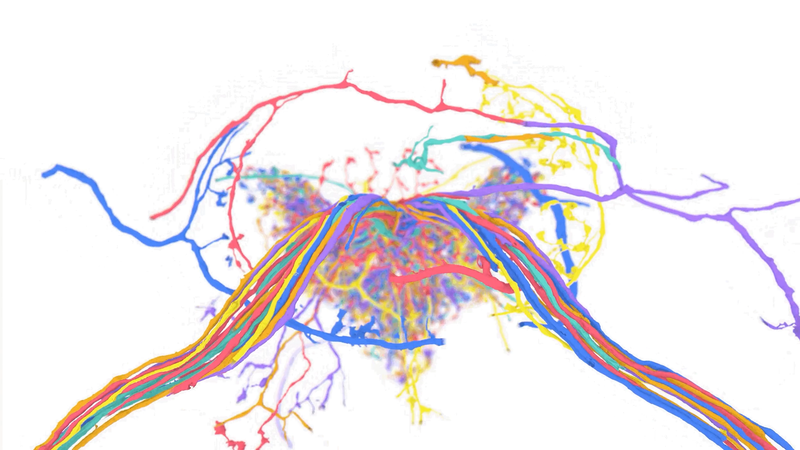
Neural mapping
Google is driving innovation in brain mapping, enabling breakthroughs in neuroscience.
VideoPoet is a language model capable of synthesizing high-quality video and audio from a large variety of conditioning signals.

Green Light
Optimizing traffic lights to reduce vehicle emissions in cities, helping to mitigate climate change and improve urban mobility.

Wildfire detection and prediction
Wildfire modeling and the detection of wildfire boundaries in partnership with fire authorities.

WeatherBench 2
WeatherBench 2 is a benchmark for evaluating the next generation of data-driven, global weather forecasting models.

Project Contrails
Leveraging computer vision to build a cost-effective and scalable method for helping to mitigate aviation’s climate impact.
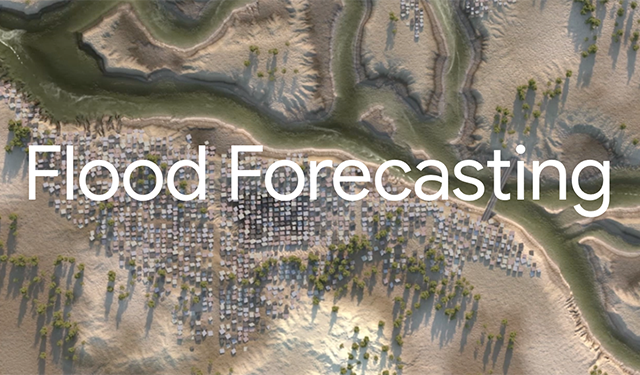
Flood Forecasting
The Flood Forecasting Initiative uses AI to make flood forecasting information universally accessible.
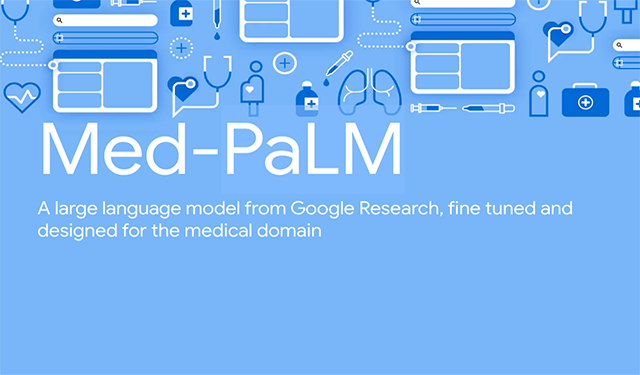
Med-PaLM is a Large Language Model fine-tuned and designed to provide high quality answers to medical questions.

Universal Speech Model (USM)
USM, a family of state-of-the-art speech models with 2B parameters trained on 12M hours (28 billion sentences) of speech, performs automatic speech recognition for 300+ languages.

Project Relate
An Android beta app that uses machine learning to help people with non-standard speech make their voices heard.
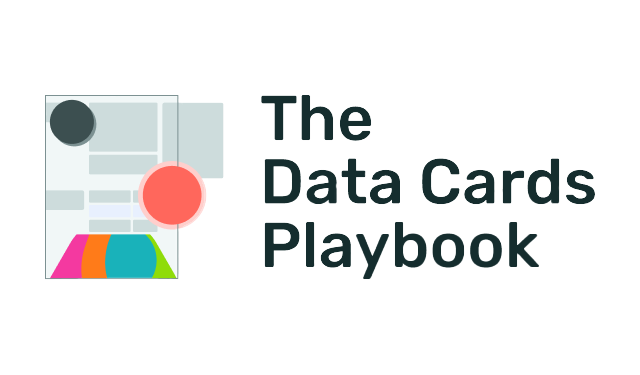
The data cards playbook
A toolkit of activities, frameworks, and guidance for transparency in research dataset documentation. Customizable, participatory methods to create Data Cards templates.

Societal Context Understanding Tools and Solutions (SCOUTS)
Societal Context Understanding Tools and Solutions (SCOUTS) is a Google Research initiative with the mission to provide people and ML systems with the scalable, trustworthy societal context knowledge required to realize responsible and robust AI.
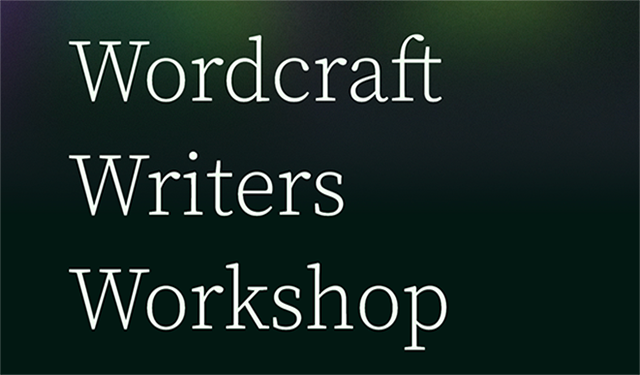
Wordcraft writers workshop
The Wordcraft Writers Workshop explores the limits of co-writing with LaMDA and fosters an honest and earnest conversation about the rapidly changing relationship between technology and creativity.

Realistic video generation of arbitrary length from open-domain textual descriptions.

PaLM-SayCan
A robotics algorithm that combines the understanding of language models with the real-world capabilities of a helper robot.
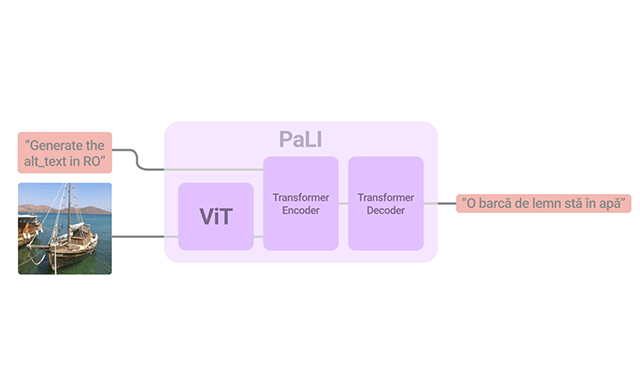
A scalable approach to joint modeling of language and images that reaches new levels of performance in multiple vision-language tasks and multiple languages.
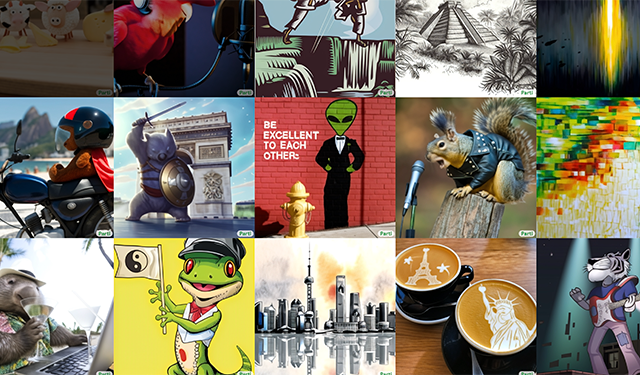
An autoregressive text-to-image generation model that achieves high-fidelity photorealistic image generation and supports content-rich synthesis involving complex compositions and world knowledge.

A text-to-image diffusion model with an unprecedented degree of photorealism and a deep level of language understanding.
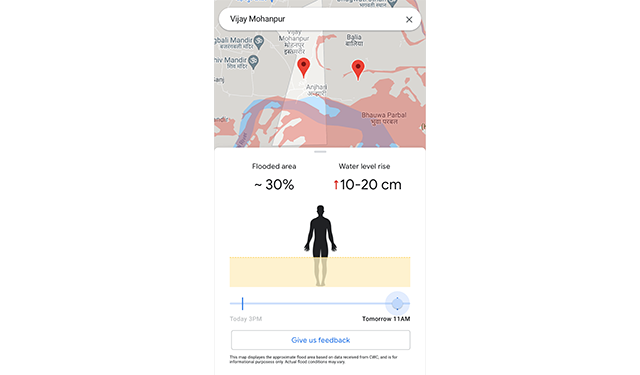
Global flood current and forecast information that is free of charge to help people directly at risk, and to help governments and aid organizations access critical information.

Open buildings
A collection of building footprints to support social good applications. These are useful for a range of applications, from population estimation, urban planning and humanitarian response, to environmental and climate science.
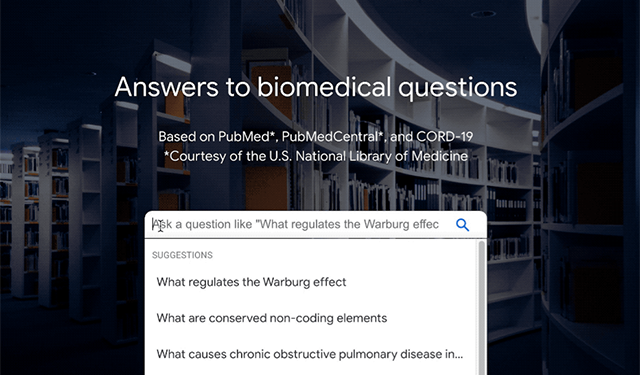
BioMed explorer
A natural language processing-powered search tool to help researchers query PubMed with complex scientific questions.

TPU Research Cloud (TRC)
The TRC program enables researchers to apply for access to a cluster of more than 1,000 Cloud TPUs at no charge to help them accelerate the next wave of research breakthroughs.
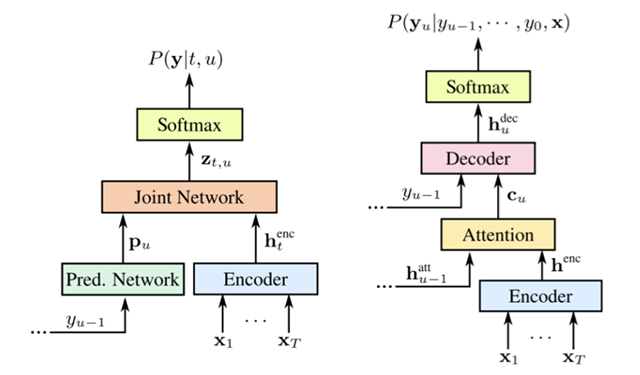
Project Euphonia
Project Euphonia is focused on helping people with non-standard speech be better understood. The approach is centered on analyzing speech recordings to better train speech recognition models.
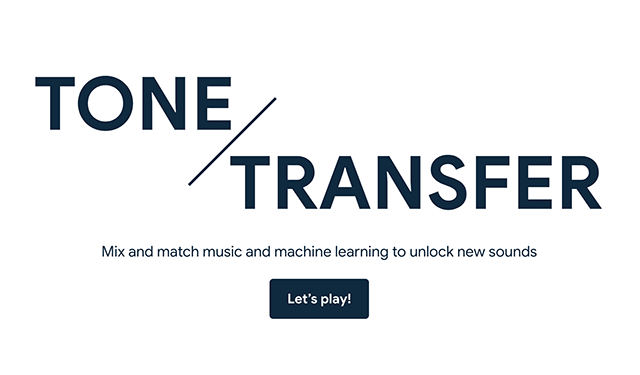
Tone transfer
Mix and match music and machine learning to unlock new sounds.
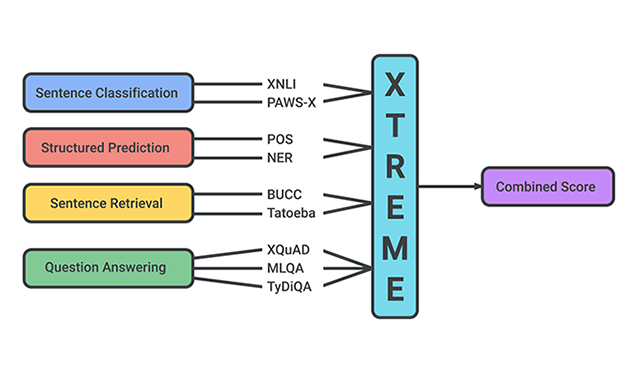
Cross-lingual transfer evaluation of multilingual encoders
A comprehensive benchmark for cross-lingual transfer learning on a varied set of languages and tasks.
Discover our collection of tools and resources
Browse our library of open source projects, public datasets, APIs and more to find the tools you need to tackle your next challenge or fuel your next breakthrough.

Suggestions or feedback?
MIT News | Massachusetts Institute of Technology
- Machine learning
- Social justice
- Black holes
- Classes and programs
Departments
- Aeronautics and Astronautics
- Brain and Cognitive Sciences
- Architecture
- Political Science
- Mechanical Engineering
Centers, Labs, & Programs
- Abdul Latif Jameel Poverty Action Lab (J-PAL)
- Picower Institute for Learning and Memory
- Lincoln Laboratory
- School of Architecture + Planning
- School of Engineering
- School of Humanities, Arts, and Social Sciences
- Sloan School of Management
- School of Science
- MIT Schwarzman College of Computing
MIT’s top research stories of 2021
Press contact :, media download.

*Terms of Use:
Images for download on the MIT News office website are made available to non-commercial entities, press and the general public under a Creative Commons Attribution Non-Commercial No Derivatives license . You may not alter the images provided, other than to crop them to size. A credit line must be used when reproducing images; if one is not provided below, credit the images to "MIT."

Previous image Next image
Despite the pandemic’s disruptions, MIT’s research community still found a way to generate a number of impressive research breakthroughs in 2021. In the spirit of reflection that comes with every new orbit around the sun, below we count down 10 of the most-viewed research stories on MIT News from the past year.
We’ve also rounded up the year’s top MIT community-related stories .
10. Giving cancer treatment a recharge . In October, researchers discovered a way to jump-start the immune system to attack tumors. The method combines chemotherapy and immunotherapy to spur immune cells into action. The researchers hope it could allow immunotherapy to be used against more types of cancer.
9. Generating 3D holograms in real-time . Computer scientists developed a deep-learning-based system that allows computers to create holograms almost instantly. The system could be used to create holograms for virtual reality, 3D printing, medical imaging, and more — and it’s efficient enough to run on a smartphone.
8. Creating inhalable vaccines . Scientists at the Koch Institute developed a method for delivering vaccines directly to the lungs through inhalation. The new strategy induced a strong immune response in the lungs of mice and could offer a quicker response to viruses that infect hosts through mucosal surfaces.
7. Assessing Covid-19 transmission risk . Two MIT professors proposed a new approach to estimating the risks of exposure to Covid-19 in different indoor settings. The guidelines suggest a limit for exposure based on factors such as the size of the space, the number of people, the kinds of activity, whether masks are worn, and ventilation and filtration rates.
6. Teaching machine learning models to adapt . Researchers in CSAIL developed a new type of neural network that can change its underlying equations to continuously adapt to new data. The advance could improve models’ decision-making based on data that changes over time, such as in medical diagnosis and autonomous driving.
5. Programming fibers . In June, a team created the first fabric fiber with digital capabilities. The fibers can sense, store, analyze, and infer data and activity after being sewn into a shirt. The researchers say the fibers could be used to monitor physical performance, to detect diseases, and for a variety of medical purposes.
4. Examining the limitations of data visualizations . A collaboration between anthropologists and computer scientists found that coronavirus skeptics have used sophisticated data visualizations to argue against public health orthodoxy like wearing a mask. The researchers concluded that data visualizations aren’t sufficient to convey the urgency of the Covid-19 pandemic because even the clearest graphs can be interpreted through a variety of belief systems.
3. Developing a Covid-detecting face mask . Engineers at MIT and Harvard University designed a prototype face mask that can diagnose the person wearing the mask with Covid-19 in about 90 minutes. The masks are embedded with tiny, disposable sensors that can be fitted into other face masks and could also be adapted to detect other viruses.
2. Confirming Hawking’s black hole theorem . Using observations of gravitational waves, physicists from MIT and elsewhere confirmed a major theorem created by Stephen Hawking in 1971. The theorem states that the area of a black hole’s event horizon — the boundary beyond which nothing can ever escape — will never shrink.
1. Advancing toward fusion energy . In September, researchers at MIT and the MIT spinout Commonwealth Fusion Systems ramped up a high-temperature superconducting electromagnet to a field strength of 20 tesla, the most powerful magnetic field of its kind ever created on Earth. The demonstration was three years in the making and is believed to resolve one of greatest remaining points of uncertainty in the quest to build the world’s first fusion power plant that produces more energy than it consumes.
Share this news article on:
Related topics.
- MIT Sloan School of Management
- School of Architecture and Planning
- School of Humanities Arts and Social Sciences
Related Articles

MIT community in 2021: A year in review
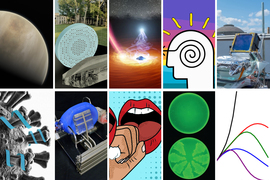
Top MIT research stories of 2020

MIT community in 2020: A year in review

Top MIT research stories of 2019
Previous item Next item
More MIT News
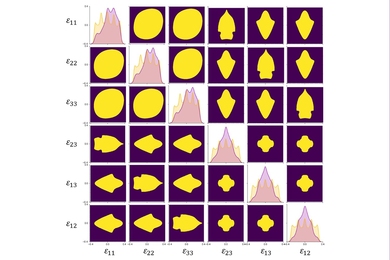
A first-ever complete map for elastic strain engineering
Read full story →

Shining a light on oil fields to make them more sustainable

“Life is short, so aim high”
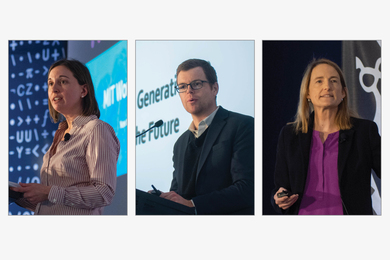
MIT launches Working Group on Generative AI and the Work of the Future

Atmospheric observations in China show rise in emissions of a potent greenhouse gas

Second round of seed grants awarded to MIT scholars studying the impact and applications of generative AI
- More news on MIT News homepage →
Massachusetts Institute of Technology 77 Massachusetts Avenue, Cambridge, MA, USA
- Map (opens in new window)
- Events (opens in new window)
- People (opens in new window)
- Careers (opens in new window)
- Accessibility
- Social Media Hub
- MIT on Facebook
- MIT on YouTube
- MIT on Instagram
- Browse All Articles
- Newsletter Sign-Up
TechnologicalInnovation →
No results found in working knowledge.
- Were any results found in one of the other content buckets on the left?
- Try removing some search filters.
- Use different search filters.

- Previous Article
- Next Article
Promises and Pitfalls of Technology
Politics and privacy, private-sector influence and big tech, state competition and conflict, author biography, how is technology changing the world, and how should the world change technology.
- Split-Screen
- Article contents
- Figures & tables
- Supplementary Data
- Peer Review
- Open the PDF for in another window
- Guest Access
- Get Permissions
- Cite Icon Cite
- Search Site
Josephine Wolff; How Is Technology Changing the World, and How Should the World Change Technology?. Global Perspectives 1 February 2021; 2 (1): 27353. doi: https://doi.org/10.1525/gp.2021.27353
Download citation file:
- Ris (Zotero)
- Reference Manager
Technologies are becoming increasingly complicated and increasingly interconnected. Cars, airplanes, medical devices, financial transactions, and electricity systems all rely on more computer software than they ever have before, making them seem both harder to understand and, in some cases, harder to control. Government and corporate surveillance of individuals and information processing relies largely on digital technologies and artificial intelligence, and therefore involves less human-to-human contact than ever before and more opportunities for biases to be embedded and codified in our technological systems in ways we may not even be able to identify or recognize. Bioengineering advances are opening up new terrain for challenging philosophical, political, and economic questions regarding human-natural relations. Additionally, the management of these large and small devices and systems is increasingly done through the cloud, so that control over them is both very remote and removed from direct human or social control. The study of how to make technologies like artificial intelligence or the Internet of Things “explainable” has become its own area of research because it is so difficult to understand how they work or what is at fault when something goes wrong (Gunning and Aha 2019) .
This growing complexity makes it more difficult than ever—and more imperative than ever—for scholars to probe how technological advancements are altering life around the world in both positive and negative ways and what social, political, and legal tools are needed to help shape the development and design of technology in beneficial directions. This can seem like an impossible task in light of the rapid pace of technological change and the sense that its continued advancement is inevitable, but many countries around the world are only just beginning to take significant steps toward regulating computer technologies and are still in the process of radically rethinking the rules governing global data flows and exchange of technology across borders.
These are exciting times not just for technological development but also for technology policy—our technologies may be more advanced and complicated than ever but so, too, are our understandings of how they can best be leveraged, protected, and even constrained. The structures of technological systems as determined largely by government and institutional policies and those structures have tremendous implications for social organization and agency, ranging from open source, open systems that are highly distributed and decentralized, to those that are tightly controlled and closed, structured according to stricter and more hierarchical models. And just as our understanding of the governance of technology is developing in new and interesting ways, so, too, is our understanding of the social, cultural, environmental, and political dimensions of emerging technologies. We are realizing both the challenges and the importance of mapping out the full range of ways that technology is changing our society, what we want those changes to look like, and what tools we have to try to influence and guide those shifts.
Technology can be a source of tremendous optimism. It can help overcome some of the greatest challenges our society faces, including climate change, famine, and disease. For those who believe in the power of innovation and the promise of creative destruction to advance economic development and lead to better quality of life, technology is a vital economic driver (Schumpeter 1942) . But it can also be a tool of tremendous fear and oppression, embedding biases in automated decision-making processes and information-processing algorithms, exacerbating economic and social inequalities within and between countries to a staggering degree, or creating new weapons and avenues for attack unlike any we have had to face in the past. Scholars have even contended that the emergence of the term technology in the nineteenth and twentieth centuries marked a shift from viewing individual pieces of machinery as a means to achieving political and social progress to the more dangerous, or hazardous, view that larger-scale, more complex technological systems were a semiautonomous form of progress in and of themselves (Marx 2010) . More recently, technologists have sharply criticized what they view as a wave of new Luddites, people intent on slowing the development of technology and turning back the clock on innovation as a means of mitigating the societal impacts of technological change (Marlowe 1970) .
At the heart of fights over new technologies and their resulting global changes are often two conflicting visions of technology: a fundamentally optimistic one that believes humans use it as a tool to achieve greater goals, and a fundamentally pessimistic one that holds that technological systems have reached a point beyond our control. Technology philosophers have argued that neither of these views is wholly accurate and that a purely optimistic or pessimistic view of technology is insufficient to capture the nuances and complexity of our relationship to technology (Oberdiek and Tiles 1995) . Understanding technology and how we can make better decisions about designing, deploying, and refining it requires capturing that nuance and complexity through in-depth analysis of the impacts of different technological advancements and the ways they have played out in all their complicated and controversial messiness across the world.
These impacts are often unpredictable as technologies are adopted in new contexts and come to be used in ways that sometimes diverge significantly from the use cases envisioned by their designers. The internet, designed to help transmit information between computer networks, became a crucial vehicle for commerce, introducing unexpected avenues for crime and financial fraud. Social media platforms like Facebook and Twitter, designed to connect friends and families through sharing photographs and life updates, became focal points of election controversies and political influence. Cryptocurrencies, originally intended as a means of decentralized digital cash, have become a significant environmental hazard as more and more computing resources are devoted to mining these forms of virtual money. One of the crucial challenges in this area is therefore recognizing, documenting, and even anticipating some of these unexpected consequences and providing mechanisms to technologists for how to think through the impacts of their work, as well as possible other paths to different outcomes (Verbeek 2006) . And just as technological innovations can cause unexpected harm, they can also bring about extraordinary benefits—new vaccines and medicines to address global pandemics and save thousands of lives, new sources of energy that can drastically reduce emissions and help combat climate change, new modes of education that can reach people who would otherwise have no access to schooling. Regulating technology therefore requires a careful balance of mitigating risks without overly restricting potentially beneficial innovations.
Nations around the world have taken very different approaches to governing emerging technologies and have adopted a range of different technologies themselves in pursuit of more modern governance structures and processes (Braman 2009) . In Europe, the precautionary principle has guided much more anticipatory regulation aimed at addressing the risks presented by technologies even before they are fully realized. For instance, the European Union’s General Data Protection Regulation focuses on the responsibilities of data controllers and processors to provide individuals with access to their data and information about how that data is being used not just as a means of addressing existing security and privacy threats, such as data breaches, but also to protect against future developments and uses of that data for artificial intelligence and automated decision-making purposes. In Germany, Technische Überwachungsvereine, or TÜVs, perform regular tests and inspections of technological systems to assess and minimize risks over time, as the tech landscape evolves. In the United States, by contrast, there is much greater reliance on litigation and liability regimes to address safety and security failings after-the-fact. These different approaches reflect not just the different legal and regulatory mechanisms and philosophies of different nations but also the different ways those nations prioritize rapid development of the technology industry versus safety, security, and individual control. Typically, governance innovations move much more slowly than technological innovations, and regulations can lag years, or even decades, behind the technologies they aim to govern.
In addition to this varied set of national regulatory approaches, a variety of international and nongovernmental organizations also contribute to the process of developing standards, rules, and norms for new technologies, including the International Organization for Standardization and the International Telecommunication Union. These multilateral and NGO actors play an especially important role in trying to define appropriate boundaries for the use of new technologies by governments as instruments of control for the state.
At the same time that policymakers are under scrutiny both for their decisions about how to regulate technology as well as their decisions about how and when to adopt technologies like facial recognition themselves, technology firms and designers have also come under increasing criticism. Growing recognition that the design of technologies can have far-reaching social and political implications means that there is more pressure on technologists to take into consideration the consequences of their decisions early on in the design process (Vincenti 1993; Winner 1980) . The question of how technologists should incorporate these social dimensions into their design and development processes is an old one, and debate on these issues dates back to the 1970s, but it remains an urgent and often overlooked part of the puzzle because so many of the supposedly systematic mechanisms for assessing the impacts of new technologies in both the private and public sectors are primarily bureaucratic, symbolic processes rather than carrying any real weight or influence.
Technologists are often ill-equipped or unwilling to respond to the sorts of social problems that their creations have—often unwittingly—exacerbated, and instead point to governments and lawmakers to address those problems (Zuckerberg 2019) . But governments often have few incentives to engage in this area. This is because setting clear standards and rules for an ever-evolving technological landscape can be extremely challenging, because enforcement of those rules can be a significant undertaking requiring considerable expertise, and because the tech sector is a major source of jobs and revenue for many countries that may fear losing those benefits if they constrain companies too much. This indicates not just a need for clearer incentives and better policies for both private- and public-sector entities but also a need for new mechanisms whereby the technology development and design process can be influenced and assessed by people with a wider range of experiences and expertise. If we want technologies to be designed with an eye to their impacts, who is responsible for predicting, measuring, and mitigating those impacts throughout the design process? Involving policymakers in that process in a more meaningful way will also require training them to have the analytic and technical capacity to more fully engage with technologists and understand more fully the implications of their decisions.
At the same time that tech companies seem unwilling or unable to rein in their creations, many also fear they wield too much power, in some cases all but replacing governments and international organizations in their ability to make decisions that affect millions of people worldwide and control access to information, platforms, and audiences (Kilovaty 2020) . Regulators around the world have begun considering whether some of these companies have become so powerful that they violate the tenets of antitrust laws, but it can be difficult for governments to identify exactly what those violations are, especially in the context of an industry where the largest players often provide their customers with free services. And the platforms and services developed by tech companies are often wielded most powerfully and dangerously not directly by their private-sector creators and operators but instead by states themselves for widespread misinformation campaigns that serve political purposes (Nye 2018) .
Since the largest private entities in the tech sector operate in many countries, they are often better poised to implement global changes to the technological ecosystem than individual states or regulatory bodies, creating new challenges to existing governance structures and hierarchies. Just as it can be challenging to provide oversight for government use of technologies, so, too, oversight of the biggest tech companies, which have more resources, reach, and power than many nations, can prove to be a daunting task. The rise of network forms of organization and the growing gig economy have added to these challenges, making it even harder for regulators to fully address the breadth of these companies’ operations (Powell 1990) . The private-public partnerships that have emerged around energy, transportation, medical, and cyber technologies further complicate this picture, blurring the line between the public and private sectors and raising critical questions about the role of each in providing critical infrastructure, health care, and security. How can and should private tech companies operating in these different sectors be governed, and what types of influence do they exert over regulators? How feasible are different policy proposals aimed at technological innovation, and what potential unintended consequences might they have?
Conflict between countries has also spilled over significantly into the private sector in recent years, most notably in the case of tensions between the United States and China over which technologies developed in each country will be permitted by the other and which will be purchased by other customers, outside those two countries. Countries competing to develop the best technology is not a new phenomenon, but the current conflicts have major international ramifications and will influence the infrastructure that is installed and used around the world for years to come. Untangling the different factors that feed into these tussles as well as whom they benefit and whom they leave at a disadvantage is crucial for understanding how governments can most effectively foster technological innovation and invention domestically as well as the global consequences of those efforts. As much of the world is forced to choose between buying technology from the United States or from China, how should we understand the long-term impacts of those choices and the options available to people in countries without robust domestic tech industries? Does the global spread of technologies help fuel further innovation in countries with smaller tech markets, or does it reinforce the dominance of the states that are already most prominent in this sector? How can research universities maintain global collaborations and research communities in light of these national competitions, and what role does government research and development spending play in fostering innovation within its own borders and worldwide? How should intellectual property protections evolve to meet the demands of the technology industry, and how can those protections be enforced globally?
These conflicts between countries sometimes appear to challenge the feasibility of truly global technologies and networks that operate across all countries through standardized protocols and design features. Organizations like the International Organization for Standardization, the World Intellectual Property Organization, the United Nations Industrial Development Organization, and many others have tried to harmonize these policies and protocols across different countries for years, but have met with limited success when it comes to resolving the issues of greatest tension and disagreement among nations. For technology to operate in a global environment, there is a need for a much greater degree of coordination among countries and the development of common standards and norms, but governments continue to struggle to agree not just on those norms themselves but even the appropriate venue and processes for developing them. Without greater global cooperation, is it possible to maintain a global network like the internet or to promote the spread of new technologies around the world to address challenges of sustainability? What might help incentivize that cooperation moving forward, and what could new structures and process for governance of global technologies look like? Why has the tech industry’s self-regulation culture persisted? Do the same traditional drivers for public policy, such as politics of harmonization and path dependency in policy-making, still sufficiently explain policy outcomes in this space? As new technologies and their applications spread across the globe in uneven ways, how and when do they create forces of change from unexpected places?
These are some of the questions that we hope to address in the Technology and Global Change section through articles that tackle new dimensions of the global landscape of designing, developing, deploying, and assessing new technologies to address major challenges the world faces. Understanding these processes requires synthesizing knowledge from a range of different fields, including sociology, political science, economics, and history, as well as technical fields such as engineering, climate science, and computer science. A crucial part of understanding how technology has created global change and, in turn, how global changes have influenced the development of new technologies is understanding the technologies themselves in all their richness and complexity—how they work, the limits of what they can do, what they were designed to do, how they are actually used. Just as technologies themselves are becoming more complicated, so are their embeddings and relationships to the larger social, political, and legal contexts in which they exist. Scholars across all disciplines are encouraged to join us in untangling those complexities.
Josephine Wolff is an associate professor of cybersecurity policy at the Fletcher School of Law and Diplomacy at Tufts University. Her book You’ll See This Message When It Is Too Late: The Legal and Economic Aftermath of Cybersecurity Breaches was published by MIT Press in 2018.
Recipient(s) will receive an email with a link to 'How Is Technology Changing the World, and How Should the World Change Technology?' and will not need an account to access the content.
Subject: How Is Technology Changing the World, and How Should the World Change Technology?
(Optional message may have a maximum of 1000 characters.)
Citing articles via
Email alerts, affiliations.
- Special Collections
- Review Symposia
- Info for Authors
- Info for Librarians
- Editorial Team
- Emerging Scholars Forum
- Open Access
- Online ISSN 2575-7350
- Copyright © 2024 The Regents of the University of California. All Rights Reserved.
Stay Informed
Disciplines.
- Ancient World
- Anthropology
- Communication
- Criminology & Criminal Justice
- Film & Media Studies
- Food & Wine
- Browse All Disciplines
- Browse All Courses
- Book Authors
- Booksellers
- Instructions
- Journal Authors
- Journal Editors
- Media & Journalists
- Planned Giving
About UC Press
- Press Releases
- Seasonal Catalog
- Acquisitions Editors
- Customer Service
- Exam/Desk Requests
- Media Inquiries
- Print-Disability
- Rights & Permissions
- UC Press Foundation
- © Copyright 2024 by the Regents of the University of California. All rights reserved. Privacy policy Accessibility
This Feature Is Available To Subscribers Only
Sign In or Create an Account
Digital transformation: a review, synthesis and opportunities for future research
- Open access
- Published: 18 April 2020
- Volume 71 , pages 233–341, ( 2021 )
Cite this article
You have full access to this open access article
- Swen Nadkarni 1 &
- Reinhard Prügl 1
142k Accesses
261 Citations
11 Altmetric
Explore all metrics
In the last years, scholarly attention was on a steady rise leading to a significant increase in the number of papers addressing different technological and organizational aspects of digital transformation. In this paper, we consolidate existing findings which mainly stem from the literature of information systems, map the territory by sharing important macro- and micro-level observations, and propose future research opportunities for this pervasive field. The paper systematically reviews 58 peer-reviewed studies published between 2001 and 2019, dealing with different aspects of digital transformation. Emerging from our review, we develop inductive thematic maps which identify technology and actor as the two aggregate dimensions of digital transformation. For each dimension, we derive further units of analysis (nine core themes in total) which help to disentangle the particularities of digital transformation processes and thereby emphasize the most influential and unique antecedents and consequences. In a second step, in order to assist in breaking down disciplinary silos and strengthen the management perspective, we supplement the resulting state-of-the-art of digital transformation by integrating cross-disciplinary contributions from reviewing 28 papers on technological disruption and 32 papers on corporate entrepreneurship. The review reveals that certain aspects, such as the pace of transformation, the culture and work environment, or the middle management perspective are significantly underdeveloped.
Similar content being viewed by others

Digital Transformation: A Literature Review and Guidelines for Future Research

An Introduction to Digital Transformation

Digital Transformation Framework: A Bibliometric Approach
Avoid common mistakes on your manuscript.
1 Introduction
Digital transformation, defined as transformation ‘concerned with the changes digital technologies can bring about in a company’s business model, … products or organizational structures’ (Hess et al. 2016 , p. 124), is perhaps the most pervasive managerial challenge for incumbent firms of the last and coming decades. However, digital possibilities need to come together with skilled employees and executives in order to reveal its transformative power. Thus, digital transformation needs both technology and people. In the last years, scholarly attention, particularly in the information systems (IS) literature, was on a steady rise leading to a significant increase in the number of papers addressing different technological and organizational aspects of digital transformation. In the light of this development, we are convinced it is the right time to map the territory and reflect on the current state of knowledge. Therefore, in this paper we aim at providing a descriptive, thematic analysis of the field by critically assessing where, how and by whom research on digital transformation is conducted. Based on this analysis, we identify future research opportunities.
We approach this objective in two steps. First, we adopt an inductive approach and conduct a systematic literature review (following Tranfield et al. 2003 ; Webster and Watson 2002 ) of 58 peer-reviewed papers dealing with digital transformation. By applying elements of grounded theory and content analysis (Corley and Gioia 2004 ; Gioia et al. 1994 ) we identify important core themes in the literature that are particularly pronounced and/or unique in transformations enabled by digital technologies. In a second step, in order to assist in breaking down disciplinary silos (Jones and Gatrell 2014 ) and avoiding the building of an ivory tower (Bartunek et al. 2006 ; Fuetsch and Suess-Reyes 2017 ), we supplement the pre-dominantly IS-based digital transformation literature with a broader management perspective. Accordingly, we integrate cross-disciplinary contributions from reviewing 28 papers on technological disruption and 32 papers on corporate entrepreneurship.
We find these research fields particularly suitable for informing digital transformation research for two reasons. First, by reviewing the literature on technological disruption we hope to derive implications regarding technology adoption and integration. Burdened with the legacy of old technology, bureaucratic structures and core rigidities (Leonard-Barton 1992 ), incumbents may face major challenges in this respect during their digital transformation journey. Second, we expect corporate entrepreneurship to add a more holistic perspective on firm-internal aspects during the process of transformation, such as management influence or the impact of knowledge and organizational learning.
Our findings and related contributions are threefold: First, based on a systematic and structured analysis we develop digital transformation maps which inductively categorize and describe the existing body of research. These thematic maps identify technology and actor as the two aggregate dimensions of digital transformation. Within these dimensions, we reveal nine core themes which help to disentangle the particularities of digital transformation processes and thereby emphasize the most influential and unique antecedents and consequences of this specific type of transformation. Thus, it becomes possible to identify the predominant contextual factors for which research would create the strongest leverage for a better understanding of the challenges inherent in digital transformation. Second, we contribute to the advancement of this field by elaborating opportunities for future research on digital transformation which integrate the three perspectives mentioned above. In particular, informed by corporate entrepreneurship, we find that the important middle management perspective on digital transformation has thus far been largely neglected by researchers. Also, emerging from our review we call for more studies on the various options for integrating digital transformation within organizational architectures and existing processes. Third, in reviewing the adjacent literature on technological disruption and corporate entrepreneurship, we strengthen the valuable management perspective within the primarily IS-based discussion on digital transformation. This way we avoid the reinvention of the wheel while at the same time enable the identification of cross-disciplinary research opportunities. We hope to stimulate discussion between these different but strongly related disciplines and enable mutual learning and a fruitful exchange of ideas.
2 Conceptual foundations
Technology as a major determinant of organizational form and structure has been well acknowledged by academics for a long time (Thompson and Bates 1957 ; Woodward 1965 ; Scott 1992 ). Following a significant decline of interest in this relationship until the mid-1990s (Zammuto et al. 2007 ), innovations in information technologies (IT) and the rise of pre-internet technologies have revitalized its relevance in the context of organizational transformation. Thus, the literature on IT-enabled organizational transformation, a concept which originates from the field of information systems (IS) that has caught considerable academic attention starting back in the early 1990s (Ranganathan et al. 2004 ; Besson and Rowe 2012 ), may be seen as one of the scholarly roots of digital transformation research. In his seminal book, Morton ( 1991 ) argued that companies must experience fundamental transformations for effective IT implementation. In the course of the years a shift of attention occurred from technological to managerial and organizational issues (Markus and Benjamin 1997 ; Doherty and King 2005 ). Non-technological aspects such as leadership, culture, and employee training were found to be equally important for successful IT-enabled transformation (Markus 2004 ). This is supported by Orlikowski ( 1996 ) who found empirical evidence from a 2-year case study that organizational transformation was in fact enabled by technology, but not caused by it.
Today, information technologies have become ‘one of the threads from which the fabric of organization is now woven’ (Zammuto et al. 2007 , p. 750). Digital technologies are considered a major asset for leveraging organizational transformation, given their disruptive nature and cross-organizational and systemic effects (Besson and Rowe 2012 ). In order to achieve successful digital transformation, changes must occur at various levels within the organization, including an adaptation of the core business (Karimi and Walter 2015 ), the exchange of resources and capabilities (Cha et al. 2015 ; Yeow et al. 2018 ), the reconfiguration of processes and structures (Resca et al. 2013 ), adjustments in leadership (Hansen and Sia 2015 ; Singh and Hess 2017 ), and the implementation of a vivid digital culture (Llopis et al. 2004 ). Therefore, the scope of our review revolves around digital transformation at the organizational level only (in contrast to implications at the individual level).
In this study, we conceptualize digital transformation at the intercept of the adoption of disruptive digital technologies on the one side and actor-guided organizational transformation of capabilities, structures, processes and business model components on the other side. In other words, and in line with Hess et al. ( 2016 ), we define digital transformation as organizational change triggered by digital technologies. Hence, we argue that two perspectives of digital transformation within organizations must be captured: a technology-centric and an actor-centric perspective. To exploit the technology-centric perspective we include the literature on technological disruption (e.g. Tushman and Anderson 1986 ; Anderson and Tushman 1990 ) and merge it with research on digital transformation. For the actor-centric perspective, we derive essential implications from the field of corporate entrepreneurship (Guth and Ginsberg 1990 ), which we believe may add valuable insights regarding actor-driven innovation and renewal processes within firms. In the following, we offer a brief introduction to both concepts and their relationship with digital transformation.
Rice et al. ( 1998 ) define disruptive innovations as ‘game changers’ which have the potential ‘(1) for a 5–10 times improvement in performance compared to existing products; (2) to create the basis for a 30–50% reduction in costs; or (3) to have new-to-the world performance features’ (p. 52). Similarly, Utterback ( 1994 ) emphasizes this disruptiveness at the firm and industry level and provides a similar ‘game changer’ definition in terms of ‘change that sweeps away much of a firm’s existing investment in technical skills and knowledge, designs, production technique, plant and equipment’ (p. 200). Tushman and Anderson ( 1986 ) distinguish between product and process disruptiveness. Product disruptiveness encompasses new product classes, product substitutions, or fundamental product improvements. Process disruptiveness may take the form of process substitutions or process innovations which radically improve industry-specific dimensions of merit. Christensen and Raynor ( 2003 ) introduce a further form of disruptive innovations, namely disruptive business model innovations, which represent the implementation of fundamentally different business models in an existing business.
We argue that digital technologies may reflect in all of these definitions of disruptive innovation. They may represent new-to-the-world product innovations, dislocate existing processes, and open up entirely new business models. As resumed in a recent study by Li et al. ( 2017 ), e-commerce for instance is defined as a disruptive technology (Johnson 2010 ) which involves significant changes to an organization’s culture, business processes, capabilities, and markets (Zeng et al. 2008 ; Cui and Pan 2015 ).
Corporate entrepreneurship (CE) on the other side is a multi-dimensional concept at the intersection of entrepreneurship and strategic management in existing organizations (Zahra 1996 ; Hitt et al. 2001 ; Dess et al. 2003 ). We adopt the conceptualization proposed by Guth and Ginsberg ( 1990 , p. 5), who argue that corporate entrepreneurship deals with two phenomena ‘(1) the birth of new businesses within existing organizations, i.e. internal innovation or venturing, and (2) the transformation of organizations through renewal of the key ideas on which they are built, i.e. strategic renewal.’ Particularly the aspect of strategic renewal in corporate entrepreneurship, also labelled as strategic change, revival, transformation (Schendel 1990 ), reorganization, redefinition (Zahra 1993 ), or organizational renewal (Stopford and Baden-Fuller 1994 ), provides a promising interface to digital transformation. As stated by Covin and Miles ( 1999 , p. 50), corporate entrepreneurship ‘revitalizes, reinvigorates and reinvents’—processes also required for digital transformation. Various authors have stated that corporate entrepreneurship is a vehicle to improve competitive positioning and transform corporations (Schollhammer 1982 ; Miller 1983 ; Khandwalla 1987 ; Guth and Ginsberg 1990 ; Naman and Slevin 1993 ; Lumpkin and Dess 1996 ). Considering the disruptive nature of many current digital technologies, we believe that organizations need to fundamentally renew and redefine the key ideas of their business in order to fully exploit the potential of digitization and eventually achieve successful transformation. The literature places particular attention on the role of middle managers as the locus of corporate entrepreneurship (Burgelman 1983 , Floyd and Wooldridge 1999 ). Concluding, we will review the research on corporate entrepreneurship and identify those contributions which we believe may offer valuable knowledge regarding actor-driven internal renewal and change processes in the light of digital transformation.
Our review of the literature on digital transformation, technological disruption and corporate entrepreneurship is conducted in a two-step approach. First, we review, analyze and synthesize existing articles on digital transformation. Then, in a second step we supplement these findings be simultaneously reviewing the literature stream on technological disruption and corporate entrepreneurship. We believe a separate analysis and contrasting of the research streams is appropriate for two reasons: first, it provides the reader with more clarity on the status quo of digital transformation knowledge and prevents the confusion of concepts emerging from different literature fields. Second, white spots and opportunities for future research regarding digital transformation become much more visible in such a structured approach.
3 Research methodology
A systematic review is a type of literature review that applies an explicit algorithm and a multi-stage review strategy in order to collect and critically appraise a body of research studies (Mulrow 1994 ; Pittaway et al. 2004 ; Crossan and Apaydin 2010 ). This transparent and reproducible process is ideally suited for analyzing and structuring the vast and heterogeneous literature on digital transformation. In conducting our review, we followed the guidelines of Tranfield et al. ( 2003 ) and the recommendations of Denyer and Neely ( 2004 , p. 133) Footnote 1 as well as Fisch and Block ( 2018 ) in order to ensure a high quality of the review.
The nature of our review is both scoping and descriptive (Rowe 2014 ; Paré et al. 2015 ) as we aim to provide an initial indication of the potential size and nature of the available literature as well as to summarize and map existing findings from digital transformation research. By developing opportunities for future research, our review further contributes to the advancement of this field and stimulates theory development.
For the purpose of data collection, we exclusively limit our focus on peer-reviewed academic journals as recommended by McWilliams et al. ( 2005 ). Thus, we opted to exclude work in progress, conference papers, dissertations, or books. First, based on discussion among the authors and the reading of a few highly-cited papers, we designed our search criteria using combinations of keywords containing ‘ digital* AND transform*’ , ‘ digital* AND disrupt*’ , ‘ digitalization’ , and ‘ digitization ’. Then, we manually searched each issue of each volume of the leading journals in the management Footnote 2 and IS field (AIS Basket of eight). Footnote 3 In addition, we run our search query against five different electronic databases: Business Source Premier (EBSCO) , Scopus , Science Direct , Social Sciences Citation Index (SSCI) , and Google Scholar . We used all years available and only included articles referring to business, management, or economics in order to exclude irrelevant publications. We abstained from including digital innovation in our search (the only exception in our sample is a recent literature review by Kohli and Melville ( 2019 ), in order to capture consolidated insights). Although we realize that it is a hot topic in IS research at the moment (e.g. Fichman et al. 2014 ; Nambisan et al. 2017 ; Yoo et al. 2010 , 2012 ), we aim to concentrate our focus on papers dealing with digital transformation on a broader level (firm and industry), rather than with transitions within innovation management.
Our first search query was conducted mid 2017 and yielded an initial sample of 1722 publications. This very large sample was mainly due to the broad ambiguity of the terms ‘digital’ and ‘disrupt’. Given these broad search parameters, we anticipated that only a small fraction of this very large sample would prove to be of substantive relevance to us. To select these relevant articles for our final sample, we performed a predefined and structured multi-step selection process (similar to the approach of Siebels and Knyphausen-Aufseß 2012 ; Vom Brocke et al. 2015 ) and defined specific criteria for inclusion (Templier and Paré 2015 ). The filters during our selection process included (1) scanning the titles, (2) reading abstracts, (3) removing duplicates, (4) full reading and in-depth analysis of the remaining papers, and finally (5) cross-referencing and backward searching by looking through the bibliographies of the most important articles to find additional relevant work. The initial pool was split in half between two panelists who separately performed the scanning of titles, analysis of abstracts and removal of duplicates. After these early steps, the sample could be narrowed down to 155 articles. As we arrived at step 4 “full reading and in-depth analysis of the remaining papers”, both panelists read and independently classified each of the remaining 155 studies. During this process, papers qualified for the final sample if they satisfied three requirements: (1) articles were required to have their primary focus and contribution within digital transformation research or digitally-induced organizational transformation (e.g. a vast number of papers inadequately captured the topic of digital transformation as they primarily focused on business model innovation), (2) articles needed to be based on a sound theoretical foundation and therefore not primarily practitioner oriented (such as articles that offer popular recommendations to business leaders on how to survive digital transformation), (3) papers that were not addressing digital transformation at an organizational level (e.g. the rise of home-based online businesses by entrepreneurs) were dismissed. Whenever disagreements emerged regarding the inclusion or classification of an article, we engaged in discussion and tried to resolve the issue together to make our selection rules more reliable. We updated the review in the autumn of 2018 for any articles that had appeared between then. Following this approach, 58 studies passed all five selection steps and were included in our final sample.
Within this sample, conceptual articles (27) and case studies (20) are dominant. Roughly 60% of the articles stem from the IS literature, while 40% cover a broader management perspective of digital transformation. While the reviewed papers span a time frame from 2001 to 2018, approximately eighty-percent of articles were published within the past 5 years, indicating the relative novelty of digital transformation as a research discipline. The distribution of our sample according to journals is provided in Table 4 of “ Appendix ”.
Upon the recommendation of Webster and Watson ( 2002 ), our categorization and analysis of the literature was concept-centric. First, to facilitate analysis and build a basis for our initial coding, each selected paper was reviewed to determine the following database information.
(1) Article title, (2) outlet, (3) research methodology, (4) sample, (5) region, and (6) key findings (see full database in Table 5 of “ Appendix ”). Next, we started coding our sample, adopting elements of the approach introduced by Corley and Gioia ( 2004 ). We began by identifying initial concepts in the data and grouping them into provisional categories and first order concepts (open coding). Then, we engaged in axial coding (Locke 2001 ) and searched for relationships and common patterns between and among these provisional categories, which allowed us to assemble them into second order themes. Finally, we assigned these second order themes to aggregate dimensions, representing the highest level of abstraction in our coding. In sum, reviewing and analyzing the extant literature, 194 coded insights were generated within the field of digital transformation: 61 first order concepts, nine second order themes, and two aggregate dimensions. The nine second order themes represent core themes across the papers, which finally constitute two aggregate dimensions: technology and actor. In conclusion, we define digital transformation as actor-driven organizational transformation triggered by the adoption of technology-driven digital disruptions. The result of the coding process is a high-level inductive map of the core themes in digital transformation research (Fig. 1 ).

Digital transformation high-level thematic map emerging from the analysis of the literature
The reviewed studies from our sample provide a rich body of knowledge regarding the specific contextual factors of digital transformation. This may be beneficial to both researchers and practitioners enabling a more comprehensive understanding of the peculiarities of digital transformation (in comparison to previous technology-driven transformations).
4.1 Macro-level findings
On a macro level, the central observation emerging from our review is that both technology- and actor-centric aspects take center stage within this debate. This is also reflected in various definitions of digital transformation provided in the sample. For example, Lanzolla and Anderson ( 2008 ) represent the technology-centric side and emphasize the diffusion of digital technologies as an enabler for transformation. Such digital technologies may include big data, mobile, cloud computing or search-based applications (White 2012 ). Similarly, Hess et al. ( 2016 ) note that digital transformation is ‘concerned with the changes digital technologies can bring about in a company’s business model, which result in changed products or organizational structures or in the automation of processes’ (p. 124). However, Hess et al. ( 2016 ) also highlight the role of actors (e.g. managers) in promoting transformation processes, while facing the challenge of simultaneously balancing the exploration and exploitation of resources. Leaders must have trust in the value and benefits of new IT technologies and support their implementation (Chatterjee et al. 2002 ).
In total, we find an almost even distribution of papers studying the two dimensions of technology and actor: 33% are technology-centric, 34% are actor-centric, and 33% of papers cover both technology and actor. However, within these two dimensions we observe a rather uneven distribution of articles by second order themes. On the technology-centric side, we find that understanding the implications of digital technologies on the consumer interface and market environment are highly active research streams. In comparison, understanding the pace of change in times of digital transformation and its direct impact on incumbents is so far comparably understudied. On the actor-centric side, our review reveals a very dominant focus on leadership and capabilities in a digital context, while in contrast company culture and work environment thus far received less recognition. We also find that the status-quo of digital transformation literature is rather diverse, in a sense that papers discuss topics across various categories of our thematic map and are therefore not restricted nor focused to a specific unit of analysis. The vast majority of articles is related to adjacent topics of digital transformation underpinning its nature as a diverse and broad field of research while again indicating its emerging nature.
In addition, we observe some degree of diversity in the theoretical foundations drawn upon. Different theories are applied by several authors to capture the context of digital transformation, e.g. alignment view, configuration theory, resource-based view, dynamic capabilities, organizational learning theory, network view or business process reengineering. It would be interesting to use other theoretical angles, for example from the literature on corporate entrepreneurship and technological disruption, in order to increase theoretical diversity. Such an exchange with different fields of research would broaden the scope of the field and help bridging an ivory divide . Finally, from a methodological perspective, we observe that actor-centric papers primarily use case studies while technology-centric studies at this point are pre-eminently conceptual. In general, the literature is scarce regarding quantitative empirical evidence. We see this as a strong indicator for the early stage of digital transformation research.
4.2 Micro-level findings: the technology-centric side of the equation
In the following, we present and discuss the most important findings of the second order themes within the technology-centric dimension. In Fig. 2 we provide a thematic map for this dimension and in Table 1 a brief summary including illustrative quotes.
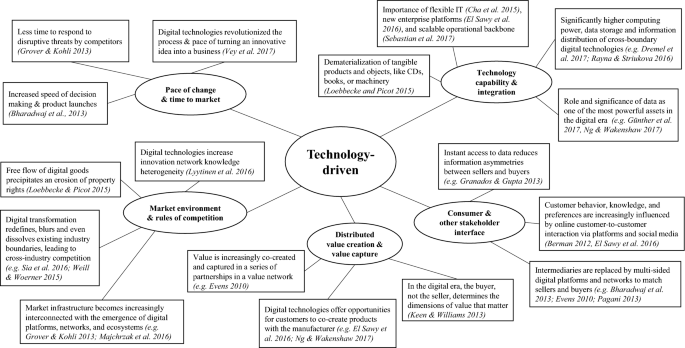
Thematic map for technology-driven themes in digital transformation literature
4.2.1 Pace of change and time to market
In times of digital transformation, the speed of technological change is disproportionally accelerating with new digital capabilities being rolled out every year. The technological capability of applications such as the Internet of Things (IoT), big data, cloud computing, and mobile technologies significantly increases the overall pace of change. For example, entire industries, like the newspaper business, have been transformed and digitized within a very short period of time (Karimi and Walter 2015 ). Further, the cloud and online platforms have revolutionized the process and pace of turning an innovative idea into a business (Vey et al. 2017 ). Today, innovative ideas can be realized within days and companies set-up literally ‘overnight’. In this sense, in the digital world striving for a ‘first-mover advantage’ due to a ‘winner takes it all’ environment has become more important for incumbent firms (Grover and Kohli 2013 ) as they have much less time to respond to such threats and should not give away first-mover advantages too easily.
Moreover, pure digital companies like Facebook, Google or Amazon have substantially raised the overall time to market and speed of product launches (Bharadwaj et al. 2013 ). With continuous improvements in hardware, software and connectivity, these companies set the pace for a tightly timed series of product launches. Thus, firms in the hybrid world (digital and physical) are being put under enormous pressure to also accelerate their product introductions. In a digitally transformed market, the control of speed of product development and launches is increasingly transferred to an ‘ecosystem of innovation’ in the sense of a network of actors with complementary products and services (Bharadwaj et al. 2013 ).
4.2.2 Technology capability and integration
The technological capability and power of digital transformation applications, such as for example the Internet of Things (IoT), big data, cloud computing, and mobile technologies, is in terms of computing power, data storage and information distribution in many cases significantly higher than in previous technology-driven transformations. Earlier business transformations were mostly concerned about introducing internal management information systems such as enterprise resource planning (ERP) or customer relationship management (CRM). These transformations were usually limited to improvements to business processes within firm boundaries (see Ash and Burn 2003 ; Kauffman and Walden 2001 in: Li et al. 2017 ). But today, cross-boundary digital technologies such as IoT devices (Ng and Wakenshaw 2017 ), 3D printing (Rayna and Striukova 2016 ), and big data analytics (Dremel et al. 2017 ), drive transformations that go far beyond internal process optimizations as they potentially induce drastic changes to business models (Rayna and Striukova 2016 ), organizational strategy (Bharadwaj et al. 2013 ), corporate culture (El Sawy et al. 2016 ; Dremel et al. 2017 ; Sia et al. 2016 ), and entire industry structures (Kohli and Johnson 2011 ).
Further, the review confirms that the role and significance of data itself is changing profoundly and that personal data has become one of the most powerful assets in the digital era (Ng and Wakenshaw 2017 ). In fact, we believe the impact of the massive increase in quantity and quality of data generated every day (Bharadwaj et al. 2013 ) and the game changing power of big data analytics (Günther et al. 2017 ) are yet to be fully experienced and understood by society, economy and academics.
With regards to the process of dematerialization of tangible products and objects (e.g. CDs, books, machinery etc.), triggered by the transformative capabilities of digital technologies, the most notable insight is that intriguingly, in many cases the digital substitutes, for example e-books, offer superior performance and higher customer benefits than their physical counterparts (Loebbecke and Picot 2015 ). This, for example, is in contrast to the assumptions provided by Christensen ( 1997 ) more than 20 years ago, arguing that new disruptive technologies usually provide different values from mainstream technologies and are often initially inferior to mainstream technologies, therefore only serving niche markets in the beginning.
Finally, regarding technology integration, the current state of research emphasizes the importance of flexible IT (Cha et al. 2015 ), new enterprise platforms (El Sawy et al. 2016 ), and a strong and scalable operational backbone (Sebastian et al. 2017 ) as part of an agile digital infrastructure. The old paradigms of technology integration are not effective any more. However, in a second step we need to reach a more comprehensive understanding of ‘how’ and ‘where’ the integration of technology and transformation activities should be embedded within the organizational architectures of incumbent firms.
4.2.3 Consumer and other stakeholder interface
With regards to the customer interface, which is currently receiving the highest levels of attention by scholars, we conclude that there is some solid research particularly on changes in consumer behavior (Berman 2012 ; El Sawy et al. 2016 ; Ives et al. 2016 ; Lanzolla and Anderson 2008 ), consumer preferences (Vey et al. 2017 ) and consumer knowledge (Berman 2012 ; Granados and Gupta 2013 ). Firstly, our review confirms that in the new digital marketplace, consumers behave differently than before, and traditional marketing techniques may not apply anymore. Today there are myriad choices to easily gather information about products and services far before the actual purchase. For instance, customer buying decisions are increasingly influenced by online customer-to-customer interaction via platforms and social media, where users share products feedbacks, upload home video clips, or publish blog entries (Berman 2012 ). In this sense, digital technologies are also transforming firms’ customer-side operations (Setia et al. 2013 ) and customer engagement strategies (Sebastian et al. 2017 ). For example, reaching out to customers in a digital environment requires digital omnichannel marketing, including e.g. social media, mobile apps, and augmented reality (El Sawy et al. 2016 ). Secondly, we may note that digital technologies increasingly reduce the information asymmetries between sellers and buyers (Granados and Gupta 2013 ). In this sense, information ubiquity (Vey et al. 2017 ) and instant access to data via mobile technologies (Berman 2012 ) profoundly change the long-established seller–customer relationship. And thirdly, the current literature raises awareness for the emergence of multi-sided business models. While in the ‘old’ world, intermediaries were matching sellers and buyers, in the digital market place, intermediation increasingly takes place through the establishment of multi-sided digital platforms and networks (Bharadwaj et al. 2013 ; Evens 2010 ; Pagani 2013 ).
4.2.4 Distributed value creation and value capture
The review of the literature reveals that the value chain has become far more distributed in times of digital transformation—particularly value creation and value capture. Two major changes can be observed here: (1) digital technologies offer opportunities to customers to co-create products with the manufacturer, e.g. via digital platforms (El Sawy et al. 2016 ; Ng and Wakenshaw 2017 ), and (2) on an inter-firm level value is increasingly co-created and captured in a series of partnerships in a value network (Evens 2010 ). As Bharadwaj et al. ( 2013 ) argue, network effects are the key differentiator and driver of value creation and capture in a digital world. The focus of value creation is therefore shifting from value chain to value networks. For this purpose, companies like Google are experimenting with multi-sided business models. In such a multilayered business model, a company gives away certain products or services in one layer to capture value at a different layer (Bharadwaj et al. 2013 ). Google is giving away its Android operating system for free and captures value via the ability to control advertising on every phone that uses Android.
In more general terms, we may conclude that control of value in the digital world is less and less determined by R&D capabilities, competitors, or industry boundaries. Instead the buyer, not the seller, determines the dimensions of value that matter (Keen and Williams 2013 ). Therefore, businesses need to engage with their customers at every point in the process of value creation (Berman 2012 ). Also, the strong impact of digital technologies on incumbent’s value chains imply some degree of deviation from the classical and often analog core business. For example, new product-related competencies, platform capabilities or value architectures will be required. And, incumbents must prepare for new forms of monetization in the digitized marketplace.
4.2.5 Market environment and rules of competition
This is a rather broad and diverse categorization in our review, as it comprises technology-driven changes in the market environment. After consumer-centric aspects this research stream received the most attention by scholars in the review (on the technology-centric side). In sum, the current state of literature recognizes three major developments. First, digital transformation redefines, blurs and even dissolves existing industry boundaries which may lead to cross-industry competition (Sia et al. 2016 ; Weill and Woerner 2015 ). Dominant industry logics (Sabatier et al. 2012 ) apparently do not work anymore in times of digital transformation. The ‘new kid on the block can come out of the blue’ (Vey et al. 2017 , p. 23) and even individuals can become competitors as 3D Printing is expected to lead to a sharp increase in competition from SMEs and individual entrepreneurs (Rayna and Striukova 2016 ). And with the emergence of multi-sided business models also incumbents are starting to disrupt new markets (Weill and Woerner 2015 ). For instance, Google is disrupting the mobility sector with its self-driving car subsidiary Waymo, while Amazon has introduced AmazonFresh as a grocery delivery service which is seen as a potentially tough competitor to supermarkets. Second, with the emergence of digital platforms, networks, and ecosystems the market infrastructure becomes increasingly interconnected (Grover and Kohli 2013 ; Majchrzak et al. 2016 ; Markus and Loebbecke 2013 ). In a broader sense, we see a shift from controlling or participating in a linear value chain to operating in an ecosystem or network (Weill and Woerner 2015 ). As different types of innovation networks with different cognitive and social translations regarding knowledge emerge, novel properties of digital infrastructure in support of each network are required. Digital technologies therefore increase innovation network knowledge heterogeneity (Lyytinen et al. 2016 ). Third, the free flow of digital goods precipitates an erosion of property rights and higher risks of imitation (Loebbecke and Picot 2015 ).
4.3 Micro-level findings: the actor-centric side of the equation
In the following, we present and discuss the most important findings of the second order themes within the actor-centric dimension. In Fig. 3 we provide a thematic map for this dimension and in Table 2 a brief summary including illustrative quotes.
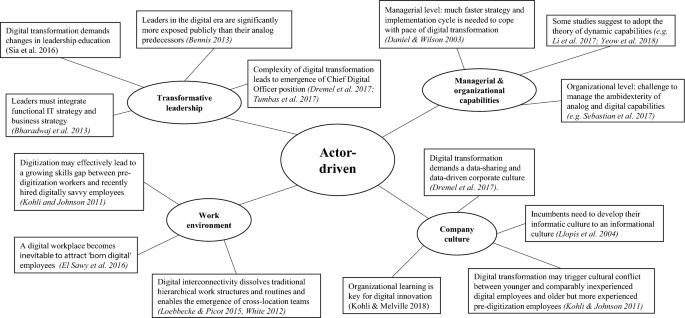
Thematic map for actor-driven themes in digital transformation literature
4.3.1 Transformative leadership
Understanding the impact of digital transformation on leadership and management behavior is a very active and prioritized research focus. In total, 23 papers in our review explore this aspect. First and foremost, research calls for a shift in the traditional view of IT strategy as being subordinate to business strategy (El Sawy et al. 2016 ). In the course of the past two decades information technologies have surpassed their subordinate role as administrative ‘back office’ assets and evolved into an essential element of corporate strategy building. Thus, incumbents should align IT and business strategies on equal terms and fuse them into ‘digital business strategy’ (Bharadwaj et al. 2013 ).
Also, emphasis is placed on the changing nature of leadership itself, caused by digital transformation. Such changes may include rapid optimization of top management decision-making processes enabled by instant access to information and expansive data sets (Mazzei and Noble 2017 ), new communication principles (Bennis 2013 ; Granados and Gupta 2013 ), or changes in leadership education (Sia et al. 2016 ). Further, there is consensus that senior management requires a new digital mindset in order to captain their company’s digital transformation journey. Therefore, incumbents should also rethink their leadership education practices. In the past, leadership programs have been primarily about leadership and communication skills. But in times of digital transformation, executives must become ‘tech visionaries’ and develop their transformative powers. For example, Sia et al. ( 2016 ) have conducted a case study on an Asian bank that uses hackathons to educate their senior managers. Media transparency and exposure are further key challenges of digitization where top managers may require some additional education. Given the ubiquity of information and the speed of online data dissemination (via mobile phones, viral effects of social media etc.), leaders today are significantly more exposed publicly than their analog predecessors. Therefore, according to Bennis ( 2013 ) leadership in the digital era needs to be learned through embracing transparency and adaptive capacity (specifically resilience as the ability to rebound from problems and crisis).
Finally, the vast extent and complexity of digital transformation leads to the emergence of an additional position at the top management level—the Chief Digital Officer (Dremel et al. 2017 ; Tumbas et al. 2017 ). Given the immense challenges of digital transformation and the claim for a new mindset and different skills, CEOs or even CIOs are conceivably not the best match (Singh and Hess 2017 ). Particularly not if they are expected to drive digital transformation in addition to their original tasks.
4.3.2 Managerial and organizational capabilities
Our analysis suggests that in order to effectively drive digital transformation additional and refined capabilities are required—both managerial and organizational (Li et al. 2017 )—in comparison to the analogue world.
At the managerial level, for one thing, a much faster strategy and implementation cycle is needed to cope with the pace of digital transformation (Daniel and Wilson 2003 ). The turbulent and ever-changing digital environment is forcing managers to make decisions and implement strategies significantly faster than they had been previously required to. In order to study managerial capabilities in the context of digital transformation, some studies have adopted the theory of dynamic capabilities (Daniel and Wilson 2003 ; Li et al. 2017 ; Yeow et al. 2018 ) as introduced by Teece et al. ( 1997 ), Teece ( 2007 , 2014 ). In particular, results indicate that dynamic capabilities may support the refinement of digital strategy and are therefore not separate from alignment, but on the contrary have the potential to enact and guide the process of aligning.
At the organizational level, one of the most intriguing challenges for incumbents will be to manage the ambidexterity of capabilities in terms of analog and digital capabilities. Firms need to incorporate ‘old’ and ‘new’ capabilities into their organizational structure in a complementary and not impeding way. In addition, capabilities in two further areas are of particular importance to many firms. First, capabilities to implement and operate in networks (Bharadwaj et al. 2013 ), platforms (Li et al. 2017 ; Sebastian et al. 2017 ), and ecosystems (El Sawy et al. 2016 ; Weill and Woerner 2015 ). Depending on contextual factors like for example their industry or business model, companies must learn to take advantage of network effects in terms of complementary capabilities while also learn how to become more of an ecosystem rather than continue managing value chains. Second, in the digital era it is essential to develop sensing capabilities, such as entrepreneurial alertness and environmental scanning (Kohli and Melville 2019 ), in order to identify new ideas and critically evaluate, design, modify and eventually deliver new business models (Berman 2012 ; Daniel and Wilson 2003 ).
4.3.3 Company culture
Digital transformation is not exclusively a technology-driven challenge but requires deep cultural change. Everyone within the organization must be prepared with an adaptive skill set and digital know-how. Two major insights can be identified within the existing literature. First, digital transformation demands a data-sharing and data-driven corporate culture (Dremel et al. 2017 ). Data as such must be recognized much more as a valuable resource and an enabler to become a digital enterprise. This will require higher operational transparency in daily-business and work-routines and a data-sharing mindset among employees. In this sense, incumbents need to develop their informatic culture to an informational culture (Llopis et al. 2004 ). In comparison to an informatic culture, an informational culture values IT as a core element of strategic and tactical decisions and clearly understands the financial and transformative potential of digital technologies. Second, digital transformation may trigger cultural conflict between younger and comparably inexperienced digital employees and older but more experienced pre-digitization employees (Kohli and Johnson 2011 ). Management is well advised to prevent that two different cultures arise within the same organization—a group of employees who understand digital technologies and those who have a long-standing track record in the traditional business but are technologically lagging behind. Facilitating a learning friendly culture (Kohli and Melville 2019 ) and publicly affirming support and trust by the executive level may effectively mitigate such a potential cultural divide.
4.3.4 Work environment
Our review reveals that digital transformation is changing the daily work environment in incumbent firms in terms of work structures (Hansen and Sia 2015 ; Loebbecke and Picot 2015 ), job roles, and workplace requirements (White 2012 ). For example, digital interconnectivity enables the emergence of flexible and networked cross-location teams across the entire geographical company map. In this context, traditional hierarchical work structures dissolve and new opportunities emerge beyond company boundaries, such as the integration of external freelancers (Loebbecke and Picot 2015 ). Also, the implementation of a digital workplace becomes inevitable. Particularly for ‘born digital’ younger employees a digitally well-equipped workplace may represent a major criterion for their choice of employer (El Sawy et al. 2016 ). According to White ( 2012 ), a digital workplace must be adaptive, compliant, imaginative, predictive, and location-independent.
However, the most notable insight in this perspective is that—in addition to a potential cultural divide—digitization may effectively lead to a growing skills gap between pre-digitization workers and recently hired digitally savvy employees (Kohli and Johnson 2011 ). In fact, while digital technologies significantly help to optimize and accelerate many work processes and thereby increase productivity, incumbents must be aware that many employees might not keep pace with this digital high-speed train and feel left behind. It is unclear how such a tradeoff is considered and how firms could handle related conflicts.
5 Avoiding an ivory tower: drawing on existing knowledge from adjacent research fields
We assume that pre-existing knowledge on corporate transformation processes in general is partly already available and may provide implications for digital transformation. Therefore, at this point in our review, we aim to stimulate a theoretical discussion by identifying potential white spots abstracted from adjacent research fields. For this purpose, we additionally reviewed 28 studies from the literature on technological disruption (to gain technology-centric input) and 32 papers from corporate entrepreneurship (to expand the actor-centric view). By this, we supplement the pre-dominantly IS-based digital transformation literature with a broader management perspective. First, by reviewing the literature on disruptive innovations we hope to derive implications regarding technology adoption and integration. Burdened with the legacy of old technology, bureaucratic structures and core rigidities (Leonard-Barton 1992 ), incumbents may face major challenges in this respect during their digital transformation journey. Second, we expect corporate entrepreneurship to add a more holistic perspective on firm-internal aspects during the process of transformation, such as management contribution or the impact of knowledge and learning.
We rigorously conducted the same review and analysis process as for our digital transformation sample. A database and concept matrix (Webster and Watson 2002 ) for the sample on technological disruption and corporate entrepreneurship are provided in Tables 6 and 7 of “ Appendix ”. The data structures, which summarize the second order themes for both the actor-centric and technology-centric dimension of these additional research fields are illustrated in Figs. 5 and 6 of “ Appendix ”. Within the main body of this article, we only draw attention toward three key implications (Fig. 4 ). In the following, we provide a brief synthesis of these implications and their grounding in the respective literature. In a second step, we transfer and apply these implications to the context of digital transformation and integrate them into an agenda for future research opportunities.
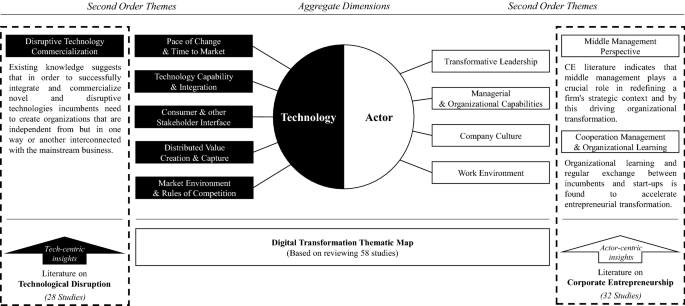
Expanding the digital transformation high-level thematic map with insights from technological disruption and corporate entrepreneurship
5.1 Insights from technological disruption
Existing knowledge from the adoption of disruptive technologies suggests that in order to successfully integrate, commercialize or develop disruptive technologies incumbents need to create organizations that are independent from but interconnected in one way or another with the mainstream business (Bower and Christensen 1995 ). The reasons for this are manifold. For example, managers are encouraged to protect disruptive technologies from the processes and incentives that are targeted to serve established customers. Rather, disruptive innovations should be placed in separate new organizations that work with future customers for this technology (Bower and Christensen 1995 ; Gans 2016 ). Further, separation potentially helps to unravel the discord between viewing disruptive innovations as a threat or an opportunity. Exempted from obligations to a parent company, separate ventures are more likely to perceive a novel technology as an opportunity (Gilbert and Bower 2002 ). And lastly, a freestanding business also enables local adaptation and increased sensitivity to changes in the environment (Hill and Rothaermel 2003 ).
5.2 Insights from corporate entrepreneurship
Our review of the corporate entrepreneurship literature identifies two major implications that have not been (adequately) considered in digital transformation research yet.
First, the literature indicates that middle management plays a crucial role in redefining a firm’s strategic context and by this driving organizational transformation. A middle management perspective has thus far been completely neglected in digital transformation research. We see this as a major gap, since the middle layers of management are ‘where the action is’ (Floyd and Wooldridge 1999 , p. 124). Top management should control the level and the rate of change and ensure that entrepreneurial activities correspond to their strategic vision (Burgelman 1983 ), but middle managers at the implementation level are the driving force and key determinant behind organizational transformation. However, on the downside, middle managers may also represent a major barrier to organizational change (Thornberry 2001 ). Typically, managers have the task to minimize risks, make sure everything is compliant to the rules and perform their functional roles. Thus, middle managers usually have the most to lose from radical changes and are therefore often the least likely to be entrepreneurial or to support transformations (Thornberry 2001 ). In order to solve middle and operational manager’s risk-awareness and unleash their entrepreneurial spirit, research suggests encouraging autonomous behavior (Shimizu 2012 ). In sum, reviewing the literature on corporate entrepreneurship raises our awareness for the impact of hierarchy and management levels on organizational transformation (Hornsby et al. 2009 ).
Second, a closer cooperation and regular exchange between incumbents and start-ups in order to accelerate entrepreneurial transformation is proposed (Engel 2011 ; Kohler 2016 ). Incumbents should recognize start-up companies as a source of external innovation and develop suitable models for collaboration (e.g. corporate accelerators). In particular, incumbents are advised to implement three common best practices from successful start-ups in order to facilitate transformation: (1) working in small omni-functional teams, (2) goal-driven rapid development instead of bureaucratic processes, and (3) field-level exploration of market potential instead of complex and tedious quantitative models (Engel 2011 ). In addition, corporate entrepreneurship underlines the importance of organizational learning as a vehicle to drive and shape cultural transformation (Dess et al. 2003 ; Floyd and Wooldridge 1999 ; Zahra 2015 ). We come to understand that learning, and in fact also knowledge management, are intimately tied to the concept of organizational transformation. A culture of learning and knowledge drives experimentation, encourages the development of an adaptive skill set, reshapes competitive positioning, and opens the minds of employees to new realities (Zahra et al. 1999 ).
6 Opportunities for future research
Based on the cross-disciplinary perspectives from reviewing the literature on digital transformation, technological disruption and corporate entrepreneurship, we propose opportunities for future research on digital transformation. Using our thematic map as a lens to view future research opportunities, we focus on the two dimensions of technology and actor. For the technology-centric dimension we expand on the structural and operational integration of digital technologies and organizational transformation initiatives as well as gaining a deeper understanding of the pace of technological transformation. For the actor-centric dimension we address three topics: we start at the leadership level by emphasizing the relevance of middle management in digital transformation, after that we refer to the potential skills gap and threat of an employee divide in incumbent organizations induced by digital technologies, and finally we move beyond organizational boundaries to turn toward the potential benefits and drawbacks of cooperating with start-ups and pure digital companies to boost transformation. For each area, we propose a set of research questions. Altogether, the agenda is organized around five guiding topics (Table 3 ).
6.1 Integration of digital transformation within organizational structures and activities in incumbent firms
Our review of the literature on digital transformation reveals a knowledge gap regarding this topic. However, we do gain some interesting cross-disciplinary insights from technological disruption at this point. In fact, as already discussed, studies on technological disruption indicate that in order to successfully integrate, commercialize or develop disruptive technologies incumbents need to create organizations that are completely independent from but interconnected in one way or another with the mainstream business (Bower and Christensen 1995 ; Gans 2016 ; Gilbert and Bower 2002 ; Hill and Rothaermel 2003 ).
Thus, the question arises as to how incumbents should incorporate their digital transformation activities. Several options and interesting questions arise in this matter that future research may investigate on:
Which forms of organizational architecture are most suitable for digital transformation? Seamless integration of digital technologies requires building an agile and scalable digital infrastructure that enables continuous scalability of new initiatives (Sia et al. 2016 ). For example, Resca et al. ( 2013 ) suggest a platform-based organization. In addition, digital transformation demands a new kind of enterprise platform integration (El Sawy et al. 2016 ). Given the high intensity of interactive digital connectivity between the outside and inside of a company, traditional enterprise platforms (like ERP) and the ‘old’ supply chain management integration paradigm are in many cases not the most suitable solution anymore. Therefore, flexible IT is a key transformation resource in the digital world (Cha et al. 2015 ). Pursuing an open innovation approach might be another alternative for incumbents.
When and why is it an advantage/disadvantage to start digital transformation in a new organization which is completely independent from traditional business, as suggested by technological disruption research? Under what circumstances and why do spill - over - effects to the parent organization happen/not happen? ? For example, Ravensburger AG , a German toy and jigsaw puzzle company, founded Ravensburger Digital GmbH as a subsidiary in 2009. The purpose of the subsidiary was to become the firm’s digital competence center. In 2017, the digital subsidiary was reincorporated in the parent organization as a digital unit with the goal to apply their digital knowledge to transform the traditional business segments. We call for more qualitative case study research devoted to this question to develop our understanding in this topic.
How, when, and why do incumbents benefit from adopting a ‘let a hundred flowers bloom’ philosophy versus taking a ‘launch, learn, pivot’ approach? In the first scenario, a company would start its digital initiatives across all divisions simultaneously and locally to encourage broad experimentation. Such an approach was adopted by AmerisourceBergen Corp. , an American drug wholesale company. The company is convinced that digital transformation is a matter of culture that needs to be established across the entire organization. For this purpose, it implemented agile project teams throughout the entire enterprise, of which each focused on different aspects. On the downside, companies following such a broad approach may risk losing focus and at some point, the various initiatives may start competing against each other. Hence, we believe it is crucial to have a big picture in mind and accordingly allocate resources and attention very thoughtfully. Alternatively, incumbents may start with a pilot transformation project in a smaller market or subsidiary. Arguably, a major advantage is the opportunity to assure that customers are happy with the transformation results and everything is working out well before starting the large roll out in other markets. And it provides incumbents time to fine-tune their initiatives. For example, American medical company Alcon premiered their initial transformation efforts in Brazil before ramping up their rollout in 27 further countries.
6.2 Pace of digital transformation
The rapid pace of technological change is perhaps the most defining characteristic of digital transformation in distinction to previous IT-enabled transformations. Yet, as this topic is only addressed by four papers in our sample it is still to be studied in more depth. For example, there is consensus among the studies that the pace of change has accelerated significantly, however the parameters that define the pace of change remain yet to be defined. Further, we are informed that some industries like the newspaper business have been digitally transformed within a very short period of time (Karimi and Walter 2015 ), while other branches are still under transformation or are yet to be converted. We posit two exemplary research questions regarding the pace of digital transformation:
What are the parameters that define the pace of change? Our review reveals that the speed of product launches (Bharadwaj et al. 2013 ) and the time it takes to turn an idea into a business (Vey et al. 2017 ) are two potential indicators, but we certainly need to obtain a more comprehensive conceptualization at this point.
Why do industries adopt to digital transformation at a different speed? For example, consider front-runner industries like the media or publishing versus late-comers such as oil and gas. In this specific case, the easiness to dematerialize and digitize the product portfolio is certainly a main reason. However, other industries are less obvious, and we would like to invite future research to investigate upon these conditions. What are the parameters that define whether an industry is more or less transformative?
6.3 The role of middle management in digital transformation
We have learned from our review of the corporate entrepreneurship literature that middle managers are the locus of organizational transformation in incumbent firms (Floyd and Wooldridge 1999 ; Hornsby et al. 2002 , 2009 ; Shimizu 2012 ). While top management controls the level and rate of change, middle managers are in charge of execution (Burgelman 1983 ). Hence, one may conclude that middle managers are the kingpin of digital transformation. Yet, there is not a single paper in our sample that covers a middle management perspective in digital transformation. We believe that this subject has been highly neglected in research to this point and deserves far more attention in future. Several topics are particularly interesting:
How and why is digital transformation affecting the role, tasks and identity of middle managers? How and why do middle managers react to these changes? Based on our review, we expect a deep change in the nature of middle management’s role and influence in a ‘digitally transformed’ company ranging from administration to leadership aspects. Middle managers require a new attitude as they move from directing and controlling stable processes and people at the middle of hierarchy to managing resources and connecting people in the middle of networks. In addition, middle managers in the digital era must step up to their role of supporting, enabling, and coaching people to use the available digital tools. They are expected to facilitate the organization.
What kind of new responsibilities and functions in middle management hierarchy are required to accelerate digital transformation? The odds are that change fatigue might grow on employees and digital transformation may start faltering. For this purpose, horizontal functions such as business-process management layers or central administration platforms may be implemented (McKinsey & Company 2017 ). They could be shared across multiple initiatives within the organization and help to accelerate transformation.
Which mindset and digital literacy do middle managers need to be the driving force behind digital transformation? How, when, and why are middle managers motivated/not motivated to drive transformation? Research on corporate entrepreneurship emphasizes that middle managers are often the least likely to support change as they are inherently risk-averse, hardly entrepreneurial and very attached to their functional routines (Thornberry 2001 ). In addition, middle managers may easily get stressed about their ‘sandwich’ position in-between senior management and the operational level. So how can we expect middle managers to be the speedboat of digital transformation? Also, incumbents need to carefully evaluate the existing digital skills and literacy of their middle managers. How comfortable do they feel with digital tools, social media, the cloud and similar trends? They may not fulfill their coaching and leadership role if they heavily struggle with technology in the first place.
How and why is digital transformation affecting the interface of the top management team (TMT) and middle managers? The relationship between the TMT and middle managers is a very special and important relationship which significantly affects both strategy formulation and the quality of implementation. Middle managers are the organizational ‘linking pins’ between top and operational level and thus heavily rely on a good exchange with their superiors. To what extent and in which ways does digital transformation affect this special leader–follower relationship? How are digital technologies changing the speed and quality of information exchange? What is the impact on the inter-personal level?
What is the impact of digital transformation on the overall importance of the middle management layer? Since the 1950s, research indicates the decline of middle managers in terms of both numbers and influence (Dopson and Stewart 1993 ; Leavitt and Whisler 1958 ; Pinsonneault and Kraemer 1997 ). The shift in emphasis from planning and controlling to speed and flexibility is severely affecting the assumedly ‘slow’ middle. Are middle managers afraid that digital technologies will replace most of their traditional tasks and functions, e.g. communicating and monitoring strategy? Will digitalization naturally empower lower level operational managers at the bottom and consequently eliminate the middle layer?

6.4 A growing skills gap and threat of an employee divide
Given the complexity and explosive pace of digital technologies, there is a threat of a growing skills gap between pre-digitization workers and recently hired digitally savvy employees (Kohli and Johnsons 2011 ). A couple of topics are particularly interesting for future research:
How, when and why are incumbents able/unable to mitigate a growing skills gap and employee divide in the face of digital transformation? Given the increased complexity of digital technologies, traditional IT trainings may not be effective anymore. In a similar vein, how could different levels of knowledge and experience residing within different employees be integrated in the context of digital transformation? Future research might examine the mechanisms required for facilitating or hindering such an integration.
How and when are incumbents able/unable to incorporate ‘old’ and ‘new’ capabilities within their organization? On the one hand firms need to develop new capabilities to continuously transform their business, while on the other hand they must leverage their existing knowledge and skills in order to maintain their existing operations. Thus, for the time of transformation incumbents need to develop multiple, often inconsistent competencies simultaneously. In this context, how do firms ensure not to lose focus while mastering the challenge of ambidexterity in times of digital transformation?
Who in the company is managing the development and transformation of skills (e.g. HR, senior leadership, IT division, functional teams, employees etc .), and how and why does that impact outcomes of digital transformation ? This question is not addressed by current research at all. However, according to a survey (Capgemini Consulting 2013) this lack of alignment with digital strategy is rather worrisome. Responsibilities for skills transformation and development in times of digitization need to be clearly defined and allocated. Empirical academic research in this direction might be helpful to understand the status-quo in incumbent firms regarding this issue.
6.5 Cooperation with startups and pure tech companies to accelerate digital transformation
Corporate entrepreneurship proposes a closer cooperation and regular exchange between incumbents and start-ups in order to accelerate entrepreneurial transformation (Engel 2011 ; Kohler 2016 ). In fact, start-ups are often perceived as the forerunners of digital transformation. They are praised for faster innovation capabilities, higher levels of agility, a culture of risk-taking, and supremely digitized processes and workflows. In contrast, incumbents have more experience, access to capital, established brand trust and a huge customer base. Hence, a cooperation between start-ups and incumbents may be beneficial for both parties. In addition, non-tech incumbents may also consider cooperating with pure digital players which are beyond their start-up phase but are important knowledge carriers in digital matters. Two topics are particularly interesting:
Assuming that successful start - ups have a good digital culture — what are the constituent pillars of such a digital culture? And how could incumbents incorporate these “best practices” and “lessons learned”?
What are the benefits of employee exchange programs with technology companies or start - ups to scale - up digital skills? For example, in early 2008 consumer goods giant Procter and Gamble and Google have been swapping two dozen employees in an effort to foster creativity, exchange thoughts on online advertisement and strengthen their mutual relationship. This program worked very well for both sides.
7 Limitations and conclusion
Our review is not without limitations. First, the specific objectives and nature of our filtering process applied during the review naturally come with a certain selection bias. For example, data collection, analysis and interpretation remain influenced by the subjective assessments of the researchers. Also, despite being the common rule within systematic literature reviews, searching exclusively in peer-reviewed academic journals might have omitted some relevant research contained in books or dissertations. However, by means of a rigorous and transparent search process, an as complete as possible review sample was collected and analyzed subsequently. Second, using a high-level thematic map for such a complex multi-dimensional phenomenon like digital transformation highlights particular connections while it potentially fails to capture others. Specifically, critics may point to the lack of analytical depth within each second order theme. However, we believe that within the limited scope of a review our broad thematic description nevertheless adds value to the advancement of this field and should rather be seen as a holistic starting point for future research to dive deeper into the characteristics of sub-themes of digital transformation. Finally, we are aware that our focus on the organizational level of digital transformation within the private sector does not fully capture the implications of digital transformation for our society, as it also occurs at various other levels, such as the individual level or public sector. As such, future researchers may apply alternative approaches to review and synthesize the existing literature on digital transformation. For example, in contrast to our inductive method to code and analyze our sample, it may also be interesting to apply a more deductive and pre-structured method, in particular when focusing on a deeper understanding of the sub-themes emerging from our analysis. Accordingly, future research could benefit from adopting a phenomenon-based research strategy as proposed by von Krogh et al. ( 2012 ).
Concluding, our paper contributes to the extant discussion by consolidating, mapping and analyze the existing research on digital transformation, sharing important macro- and microlevel observations in the literature and proposing corresponding future research directions. Emerging from our review of 58 studies, we develop a thematic map which identifies technology and actor as the two aggregate dimensions of digital transformation and that elaborates on the predominant contextual concepts (second order themes) within these dimensions. From a macrolevel perspective, we observe that the status-quo of digital transformation literature is rather diverse, in a sense that papers discuss topics across various clusters and concepts. Further, we find some degree of diversity in the theoretical foundations drawn upon as well as confirm that the existing literature in general is scarce regarding quantitative empirical evidence. Another important contribution of our paper is bringing different lenses together by integrating knowledge from related disciplinary areas outside IS management, such as technological disruption and corporate entrepreneurship. With our review, we hope to provide a comprehensive and solid foundation for the on-going discussions on digital transformation and to stimulate future research on this exciting topic.
The development of clear and precise aims and objectives; pre-planned methods; a comprehensive search of all potentially relevant articles; the use of explicit, reproducible criteria in the selection of articles; an appraisal of the quality of the research and the strength of the findings; a synthesis of individual studies using an explicit analytic framework; and a balanced, impartial and comprehensible presentation of the results.
The search included Academy of Management Journal , Administrative Science Quarterly , Entrepreneurship Theory and Practice , Journal of Management Studies , Strategic Management Journal .
The search included European Journal of Information Systems , Information Systems Journal , Information Systems Research , Journal of the Association for Information Systems , Journal of Information Technology , Journal of Management Information Systems , Journal of Strategic Information Systems , MIS Quarterly , MISQ Executive .
Ahuja G, Morris Lampert C (2001) Entrepreneurship in the large corporation: a longitudinal study of how established firms create breakthrough inventions. Strateg Manag J 22:521–543
Google Scholar
Alos-Simo L, Verdu-Jover AJ, Gomez-Gras JM (2017) How transformational leadership facilitates e-business adoption. Ind Manag Data Syst 117:382–397
Anderson P, Tushman ML (1990) Technological discontinuities and dominant designs: a cyclical model of technological change. Adm Sci Q 35:604–633
Ash CG, Burn JM (2003) Assessing the benefits from e-business transformation through effective enterprise management. Eur J Inf Syst 12:297–308
Bartunek JM, Rynes SL, Ireland RD (2006) What makes management research interesting, and why does it matter. Acad Manag J 49:9–15
Bennis W (2013) Leadership in a digital world: embracing transparency and adaptive capacity. MIS Q 37:635–636
Bergek A, Berggren C, Magnusson T, Hobday M (2013) Technological discontinuities and the challenge for incumbent firms: destruction, disruption or creative accumulation? Res Policy 42:1210–1224
Berman SJ (2012) Digital transformation: opportunities to create new business models. Strategy Leadersh 40:16–24
Berman SJ, Davidson S, Ikeda K, Korsten PJ, Marshall A (2016) How successful firms guide innovation: insights and strategies of leading CEOs. Strategy Leadersh 44:21–28
Besson P, Rowe F (2012) Strategizing information systems-enabled organizational transformation: a transdisciplinary review and new directions. J Strateg Inf Syst 21:103–124
Bharadwaj A, El Sawy O, Pavlou P, Venkatraman N (2013) Digital business strategy: toward a next generation of insights. MIS Q 37:471–482
Birkinshaw J (1997) Entrepreneurship in multinational corporations: the characteristics of subsidiary initiatives. Strateg Manag J 18:207–229
Bower JL, Christensen CM (1995) Disruptive technologies: catching the wave. Harv Bus Rev 73:43–53
Burgelman RA (1983) Corporate entrepreneurship and strategic management: insights from a process study. Manag Sci 29:1349–1364
Cha KJ, Hwang T, Gregor S (2015) An integrative model of IT-enabled organizational transformation: a multiple case study. Manag Decis 53:1755–1770
Chatterjee D, Grewal R, Sambamurthy V (2002) Shaping up for e-commerce: institutional enablers of the organizational assimilation of web technologies. MIS Q 26:65–89
Chen J, Nadkarni S (2017) It’s about time! CEOs’ temporal dispositions, temporal leadership, and corporate entrepreneurship. Adm Sci Q 62:31–66
Christensen CM (1997) The innovator’s dilemma. When new technologies cause great firms to fail. Harvard Business School Press, Boston
Christensen CM, Raynor ME (2003) Why hard-nosed executives should care about management theory. Harv Bus Rev 81:66–75
Corbett A, Covin JG, O’Connor GC, Tucci CL (2013) Corporate entrepreneurship: state-of-the-art research and a future research agenda. J Prod Innov Manag 30:812–820
Corley KG, Gioia DA (2004) Identity ambiguity and change in the wake of a corporate spin-off. Adm Sci Q 49:173–208
Covin JG, Miles MP (1999) Corporate entrepreneurship and the pursuit of competitive advantage. Entrepreneursh Theory Pract 23:47–63
Crossan MM, Apaydin M (2010) A multi-dimensional framework of organizational innovation: a systematic review of the literature. J Manag Stud 47:1154–1191
Cui M, Pan SL (2015) Developing focal capabilities for e-commerce adoption: a resource orchestration perspective. Inf Manag 52(2):200–209
Daniel EM, Wilson HN (2003) The role of dynamic capabilities in e-business transformation. Eur J Inf Syst 12:282–296
Danneels E (2004) Disruptive technology reconsidered: a critique and research agenda. J Prod Innov Manag 21:246–258
DaSilva CM, Trkman P, Desouza K, Lindič J (2013) Disruptive technologies: a business model perspective on cloud computing. Technol Anal Strateg Manag 25:1161–1173
Denyer D, Neely A (2004) Introduction to special issue: innovation and productivity performance in the UK. Int J Manag Rev 5:131–135
Dess GG, Ireland RD, Zahra SA, Floyd SW, Janney JJ, Lane PJ (2003) Emerging issues in corporate entrepreneurship. J Manag Stud 29:351–378
Dijkman RM, Sprenkels B, Peeters T, Janssen A (2015) Business models for the Internet of Things. Int J Inf Manag 35(6):672–678
Doherty NF, King M (2005) From technical to socio-technical change: tackling the human and organizational aspects of systems development projects. Eur J Inf Syst 14:1–5
Dopson S, Stewart R (1993) Information technology, organizational restructuring and the future of middle management. New Technol Work Employ 8(1):10–20
Downes L, Nunes P (2013) Big bang disruption. Harv Bus Rev 91:44–56
Dremel C, Wulf J, Herterich MM, Waizmann JC, Brenner W (2017) How AUDI AG established big data analytics in its digital transformation. MIS Q Exec 16(2):81–100
Dushnitsky G, Lenox MJ (2005) When do incumbents learn from entrepreneurial ventures? Corporate venture capital and investing firm innovation rates. Res Policy 34(5):615–639
El Sawy OA, Malhotra A, Park Y, Pavlou PA (2010) Research commentary-seeking the configurations of digital ecodynamics: it takes three to tango. Inf Syst Res 21(4):835–848
El Sawy OA, Kræmmergaard P, Amsinck H, Vinther AL (2016) How LEGO built the foundations and enterprise capabilities for digital leadership. MIS Q Exec 15(2):141–166
Engel JS (2011) Accelerating corporate innovation: lessons from the venture capital model. Res-Technol Manag 54(3):36–43
Evens T (2010) Value networks and changing business models for the digital television industry. J Media Bus Stud 7(4):41–58
Fichman RG, Dos Santos BL, Zheng Z (2014) Digital innovation as a fundamental and powerful concept in the information systems curriculum. MIS Q 38(2):329–A15
Fisch C, Block J (2018) Six tips for your (systematic) literature review in business and management research. Manag Rev Q 68:103–106
Floyd SW, Wooldridge B (1999) Knowledge creation and social networks in corporate entrepreneurship: the renewal of organizational capability. Entrepreneursh Theory Pract 23(3):123–144
Fuetsch E, Suess-Reyes J (2017) Research on innovation in family businesses: are we building an ivory tower? J Fam Bus Manag 7(1):44–92
Gans JS (2016) Keep calm and manage disruption. MIT Sloan Manag Rev 57(3):83–90
Gawer A, Cusumano MA (2014) Industry platforms and ecosystem innovation. J Prod Inov Manag 31(3):417–433
Gerstner WC, König A, Enders A, Hambrick DC (2013) CEO narcissism, audience engagement, and organizational adoption of technological discontinuities. Adm Sci Q 58(2):257–291
Gerth AB, Peppard J (2016) The dynamics of CIO derailment: how CIOs come undone and how to avoid it. Bus Horiz 59(1):61–70
Gilbert C, Bower JL (2002) Disruptive change. When trying harder is part of the problem. Harv Bus Rev 80(5):94–101
Gioia DA, Thomas JB, Clark SM, Chittipeddi K (1994) Symbolism and strategic change in academia: the dynamics of sensemaking and influence. Org Sci 5(3):363–383
Granados N, Gupta A (2013) Transparency strategy: competing with information in a digital world. MIS Q 37(2):637–641
Grover V, Kohli R (2013) Revealing your hand: caveats in implementing digital business strategy. MIS Q 37(2):655–662
Günther WA, Mehrizi MHR, Huysman M, Feldberg F (2017) Debating big data: a literature review on realizing value from big data. J Strateg Inf Syst 26:191–209
Günzel F, Holm AB (2013) One size does not fit all—understanding the front-end and back-end of business model innovation. Int J Innov Manag 17(1):1340002-1–1340002-34
Guth WD, Ginsberg A (1990) Guest editors’ introduction: corporate entrepreneurship. Strateg Manag J 11:5–15
Habtay SR, Holmén M (2014) Incumbents’ responses to disruptive business model innovation: the moderating role of technology vs. market-driven innovation. Int J Entrep Innov Manag 18(4):289–309
Hagberg J, Sundstrom M, Egels-Zandén N (2016) The digitalization of retailing: an exploratory framework. Int J Retail Distrib Manag 44(7):694–712
Hansen R, Sia SK (2015) Hummel’s digital transformation toward omnichannel retailing: key lessons learned. MIS Q Exec 14(2):51–66
Hess T, Matt C, Benlian A, Wiesböck F (2016) Options for formulating a digital transformation strategy. MIS Q Exec 15(2):123–139
Hill CW, Rothaermel FT (2003) The performance of incumbent firms in the face of radical technological innovation. Acad Manag Rev 28(2):257–274
Hitt M, Ireland R, Camp S, Sexton D (2001) Strategic entrepreneurship: entrepreneurial strategies for wealth creation. Strateg Manag J 22:479–491
Holm AB, Günzel F, Ulhøi JP (2013) Openness in innovation and business models: lessons from the newspaper industry. Int J Technol Manag 61(3/4):324–348
Hornsby JS, Kuratko DF, Zahra SA (2002) Middle managers’ perception of the internal environment for corporate entrepreneurship: assessing a measurement scale. J Bus Vent 17(3):253–273
Hornsby JS, Kuratko DF, Shepherd DA, Bott JP (2009) Managers’ corporate entrepreneurial actions: examining perception and position. J Bus Ventur 24(3):236–247
Hu H, Huang T, Zeng Q, Zhang S (2016) The role of institutional entrepreneurship in building digital ecosystem: a case study of Red Collar Group (RCG). Int J Inf Manag 36(3):496–499
Ireland RD, Covin JG, Kuratko DF (2009) Conceptualizing corporate entrepreneurship strategy. Entrepreneursh Theory Pract 33(1):19–46
Ives B, Palese B, Rodriguez JA (2016) Enhancing customer service through the internet of things and digital data streams. MIS Q Exec 15(4):279–297
Johnson M (2010) Barriers to innovation adoption: a study of e-markets. Ind Manag Data Syst 110(2):157–174
Johnson MW, Christensen CM, Kagermann H (2008) Reinventing your business model. Harv Bus Rev 86(12):50–59
Jones O, Gatrell C (2014) Editorial: the future of writing and reviewing for IJMR. Int J Manag Rev 16(3):249–264
Karimi J, Walter Z (2015) The role of dynamic capabilities in responding to digital disruption: a factor-based study of the newspaper industry. J Manag Inf Syst 32(1):39–81
Karimi J, Walter Z (2016) Corporate entrepreneurship, disruptive business model innovation adoption, and its performance: the case of the newspaper industry. Long Range Plan 49(3):342–360
Kauffman RJ, Walden EA (2001) Economics and electronic commerce: survey and directions for research. Int J Electric Commun 5(4):5–116
Keen P, Williams R (2013) Value architectures for digital business: beyond the business model. MIS Q 37(2):643–648
Khandwalla PN (1987) Generators of pioneering-innovative management: some Indian evidence. Org Stud 8(1):39–59
Koen PA, Bertels H, Elsum IR, Orroth M, Tollett BL (2010) Breakthrough innovation dilemmas. Res Technol Manag 53(6):48–51
Kohler T (2016) Corporate accelerators: building bridges between corporations and startups. Bus Horiz 59(3):347–357
Kohli R, Johnson S (2011) Digital transformation in latecomer industries: CIO and CEO Leadership Lessons from Encana Oil and Gas (USA) Inc. MIS Q Exec 10(4):141–156
Kohli R, Melville NP (2019) Digital innovation: a review and synthesis. Inf Syst J 29(1):200–223
Kuratko DF, Covin JG, Hornsby JS (2014) Why implementing corporate innovation is so difficult. Bus Horiz 57(5):647–655
Lant TK, Mezias SJ (1990) Managing discontinuous change: a simulation study of organizational learning and entrepreneurship. Strateg Manag J 11:147–179
Lanzolla G, Anderson J (2008) Digital transformation. Bus Strateg Rev 19(2):72–76
Lavie D (2006) Capability reconfiguration: an analysis of incumbent responses to technological change. Acad Manag Rev 31(1):153–174
Leavitt HJ, Whisler TL (1958) Management in the 1980’s. In: Technology, organizations and innovation. London and New York, pp 41–48
Leonard-Barton D (1992) Core capabilities and core rigidities: a paradox in managing new product development. Strateg Manag J 13(S1):111–125
Leong C, Tan B, Xiao X, Tan FTC, Sun Y (2017) Nurturing a FinTech ecosystem: the case of a youth microloan startup in China. Int J Inf Manag 37(2):92–97
Li L, Su F, Zhang W, Mao JY (2017) Digital transformation by SME entrepreneurs: a capability perspective. Inf Sys J 28(6):1129–1157
Ling YAN, Simsek Z, Lubatkin MH, Veiga JF (2008) Transformational leadership’s role in promoting corporate entrepreneurship: examining the CEO-TMT interface. Acad Manag J 51(3):557–576
Liu DY, Chen SW, Chou TC (2011) Resource fit in digital transformation: lessons learned from the CBC Bank global e-banking project. Manag Decis 49(10):1728–1742
Llopis J, Gonzalez MR, Gasco JL (2004) Transforming the firm for the digital era: an organizational effort towards an E-culture. Hum Syst Manag 23(4):213–225
Locke K (2001) Grounded theory in management research. Sage, London
Loebbecke C, Picot A (2015) Reflections on societal and business model transformation arising from digitization and big data analytics: a research agenda. J Strateg Inf Syst 24(3):149–157
Lucas HC Jr, Goh JM (2009) Disruptive technology: how Kodak missed the digital photography revolution. J Strateg Inf Syst 18(1):46–55
Lumpkin GT, Dess GG (1996) Clarifying the entrepreneurial orientation construct and linking it to performance. Acad Manag J 2(1):135–172
Lyytinen K, Yoo Y, Boland RJ Jr (2016) Digital product innovation within four classes of innovation networks. Inf Sys J 26(1):47–75
Majchrzak A, Markus ML, Wareham J (2016) Designing for digital transformation: lessons for information systems research from the study of ICT and societal challenges. MIS Q 40(2):267–277
Marion T, Dunlap D, Friar J (2012) Instilling the entrepreneurial spirit in your RandD team: what large firms can learn from successful start-ups. IEEE Trans Eng Manag 59(2):323–337
Markus ML (2004) Technochange management: using IT to drive organizational change. J Inf Technol 19(1):4–20
Markus ML, Benjamin RI (1997) The magic bullet theory in IT-enabled transformation. Sloan Manag Rev 38:55–68
Markus ML, Loebbecke C (2013) Commoditized digital processes and business community platforms: new opportunities and challenges for digital business strategies. MIS Q 37(2):649–654
Matt C, Hess T, Benlian A (2015) Digital transformation strategies. Bus Inf Syst Eng 57(5):339–343
Mazzei MJ, Noble D (2017) Big data dreams: a framework for corporate strategy. Bus Horiz 60(3):405–414
McKinsey & Company (2017) A CEO guide for avoiding the ten traps that derail digital transformations. Digital McKinsey. https://www.mckinsey.com/business-functions/digital-mckinsey/our-insights/a-ceo-guide-for-avoiding-the-ten-traps-that-derail-digital-transformations . Accessed 28 July 2018
McWilliams A, Siegel D, Van Fleet DD (2005) Scholarly journals as producers of knowledge: theory and empirical evidence based on data envelopment analysis. Organ Res Methods 8:185–201
Meyer AD, Brooks GR, Goes JB (1990) Environmental jolts and industry revolutions: organizational responses to discontinuous change. Strateg Manag J 11:93–110
Miller D (1983) The correlates of entrepreneurship in three types of firms. Manag Sci 29:770–791
Mithas S, Tafti A, Mitchell W (2013) How a firm’s competitive environment and digital strategic posture influence digital business strategy. MIS Q 37(2):511–536
Moreau F (2013) The disruptive nature of digitization: the case of the recorded music industry. Int J Arts Manag 15(2):18–31
Morton MS (1991) The corporation of the 1990s: information technology and organizational transformation. Oxford University Press, New York
Mulrow CD (1994) Systematic reviews: rationale for systematic reviews. Br Manag J 309:597–599
Naman JL, Slevin DP (1993) Entrepreneurship and the concept of fit: a model and empirical tests. Strateg Manag J 14:137–153
Nambisan S, Lyytinen K, Majchrzak A, Song M (2017) Digital innovation management: reinventing innovation management research in a digital world. MIS Q 41(1):223–238. https://doi.org/10.25300/MISQ/2017/41:1.03
Nason RS, McKelvie A, Lumpkin GT (2015) The role of organizational size in the heterogeneous nature of corporate entrepreneurship. Small Bus Econ 45(2):279–304
Ng IC, Wakenshaw SY (2017) The Internet-of-Things: review and research directions. Int J Res Market 34(1):3–21
Obal M (2013) Why do incumbents sometimes succeed? Investigating the role of interorganizational trust on the adoption of disruptive technology. Ind Market Manag 42(6):900–908
Orlikowski WJ (1996) Improvising organizational transformation over time: a situated change perspective. Inf Syst Res 7(1):63–92
Pagani M (2013) Digital business strategy and value creation: framing the dynamic cycle of control points. MIS Q 37(2):617–632
Paré G, Trudel MC, Jaana M, Kitsiou S (2015) Synthesizing information systems knowledge: a typology of literature reviews. Inf Manag 52(2):183–199
Peltola S (2012) Can an old firm learn new tricks? A corporate entrepreneurship approach to organizational renewal. Bus Horiz 55(1):43–51
Pinsonneault A, Kraemer KL (1997) Middle management downsizing: an empirical investigation of the impact of information technology. Manag Sci 43(5):659–679
Pittaway L, Robertson M, Munir K, Denyer D, Neely A (2004) Networking and innovation: a systematic review of the evidence. Int J Manag Rev 5:137–168
Ranganathan C, Watson-Manheim MB, Keeler J (2004) Bringing professionals on board: lessons on executing IT-enabled organizational transformation. MIS Q Exec 3(3):151–160
Rayna T, Striukova L (2016) From rapid prototyping to home fabrication: how 3D printing is changing business model innovation. Technol Forecast Soc Change 102:214–224
Resca A, Za S, Spagnoletti P (2013) Digital platforms as sources for organizational and strategic transformation: a case study of the Midblue project. J Theor Appl Electron Commer Res 8(2):71–84
Rice MP, O’Connor GC, Peters LS, Morone JG (1998) Managing discontinuous innovation. Res-Technol Manag 41(3):52–58
Rigby DK, Sutherland J, Takeuchi H (2016) Embracing agile. Harv Bus Rev 94(5):40–50
Rindova VP, Kotha S (2001) Continuous “morphing”: competing through dynamic capabilities, form, and function. Acad Manag J 44(6):1263–1280
Rowe F (2014) What literature review is not: diversity, boundaries and recommendations. Eur J Inf Syst 23(3):241–255
Roy R, Sarkar MB (2016) Knowledge, firm boundaries, and innovation: mitigating the incumbent’s curse during radical technological change. Strateg Manag J 37(5):835–854
Sabatier V, Craig-Kennard A, Mangematin V (2012) When technological discontinuities and disruptive business models challenge dominant industry logics: insights from the drugs industry. Technol Forecast Soc Change 79(5):949–962
Sambamurthy V, Bharadwaj A, Grover V (2003) Shaping agility through digital options: reconceptualizing the role of information technology in contemporary firms. MIS Q 27(2):237–263
Sandström CG (2016) The non-disruptive emergence of an ecosystem for 3D Printing—insights from the hearing aid industry’s transition 1989–2008. Technol Forecast Soc Change 102:160–168
Schendel D (1990) Introduction to the special issue on corporate entrepreneurship. Strateg Manag J 11:1–3
Schollhammer H (1982) Internal corporate entrepreneurship. In: Kent CA, Sexton DL, Vesper KH (eds) Encyclopedia of entrepreneurship. Prentice Hall, Englewood Cliffs, pp 209–229
Schuchmann D, Seufert S (2015) Corporate learning in times of digital transformation: a conceptual framework and service portfolio for the learning function in banking organisations. Int J Adv Corp Learn 8(1):31–39
Scott WR (1992) Organizations rational, natural, and open systems. Prentice Hall, Englewood Cliffs
Sebastian IM, Ross JW, Beath C, Mocker M, Moloney KG, Fonstad NO (2017) How big old companies navigate digital transformation. MIS Q Exec 16(3):197–213
Setia P, Venkatesh V, Joglekar S (2013) Leveraging digital technologies: How information quality leads to localized capabilities and customer service performance. MIS Q 37(2):565–590
Seufert S, Meier C (2016) From eLearning to digital transformation: a framework and implications for LandD. Int J Adv Corp Learn 9(2):27–33
Shaughnessy H (2016) Harnessing platform-based business models to power disruptive innovation. Strategy Leadersh 44(5):6–14
Shimizu K (2012) Risks of corporate entrepreneurship: autonomy and agency issues. Org Sci 23(1):194–206
Sia SK, Soh C, Weill P (2016) How DBS bank pursued a digital business strategy. MIS Q Exec 15(2):105–121
Siebels J, Knyphausen-Aufseß D (2012) A review of theory in family business research: the implications for corporate governance. Int J Manag Rev 14:280–304
Singh A, Hess T (2017) How chief digital officers promote the digital transformation of their companies. MIS Q Exec 16(1):1–17
Stopford JM, Baden-Fuller CW (1994) Creating corporate entrepreneurship. Strateg Manag J 15(7):521–536
Svahn F, Mathiassen L, Lindgren R (2017) Embracing digital innovation in incumbent firms: how Volvo cars managed competing concerns. MIS Q 41(1):239–253
Teece DJ (2007) Explicating dynamic capabilities: the nature and microfoundations of (sustainable) enterprise performance. Strateg Manag J 28(13):1319–1350
Teece DJ (2014) A dynamic capabilities-based entrepreneurial theory of the multinational enterprise. J Int Bus Stud 45(1):8–37
Teece DJ, Pisano G, Shuen A (1997) Dynamic capabilities and strategic management. Strateg Manag J 18(7):509–533
Templier M, Paré G (2015) A framework for guiding and evaluating literature reviews. Commun Assoc Inf Syst 37:112–137
Thompson JD, Bates FL (1957) Technology, organization, and administration. Adm Sci Q 2:325–342
Thornberry N (2001) Corporate entrepreneurship: antidote or oxymoron? Eur Manag J 19(5):526–533
Tongur S, Engwall M (2014) The business model dilemma of technology shifts. Technovation 34(9):525–535
Tranfield D, Denyer D, Smart P (2003) Towards a methodology for developing evidence-informed management knowledge by means of systematic review. Br J Manag 14(3):207–222
Tumbas S, Berente N, vom Brocke J (2017) Three types of chief digital officers and the reasons organizations adopt the role. MIS Q Exec 16(2):121–134
Turner T, Pennington WW (2015) Organizational networks and the process of corporate entrepreneurship: how the motivation, opportunity, and ability to act affect firm knowledge, learning, and innovation. Small Bus Econ 45(2):447–463
Turró A, Urbano D, Peris-Ortiz M (2014) Culture and innovation: the moderating effect of cultural values on corporate entrepreneurship. Technol Forecast Soc Change 88:360–369
Tushman ML, Anderson P (1986) Technological discontinuities and organizational environments. Adm Sci Q 31:439–465
Urbano D, Turró A (2013) Conditioning factors for corporate entrepreneurship: an in (ex)ternal approach. Int Entrep Manag J 9(3):379–396
Utterback JM (1994) Mastering the dynamics of innovation. Harvard Business School Press, Boston
Vecchiato R (2017) Disruptive innovation, managerial cognition, and technology competition outcomes. Technol Forecast Soc Change 116:116–128
Vey K, Fandel-Meyer T, Zipp JS, Schneider C (2017) Learning and development in times of digital transformation: facilitating a culture of change and innovation. Int J Adv Corp Learn 10(1):22–32
Vom Brocke J, Simons A, Riemer K, Niehaves B, Plattfaut R, Cleven A (2015) Standing on the shoulders of giants: challenges and recommendations of literature search in information systems research. Commun Assoc Inf Syst 37(1):9
von Krogh G, Rossi-Lamastra C, Haefliger S (2012) Phenomenon-based research in management and organisation science: when is it rigorous and does it matter? Long Range Plan 45(4):277–298
von Pechmann F, Midler C, Maniak R, Charue-Duboc F (2015) Managing systemic and disruptive innovation: lessons from the Renault Zero Emission Initiative. Ind Corp Change 24(3):677–695
Webster J, Watson RT (2002) Analyzing the past to prepare for the future: writing a literature review. MIS Q 26(2)::xiii–xxiii
Weill P, Woerner SL (2015) Thriving in an increasingly digital ecosystem. MIT Sloan Manag Rev 56(4):27–34
White M (2012) Digital workplaces: vision and reality. Bus Inf Rev 29(4):205–214
Woodward J (1965) Industrial organization theory and practice. Oxford University Press, New York
Yeow A, Soh C, Hansen R (2018) Aligning with new digital strategy: a dynamic capabilities approach. J Strateg Inf Syst 27(1):43–58
Yoo Y, Henfridsson O, Lyytinen K (2010) Research commentary—the new organizing logic of digital innovation: an agenda for information systems research. Inf Syst Res 21(4):724–735
Yoo Y, Boland RJ Jr, Lyytinen K, Majchrzak A (2012) Organizing for innovation in the digitized world. Organ Sci 23(5):1398–1408
Yu D, Hang CC (2010) A reflective review of disruptive innovation theory. Int J Manag Rev 12(4):435–452
Zahra SA (1993) A conceptual model of entrepreneurship as firm behavior: a critique and extension. Entrepreneursh Theory Pract 17(4):5–21
Zahra SA (1996) Goverance, ownership, and corporate entrepreneurship: the moderating impact of industry technological opportunities. Acad Manag J 39(6):1713–1735
Zahra SA (2015) Corporate entrepreneurship as knowledge creation and conversion: the role of entrepreneurial hubs. Small Bus Econ 44(4):727–735
Zahra SA, Covin JG (1995) Contextual influences on the corporate entrepreneurship–performance relationship: a longitudinal analysis. J Bus Ventur 10(1):43–58
Zahra SA, Nielsen AP, Bogner WC (1999) Corporate entrepreneurship, knowledge, and competence development. Entrepreneursh Theory Pract 23(3):169–189
Zammuto RF, Griffith TL, Majchrzak A, Dougherty DJ, Faraj S (2007) Information technology and the changing fabric of organization. Org Sci 18(5):749–762
Zeng Q, Chen W, Huang L (2008) E-business transformation: an analysis framework based on critical organizational dimensions. Tsinghua Sci Technol 13(3):408–413
Download references
Acknowledgements
Open Access funding provided by Projekt DEAL.
Author information
Authors and affiliations.
Chair of Innovation, Technology & Entrepreneurship, Zeppelin University, Am Seemooser Horn 20, 88045, Friedrichshafen, Germany
Swen Nadkarni & Reinhard Prügl
You can also search for this author in PubMed Google Scholar
Corresponding author
Correspondence to Swen Nadkarni .
Additional information
Publisher's note.
Springer Nature remains neutral with regard to jurisdictional claims in published maps and institutional affiliations
See Tables 4 , 5 , 6 and 7 and Figs. 5 and 6 .
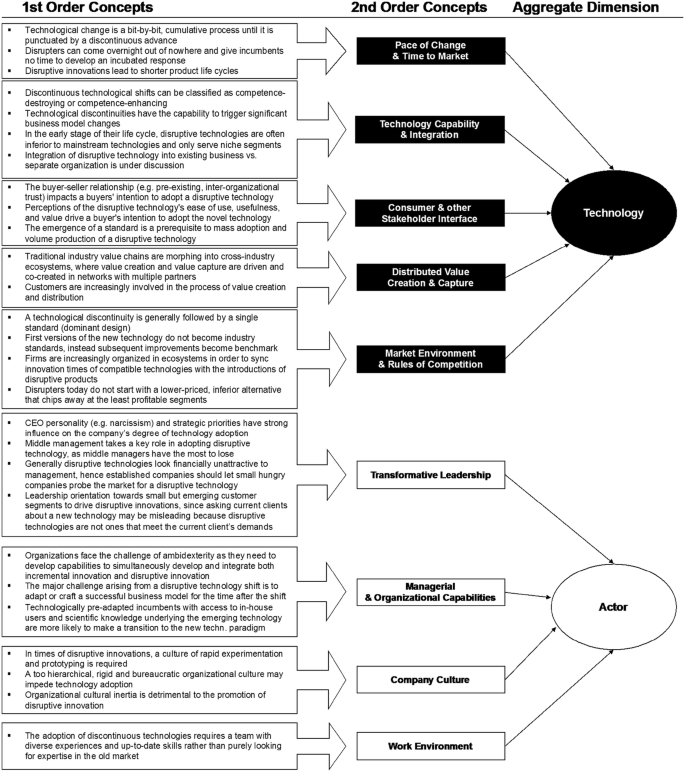
Data structure for the technology-centric dimension of technological disruption
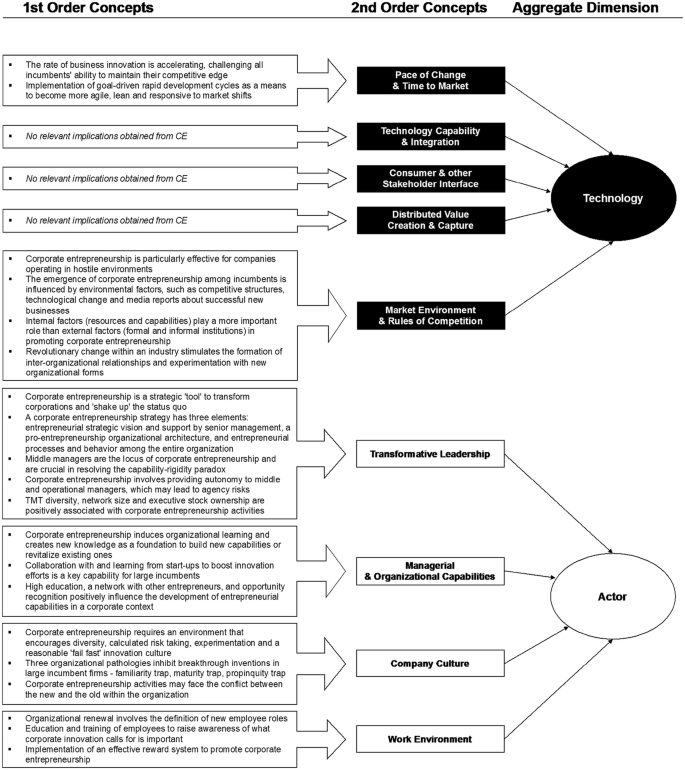
Data structure for the technology-centric dimension of corporate entrepreneurship
Rights and permissions
Open Access This article is licensed under a Creative Commons Attribution 4.0 International License, which permits use, sharing, adaptation, distribution and reproduction in any medium or format, as long as you give appropriate credit to the original author(s) and the source, provide a link to the Creative Commons licence, and indicate if changes were made. The images or other third party material in this article are included in the article's Creative Commons licence, unless indicated otherwise in a credit line to the material. If material is not included in the article's Creative Commons licence and your intended use is not permitted by statutory regulation or exceeds the permitted use, you will need to obtain permission directly from the copyright holder. To view a copy of this licence, visit http://creativecommons.org/licenses/by/4.0/ .
Reprints and permissions
About this article
Nadkarni, S., Prügl, R. Digital transformation: a review, synthesis and opportunities for future research. Manag Rev Q 71 , 233–341 (2021). https://doi.org/10.1007/s11301-020-00185-7
Download citation
Received : 14 July 2019
Accepted : 28 March 2020
Published : 18 April 2020
Issue Date : April 2021
DOI : https://doi.org/10.1007/s11301-020-00185-7
Share this article
Anyone you share the following link with will be able to read this content:
Sorry, a shareable link is not currently available for this article.
Provided by the Springer Nature SharedIt content-sharing initiative
- Digital transformation
- Digital disruption
- Technological disruption
- Corporate entrepreneurship
- Literature review
- Research agenda
JEL Classification
- Find a journal
- Publish with us
- Track your research
Research Topics & Ideas: CompSci & IT
50+ Computer Science Research Topic Ideas To Fast-Track Your Project
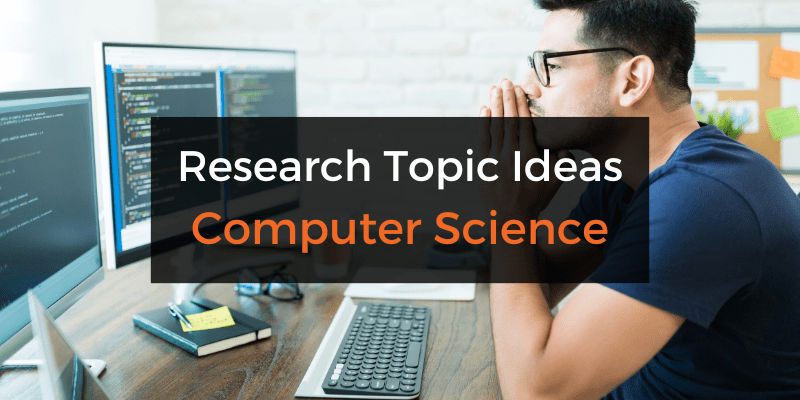
Finding and choosing a strong research topic is the critical first step when it comes to crafting a high-quality dissertation, thesis or research project. If you’ve landed on this post, chances are you’re looking for a computer science-related research topic , but aren’t sure where to start. Here, we’ll explore a variety of CompSci & IT-related research ideas and topic thought-starters, including algorithms, AI, networking, database systems, UX, information security and software engineering.
NB – This is just the start…
The topic ideation and evaluation process has multiple steps . In this post, we’ll kickstart the process by sharing some research topic ideas within the CompSci domain. This is the starting point, but to develop a well-defined research topic, you’ll need to identify a clear and convincing research gap , along with a well-justified plan of action to fill that gap.
If you’re new to the oftentimes perplexing world of research, or if this is your first time undertaking a formal academic research project, be sure to check out our free dissertation mini-course. In it, we cover the process of writing a dissertation or thesis from start to end. Be sure to also sign up for our free webinar that explores how to find a high-quality research topic.
Overview: CompSci Research Topics
- Algorithms & data structures
- Artificial intelligence ( AI )
- Computer networking
- Database systems
- Human-computer interaction
- Information security (IS)
- Software engineering
- Examples of CompSci dissertation & theses
Topics/Ideas: Algorithms & Data Structures
- An analysis of neural network algorithms’ accuracy for processing consumer purchase patterns
- A systematic review of the impact of graph algorithms on data analysis and discovery in social media network analysis
- An evaluation of machine learning algorithms used for recommender systems in streaming services
- A review of approximation algorithm approaches for solving NP-hard problems
- An analysis of parallel algorithms for high-performance computing of genomic data
- The influence of data structures on optimal algorithm design and performance in Fintech
- A Survey of algorithms applied in internet of things (IoT) systems in supply-chain management
- A comparison of streaming algorithm performance for the detection of elephant flows
- A systematic review and evaluation of machine learning algorithms used in facial pattern recognition
- Exploring the performance of a decision tree-based approach for optimizing stock purchase decisions
- Assessing the importance of complete and representative training datasets in Agricultural machine learning based decision making.
- A Comparison of Deep learning algorithms performance for structured and unstructured datasets with “rare cases”
- A systematic review of noise reduction best practices for machine learning algorithms in geoinformatics.
- Exploring the feasibility of applying information theory to feature extraction in retail datasets.
- Assessing the use case of neural network algorithms for image analysis in biodiversity assessment
Topics & Ideas: Artificial Intelligence (AI)
- Applying deep learning algorithms for speech recognition in speech-impaired children
- A review of the impact of artificial intelligence on decision-making processes in stock valuation
- An evaluation of reinforcement learning algorithms used in the production of video games
- An exploration of key developments in natural language processing and how they impacted the evolution of Chabots.
- An analysis of the ethical and social implications of artificial intelligence-based automated marking
- The influence of large-scale GIS datasets on artificial intelligence and machine learning developments
- An examination of the use of artificial intelligence in orthopaedic surgery
- The impact of explainable artificial intelligence (XAI) on transparency and trust in supply chain management
- An evaluation of the role of artificial intelligence in financial forecasting and risk management in cryptocurrency
- A meta-analysis of deep learning algorithm performance in predicting and cyber attacks in schools

Topics & Ideas: Networking
- An analysis of the impact of 5G technology on internet penetration in rural Tanzania
- Assessing the role of software-defined networking (SDN) in modern cloud-based computing
- A critical analysis of network security and privacy concerns associated with Industry 4.0 investment in healthcare.
- Exploring the influence of cloud computing on security risks in fintech.
- An examination of the use of network function virtualization (NFV) in telecom networks in Southern America
- Assessing the impact of edge computing on network architecture and design in IoT-based manufacturing
- An evaluation of the challenges and opportunities in 6G wireless network adoption
- The role of network congestion control algorithms in improving network performance on streaming platforms
- An analysis of network coding-based approaches for data security
- Assessing the impact of network topology on network performance and reliability in IoT-based workspaces

Topics & Ideas: Database Systems
- An analysis of big data management systems and technologies used in B2B marketing
- The impact of NoSQL databases on data management and analysis in smart cities
- An evaluation of the security and privacy concerns of cloud-based databases in financial organisations
- Exploring the role of data warehousing and business intelligence in global consultancies
- An analysis of the use of graph databases for data modelling and analysis in recommendation systems
- The influence of the Internet of Things (IoT) on database design and management in the retail grocery industry
- An examination of the challenges and opportunities of distributed databases in supply chain management
- Assessing the impact of data compression algorithms on database performance and scalability in cloud computing
- An evaluation of the use of in-memory databases for real-time data processing in patient monitoring
- Comparing the effects of database tuning and optimization approaches in improving database performance and efficiency in omnichannel retailing
Topics & Ideas: Human-Computer Interaction
- An analysis of the impact of mobile technology on human-computer interaction prevalence in adolescent men
- An exploration of how artificial intelligence is changing human-computer interaction patterns in children
- An evaluation of the usability and accessibility of web-based systems for CRM in the fast fashion retail sector
- Assessing the influence of virtual and augmented reality on consumer purchasing patterns
- An examination of the use of gesture-based interfaces in architecture
- Exploring the impact of ease of use in wearable technology on geriatric user
- Evaluating the ramifications of gamification in the Metaverse
- A systematic review of user experience (UX) design advances associated with Augmented Reality
- A comparison of natural language processing algorithms automation of customer response Comparing end-user perceptions of natural language processing algorithms for automated customer response
- Analysing the impact of voice-based interfaces on purchase practices in the fast food industry

Topics & Ideas: Information Security
- A bibliometric review of current trends in cryptography for secure communication
- An analysis of secure multi-party computation protocols and their applications in cloud-based computing
- An investigation of the security of blockchain technology in patient health record tracking
- A comparative study of symmetric and asymmetric encryption algorithms for instant text messaging
- A systematic review of secure data storage solutions used for cloud computing in the fintech industry
- An analysis of intrusion detection and prevention systems used in the healthcare sector
- Assessing security best practices for IoT devices in political offices
- An investigation into the role social media played in shifting regulations related to privacy and the protection of personal data
- A comparative study of digital signature schemes adoption in property transfers
- An assessment of the security of secure wireless communication systems used in tertiary institutions
Topics & Ideas: Software Engineering
- A study of agile software development methodologies and their impact on project success in pharmacology
- Investigating the impacts of software refactoring techniques and tools in blockchain-based developments
- A study of the impact of DevOps practices on software development and delivery in the healthcare sector
- An analysis of software architecture patterns and their impact on the maintainability and scalability of cloud-based offerings
- A study of the impact of artificial intelligence and machine learning on software engineering practices in the education sector
- An investigation of software testing techniques and methodologies for subscription-based offerings
- A review of software security practices and techniques for protecting against phishing attacks from social media
- An analysis of the impact of cloud computing on the rate of software development and deployment in the manufacturing sector
- Exploring the impact of software development outsourcing on project success in multinational contexts
- An investigation into the effect of poor software documentation on app success in the retail sector
CompSci & IT Dissertations/Theses
While the ideas we’ve presented above are a decent starting point for finding a CompSci-related research topic, they are fairly generic and non-specific. So, it helps to look at actual dissertations and theses to see how this all comes together.
Below, we’ve included a selection of research projects from various CompSci-related degree programs to help refine your thinking. These are actual dissertations and theses, written as part of Master’s and PhD-level programs, so they can provide some useful insight as to what a research topic looks like in practice.
- An array-based optimization framework for query processing and data analytics (Chen, 2021)
- Dynamic Object Partitioning and replication for cooperative cache (Asad, 2021)
- Embedding constructural documentation in unit tests (Nassif, 2019)
- PLASA | Programming Language for Synchronous Agents (Kilaru, 2019)
- Healthcare Data Authentication using Deep Neural Network (Sekar, 2020)
- Virtual Reality System for Planetary Surface Visualization and Analysis (Quach, 2019)
- Artificial neural networks to predict share prices on the Johannesburg stock exchange (Pyon, 2021)
- Predicting household poverty with machine learning methods: the case of Malawi (Chinyama, 2022)
- Investigating user experience and bias mitigation of the multi-modal retrieval of historical data (Singh, 2021)
- Detection of HTTPS malware traffic without decryption (Nyathi, 2022)
- Redefining privacy: case study of smart health applications (Al-Zyoud, 2019)
- A state-based approach to context modeling and computing (Yue, 2019)
- A Novel Cooperative Intrusion Detection System for Mobile Ad Hoc Networks (Solomon, 2019)
- HRSB-Tree for Spatio-Temporal Aggregates over Moving Regions (Paduri, 2019)
Looking at these titles, you can probably pick up that the research topics here are quite specific and narrowly-focused , compared to the generic ones presented earlier. This is an important thing to keep in mind as you develop your own research topic. That is to say, to create a top-notch research topic, you must be precise and target a specific context with specific variables of interest . In other words, you need to identify a clear, well-justified research gap.
Fast-Track Your Research Topic
If you’re still feeling a bit unsure about how to find a research topic for your Computer Science dissertation or research project, check out our Topic Kickstarter service.
You Might Also Like:

Investigating the impacts of software refactoring techniques and tools in blockchain-based developments.
Steps on getting this project topic
I want to work with this topic, am requesting materials to guide.
Information Technology -MSc program
It’s really interesting but how can I have access to the materials to guide me through my work?
Investigating the impacts of software refactoring techniques and tools in blockchain-based developments is in my favour. May i get the proper material about that ?
BLOCKCHAIN TECHNOLOGY
I NEED TOPIC
Submit a Comment Cancel reply
Your email address will not be published. Required fields are marked *
Save my name, email, and website in this browser for the next time I comment.
- Print Friendly
54 Most Interesting Technology Research Topics for 2023
May 30, 2023

Scrambling to find technology research topics for the assignment that’s due sooner than you thought? Take a scroll down these 54 interesting technology essay topics in 10 different categories, including controversial technology topics, and some example research questions for each.
Social technology research topics
Whether you have active profiles on every social media platform, you’ve taken a social media break, or you generally try to limit your engagement as much as possible, you probably understand how pervasive social technologies have become in today’s culture. Social technology will especially appeal to those looking for widely discussed, mainstream technology essay topics.
- How do viewers respond to virtual influencers vs human influencers? Is one more effective or ethical over the other?
- Across social media platforms, when and where is mob mentality most prevalent? How do the nuances of mob mentality shift depending on the platform or topic?
- Portable devices like cell phones, laptops, and tablets have certainly made daily life easier in some ways. But how have they made daily life more difficult?
- How does access to social media affect developing brains? And what about mature brains?
- Can dating apps alter how users perceive and interact with people in real life?
- Studies have proven “doomscrolling” to negatively impact mental health—could there ever be any positive impacts?
Cryptocurrency and blockchain technology research topics
Following cryptocurrency and blockchain technology has been a rollercoaster the last few years. And since Bitcoin’s conception in 2009, cryptocurrency has consistently showed up on many lists of controversial technology topics.
- Is it ethical for celebrities or influential people to promote cryptocurrencies or cryptographic assets like NFTs ?
- What are the environmental impacts of mining cryptocurrencies? Could those impacts ever change?
- How does cryptocurrency impact financial security and financial health?
- Could the privacy cryptocurrency offers ever be worth the added security risks?
- How might cryptocurrency regulations and impacts continue to evolve?
- Created to enable cryptocurrency, blockchain has since proven useful in several other industries. What new uses could blockchain have?
Artificial intelligence technology research topics
We started 2023 with M3GAN’s box office success, and now we’re fascinated (or horrified) with ChatGPT , voice cloning , and deepfakes . While people have discussed artificial intelligence for ages, recent advances have really pushed this topic to the front of our minds. Those searching for controversial technology topics should pay close attention to this one.
- OpenAI –the company behind ChatGPT–has shown commitment to safe, moderated AI tools that they hope will provide positive benefits to society. Sam Altman, their CEO, recently testified before a US Senate He described what AI makes possible and called for more regulation in the industry. But even with companies like OpenAI displaying efforts to produce safe AI and advocating for regulations, can AI ever have a purely positive impact? Are certain pitfalls unavoidable?
- In a similar vein, can AI ever actually be ethically or safely produced? Will there always be certain risks?
- How might AI tools impact society across future generations?
- Countless movies and television shows explore the idea of AI going wrong, going back all the way to 1927’s Metropolis . What has a greater impact on public perception—representations in media or industry developments? And can public perception impact industry developments and their effectiveness?
Beauty and anti-aging technology
Throughout human history, people in many cultures have gone to extreme lengths to capture and maintain a youthful beauty. But technology has taken the pursuit of beauty and youth to another level. For those seeking technology essay topics that are both timely and timeless, this one’s a gold mine.
- With augmented reality technology, companies like Perfect allow app users to virtually try on makeup, hair color, hair accessories, and hand or wrist accessories. Could virtual try-ons lead to a somewhat less wasteful beauty industry? What downsides should we consider?
- Users of the Perfect app can also receive virtual diagnoses for skin care issues and virtually “beautify” themselves with smoothed skin, erased blemishes, whitened teeth, brightened under-eye circles, and reshaped facial structures. How could advancements in beauty and anti-aging technology affect self-perception and mental health?
- What are the best alternatives to animal testing within the beauty and anti-aging industry?
- Is anti-aging purely a cosmetic pursuit? Could anti-aging technology provide other benefits?
- Could people actually find a “cure” to aging? And could a cure to aging lead to longer lifespans?
- How might longer human lifespans affect the Earth?
Geoengineering technology research topics
An umbrella term, geoengineering refers to large-scale technologies that can alter the earth and its climate. Typically, these types of technologies aim to combat climate change. Those searching for controversial technology topics should consider looking into this one.
- What benefits can solar geoengineering provide? Can they outweigh the severe risks?
- Compare solar geoengineering methods like mirrors in space, stratospheric aerosol injection, marine cloud brightening, and other proposed methods. How have these methods evolved? How might they continue to evolve?
- Which direct air capture methods are most sustainable?
- How can technology contribute to reforestation efforts?
- What are the best uses for biochar? And how can biochar help or harm the earth?
- Out of all the carbon geoengineering methods that exist or have been proposed, which should we focus on the most?
Creative and performing arts technology topics
While tensions often arise between artists and technology, they’ve also maintained a symbiotic relationship in many ways. It’s complicated. But of course, that’s what makes it interesting. Here’s another option for those searching for timely and timeless technology essay topics.
- How has the relationship between art and technology evolved over time?
- How has technology impacted the ways people create art? And how has technology impacted the ways people engage with art?
- Technology has made creating and viewing art widely accessible. Does this increased accessibility change the value of art? And do we value physical art more than digital art?
- Does technology complement storytelling in the performing arts? Or does technology hinder storytelling in the performing arts?
- Which current issues in the creative or performing arts could potentially be solved with technology?
Cellular agriculture technology research topics
And another route for those drawn to controversial technology topics: cellular agriculture. You’ve probably heard about popular plant-based meat options from brands like Impossible and Beyond Meat . While products made with cellular agriculture also don’t require the raising and slaughtering of livestock, they are not plant-based. Cellular agriculture allows for the production of animal-sourced foods and materials made from cultured animal cells.
- Many consumers have a proven bias against plant-based meats. Will that same bias extend to cultured meat, despite cultured meat coming from actual animal cells?
- Which issues can arise from patenting genes?
- Does the animal agriculture industry provide any benefits that cellular agriculture may have trouble replicating?
- How might products made with cellular agriculture become more affordable?
- Could cellular agriculture conflict with the notion of a “ circular bioeconomy ?” And should we strive for a circular bioeconomy? Can we create a sustainable relationship between technology, capitalism, and the environment, with or without cellular agriculture?
Transportation technology research topics
For decades, we’ve expected flying cars to carry us into a techno-utopia, where everything’s shiny, digital, and easy. We’ve heard promises of super fast trains that can zap us across the country or even across the world. We’ve imagined spring breaks on the moon, jet packs, and teleportation. Who wouldn’t love the option to go anywhere, anytime, super quickly? Transportation technology is another great option for those seeking widely discussed, mainstream technology essay topics.
- Once upon a time, Lady Gaga was set to perform in space as a promotion for Virgin Galactic . While Virgin Galactic never actually launched the iconic musician/actor, soon, they hope to launch their first commercial flight full of civilians–who paid $450,000 a pop–on a 90-minute trip into the stars. And if you think that’s pricey, SpaceX launched three businessmen into space for $55 million in April, 2022 (though with meals included, this is actually a total steal). So should we be launching people into space just for fun? What are the impacts of space tourism?
- Could technology improve the way hazardous materials get transported?
- How can the 5.9 GHz Safety Band affect drivers?
- Which might be safer: self-driving cars or self-flying airplanes?
- Compare hyperloop and maglev Which is better and why?
- Can technology improve safety for cyclists?
Gaming technology topics
A recent study involving over 2000 children found links between video game play and enhanced cognitive abilities. While many different studies have found the impacts of video games to be positive or neutral, we still don’t fully understand the impact of every type of video game on every type of brain. Regardless, most people have opinions on video gaming. So this one’s for those seeking widely discussed, mainstream, and controversial technology topics.
- Are different types or genres of video games more cognitively beneficial than others? Or are certain gaming consoles more cognitively beneficial than others?
- How do the impacts of video games differ from other types of games, such as board games or puzzles?
- What ethical challenges and safety risks come with virtual reality gaming?
- How does a player perceive reality during a virtual reality game compared to during other types of video games?
- Can neurodivergent brains benefit from video games in different ways than neurotypical brains?
Medical technology
Advancements in healthcare have the power to change and save lives. In the last ten years, countless new medical technologies have been developed, and in the next ten years, countless more will likely emerge. Always relevant and often controversial, this final technology research topic could interest anyone.
- Which ethical issues might arise from editing genes using CRISPR-Cas9 technology? And should this technology continue to be illegal in the United States?
- How has telemedicine impacted patients and the healthcare they receive?
- Can neurotechnology devices potentially affect a user’s agency, identity, privacy, and/or cognitive liberty?
- How could the use of medical 3-D printing continue to evolve?
- Are patients more likely to skip digital therapeutics than in-person therapeutic methods? And can the increased screen-time required by digital therapeutics impact mental health
What do you do next?
Now that you’ve picked from this list of technology essay topics, you can do a deep dive and immerse yourself in new ideas, new information, and new perspectives. And of course, now that these topics have motivated you to change the world, look into the best computer science schools , the top feeders to tech and Silicon Valley , the best summer programs for STEM students , and the best biomedical engineering schools .
- College Success
- High School Success

Mariya holds a BFA in Creative Writing from the Pratt Institute and is currently pursuing an MFA in writing at the University of California Davis. Mariya serves as a teaching assistant in the English department at UC Davis. She previously served as an associate editor at Carve Magazine for two years, where she managed 60 fiction writers. She is the winner of the 2015 Stony Brook Fiction Prize, and her short stories have been published in Mid-American Review , Cutbank , Sonora Review , New Orleans Review , and The Collagist , among other magazines.
- 2-Year Colleges
- Application Strategies
- Big Picture
- Career & Personality Assessment
- College Essay
- College Search/Knowledge
- Costs & Financial Aid
- Dental School Admissions
- Extracurricular Activities
- Graduate School Admissions
- High Schools
- Law School Admissions
- Medical School Admissions
- Navigating the Admissions Process
- Online Learning
- Private High School Spotlight
- Summer Program Spotlight
- Summer Programs
- Test Prep Provider Spotlight

“Innovative and invaluable…use this book as your college lifeline.”
— Lynn O'Shaughnessy
Nationally Recognized College Expert
College Planning in Your Inbox
Join our information-packed monthly newsletter.
Sign Up Now
Thank you for visiting nature.com. You are using a browser version with limited support for CSS. To obtain the best experience, we recommend you use a more up to date browser (or turn off compatibility mode in Internet Explorer). In the meantime, to ensure continued support, we are displaying the site without styles and JavaScript.
- View all journals
Information technology articles from across Nature Portfolio
Information technology is the design and implementation of computer networks for data processing and communication. This includes designing the hardware for processing information and connecting separate components, and developing software that can efficiently and faultlessly analyse and distribute this data.
Latest Research and Reviews

Machine-learning-assisted and real-time-feedback-controlled growth of InAs/GaAs quantum dots
Finding the process parameters in molecular beam epitaxy for a specific density of quantum dots is a multidimensional optimization challenge. Here, the authors demonstrate real-time feedback controlled self-assembled InAs/GaAs QDs growth based on machine learning (ML) outputs.
- Wenkang Zhan
- Zhanguo Wang
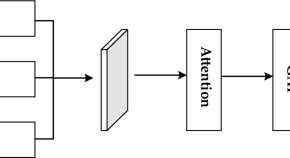
TCN-attention-HAR: human activity recognition based on attention mechanism time convolutional network

A global timekeeping problem postponed by global warming
Increased melting of ice in Greenland and Antarctica, measured by satellite gravity, has decreased the angular velocity of Earth more rapidly than before and has already affected global timekeeping.
- Duncan Carr Agnew
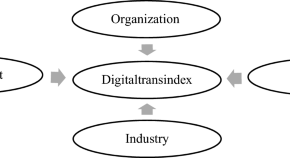
Research on predicting the driving forces of digital transformation in Chinese media companies based on machine learning
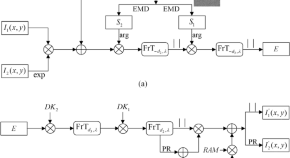
Optical phase-truncation-based double-image encryption using equal modulus decomposition and random masks
- Guangyu Luan
- Chenggen Quan
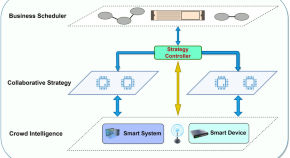
Research on collaborative edge network service migration strategy based on crowd clustering
News and Comment

AI image generators often give racist and sexist results: can they be fixed?
Researchers are tracing sources of racial and gender bias in images generated by artificial intelligence, and making efforts to fix them.
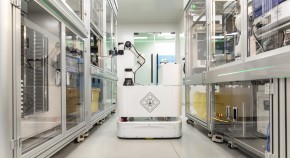
Why scientists trust AI too much — and what to do about it
Some researchers see superhuman qualities in artificial intelligence. All scientists need to be alert to the risks this creates.

Millions of research papers at risk of disappearing from the Internet
An analysis of DOIs suggests that digital preservation is not keeping up with burgeoning scholarly knowledge.

Energy-efficient wireless communications
An article in IEEE Journal on Selected Areas in Communication s presents an approach that leverages cell-free massive MIMO technology for optimal network performance with minimal energy consumption.
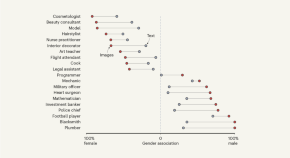
Gender bias is more exaggerated in online images than in text
A big-data analysis shows that men are starkly over-represented in online images, and that gender bias is stronger in images compared with text. Such images could influence enduring gender biases in our offline lives.
- Bas Hofstra
- Anne Maaike Mulders
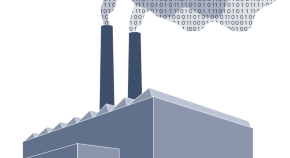
Protect our environment from information overload
- Janusz A. Hołyst
- Philipp Mayr
- Julian Sienkiewicz
Quick links
- Explore articles by subject
- Guide to authors
- Editorial policies
Thesis Helpers
Find the best tips and advice to improve your writing. Or, have a top expert write your paper.
237 Top Technology Research Topics for Academic Papers
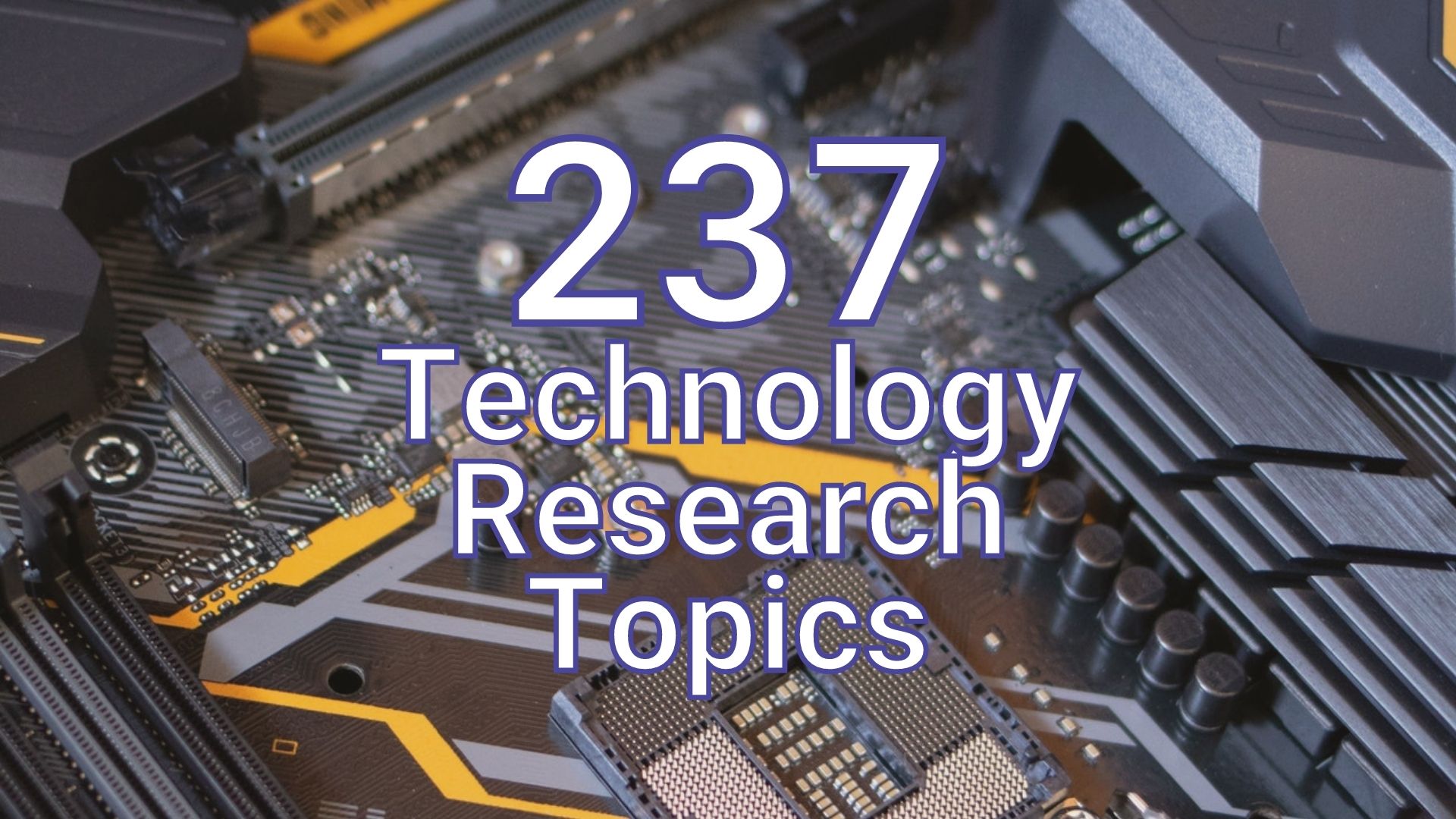
College and university students have many technology research topics to pick from when writing academic papers. That’s because technology evolves as the world changes. While some technological changes benefit humans and the environment, some have negative impacts.
For this reason, learners across levels have many topics to research and write about during their academic careers. What’s more, educators assign learners research projects with varying instructions. For instance, a professor can ask learners to write about their preferred technology topics. In that case, learners have the freedom to select their project topics.
Nevertheless, learners should select technology related topics that affect humans and the environment the most. They should also pick issues they find interesting to enjoy the research and writing process. What’s more, educators award learners top grades for selecting interesting topics whose research introduces relevant information into the sector. Here are some of the best titles to consider for research papers in science and technology.
Top Technology Research Paper Topics
This list comprises topic ideas that incorporate different technical aspects and their effects on human life.
- How computers will advance in the next decade
- What are the long-term impacts of living in a world of technological advancement?
- How technology affects child growth in the current world
- Describe the essential technological advancement today and its promises
- Explain how social media can create or solve problems in the world
- Do the internet and mobile phones make the world smaller or bigger?
- How technology is changing how people use devices with frustrating problems and glitches
- Is genetically engineering children morally wrong?
- Is there parallelism to social interactions with humans and machines?
- Can humans use technology in new ways to impact the world positively?
- How digital learning is changing the education system and schools
- Should the government censor the internet?
- Should current and potential employees give their employers access to their social media accounts?
- Should work from home become a norm, considering the current status of information technologies and internet availability?
- How will technology affect travel in the future?
- The future of auto-driving vehicles- Their pros and cons
- Should parents disclose genetic information to their children?
- Should employers and healthcare companies have access to genetic testing information?
- Using sequence human genes to predict possible future health risks- What are the limitations and benefits of this testing?
- Can genetically modified organisms solve the current hunger issues?
- Genetically modified and organic food- Which is the best option?
- Differentiating human brains and computers
- Accessing technological advances- Why this should be everyone’s right
- Should the world use under-the-skin identity chips?
- How is technology likely to advance in the next two decades?
- To what extent can new technological developments damage the world?
- How digital tools can instigate productivity
- Investigating the emerging opportunities in robotics
- The latest developments in software engineering and programming languages
- How information technology has impacted natural language processing
- Evaluating biotechnology and molecular information systems roles
- How machine learning exposes learners to recent life opportunities
- How human-computer interactions affect innovations
- Managing data during the era of 5G technology
- Emerging study fields in computer data science
- Analyzing how computing contributes to the development
- The evolution of computer graphics, animation, and game science
- Limitations of computer architecture studies in colleges
- Synthetic and computational biology development in research
- How artificial intelligence affects tedious and complex tasks
Learners can pick and develop these research topics about technology through a careful study and analysis of relevant information.
Topics about Technology and Health
Health should be humans’ top priority. If interested in health technology topics, here are brilliant ideas to consider for your research paper.
- CDC Milestone Tracker and its application in medical fields
- How humans can make the organ donation process faster and more convenient
- How technology can help in determining whether a person is dead
- Human limbs regeneration- Will it be possible in this lifetime?
- Using technology to rehabilitate individuals with lost limbs
- Is using animal tissues in humans ethical?
- Is embryonic stem cell necessary with the current technological innovations?
- Does the National Institute of Health need more funding grants for practical research projects?
- What is morbid obesity’s treatment?
- Should the government factor medical costs into the rehabilitation and research budget during wars?
- How technology has led to the surging diabetes cases
- Using embelin to prevent cancer
- How pesticides can help with cancer diagnoses
- Biotechnology and high-throughput screening
- Eliminating heat-resistant organisms using ultraviolet
- Effects of food processing technologies on bacteria in Aspalathus Linearis
- Biotechnology in farming and self-sufficient protein supply
- Evapotranspiration versus evaporation
- A southern blot and DNA cloning
- Personalized drugs and pharmacogenetics
- Pharmacogenetics in cancer medicines
- Can humans control their genetics?
- Understanding genetic engineering and gene therapy
- How beneficial is genetic engineering?
- Opportunities and dangers of genetic engineering
- Using nanotechnology to treat HIV
- Biotechnology and allergenic potential
- Biotechnology and whole-genome sequencing
- An overview of heavy metal tolerance and genes
- Food-borne illnesses and food biotechnology
Any student that finds technology and health interesting can pick a topic in this category. However, select a technology topic in this list if ready to invest time and effort in research and writing.
Hot Topics in Technology
Perhaps, you want a topic about technology for research paper that the audience will find irresistible to read from the beginning to the end. In that case, consider these ideas.
- An overview of software security types
- How to improve technological innovations patent rights
- How to eliminate stalking
- Distinguishing human perception from virtual reality
- How computer science interventions are changing the world
- Evaluating high-dimensional data modeling effectiveness
- What are the limitations of the computer science field?
- Effects of ethical hacking
- Are universities and colleges producing skilled computer scientists?
- Why are specialized banking systems critical?
- The best security measure- Fingerprint or a serial code?
- Programming languages development
- Computational thinking impact on science
- ID chips in human brains- An upcoming reality or fiction?
- Is computer game addiction a severe problem?
- What are the potential advancements of artificial intelligence?
- AI in health and medicine- Is its implementation a good idea?
- The Safety of medical applications
- Is digital voting risky?
- Can artificial intelligence obtain self-awareness?
- How safe are self-driving vehicles?
- How modern technologies and the internet ease outsourcing
- Is cryptocurrency a critical financial systems change or a buzz?
- Healthcare and cloud technologies for data management
- Discuss the latest technological advancements in cybersecurity
- Social media and privacy rights
- Can gene editing prevent or solve hunger and health problems?
- The popularity of streaming services
- How VPN services keep their users anonymous
- Will technology make traveling better?
- Incorporating information technologies in policy management
- Using IT to improve service delivery
- How IT makes advertising more authentic and appealing to consumers
- Next Generation Innovation in education systems
- WIFi connectivities in the developed countries
- How advanced information technologies help with the preservation of classified documents
- How climate and weather affect internet connectivity and strength
- The essence of adopting E-Waste management systems
- Can humans develop functional intelligent vehicle transport systems?
- Why do developing countries have fewer IT universities and colleges?
Learners should pick these research topics on technology and develop them with extensive research to write winning papers.
Interesting Technology Topics
Maybe you want to write a research paper about a topic that will instantly capture your reader’s attention. If so, consider any of these exciting research paper topics on technology.
- Latest trends in content marketing and information technology
- Human resource and information management systems
- Analyzing object tracking with radial function systems
- The development of Bluetooth phone technology
- Ethical challenges and new media technologies
- Online enterprise planning- Is it effective?
- Computer development over the last two decades
- How social media enhances communication strategies
- Has new media rendered newspapers obsolete?
- Analyzing modern communication structures
- Using social media to create ads with ease
- How social media affects personal contact
This list has some of the best topics for research projects in the technology field. Nevertheless, take your time to research your idea to develop a winning essay.
Interesting Information Technology Topics
Do you want to write a research paper about an IT topic? If yes, this category has a sample title you’ll find interesting to explore.
- How effective is unlimited data storage?
- Does the human brain and computers have a blurred line between them?
- Ethical objection for DNA information storage
- Is entertainment technology good or bad?
- How Google affects young people’s attention lifespan
- How digital reading differs from print reading
- Are traditional research skills necessary in the current world?
- Should schools and parents encourage or discourage media use among children?
- Should the government regulate sites like Wikipedia because their information may not be credible?
- How books and blogs compare
- Does Google provide the best information by preferring its brand?
- How using the internet affects the human brain
- Are people losing the intelligence they develop via conventional reading and research in the current digital age?
- How important is teaching learners to use social media, iPads, and Smart Boards?
- Should teaching incorporate the latest technologies?
- How Google search has changed humans
- Using technology to gauge intelligence
- How online format encourages skimming instead of information digestion
- How technology affects how people read
- Is using the internet to find information terrible or good?
All these are exciting research proposal topics in information technology. If the educator approves your proposal to work on any of these topics, take your time to research it extensively to develop a brilliant paper.
Computer Science and Technology Topics
Computer science is a field with many research topics relating to technology. Here are exciting ideas to explore in this field.
- Are humans yet to invent more computer languages?
- How will humans react if computers start doing most of the things they do?
- How robots are changing the healthcare sector
- How to improve the internet
- What will happen to the internet next?
- How good or bad is virtual reality?
- How virtual reality will change the education sector
- Describe virtualization in computers and technology
- Explain how virtualization is changing entertainment
- Describe the industries that machine learning will affect the most
- Explain the importance of machine learning
- Describe machine learning
- Device protection when open-source is becoming popular in computer science
- Can robots become more intelligent and like humans after reinforcing learning?
- Effects of moving things to the cloud
- Hardware and software borderline in the field of computer learning
- What is machine learning’s future?
- How big data and bioinformatics will change biology
- Which is the essential computer science for the future?
Select a topic in this category if you love researching and writing about computer science as a field in technology.
Controversial Topics in Technology
Humans are developing something new almost every day. However, some technological developments are controversial due to their potential impact on human life and the world. Here are some of the controversial technology topics to consider for research papers and essays.
- How the revolution in communication technology affects people
- Can virtual reality replace actual reality?
- How cloud technologies have changed data storage
- How smartphones usage has reduced live communications
- How modern technologies will change teaching
- Analyzing construction recession and low spending by construction companies on IT
- Technologies that humans use to explore other planets
- How dangerous are cell phones?
- How media technology affects child development
- 3D printing technology application in complex building forms’ production
- How technology improves lesson planning
- How technology influences the educational system
- Green technologies application in engineering, construction, and architecture
- Intelligent technologies and materials in road building
- The technological age turns humans into zombies
- Analyzing the drawbacks and advantages of unmanned aerial vehicles’ usage on construction sites
- How media technologies affect teenagers’ physical development
- Should humans use technology to colonize other planets?
- Should developed countries care about technology accessibility worldwide?
- Does technology create more problems while solving others?
- Does technology oppose nature?
- How is technology changing people?
- Does technology make people dumber or more intelligent?
- Does technology make people dependent on it or lazier?
- Technology impact on human practice
- Is engineering a child genetically morally wrong?
- Describe the long-term effects of a technological world
- How are humans changing the world using technology?
- How are new technologies affecting the world negatively?
- How is technology likely to change humans in the next twenty years?
- How digital learning is changing education and schools
- Drone warfare- Is it a possibility?
- Are digital tools making humans less or more productive?
- Using technology to develop alternative energy forms
- Does the government invade privacy by using law enforcement cameras?
- Can humans use technology to improve their interactions with animals?
Select and write about a topic in this category if you love working on controversial ideas. Nevertheless, most issues require research to develop persuasive papers.
Technology Persuasive Speech Topics
Perhaps, you want to research and write a speech on a persuasive topic. In that case, consider these ideas.
- Communication masts locations should be away from people’s houses
- Programming courses should be mandatory in colleges
- Social networks should verify user’s identity
- Every social network should implement two-step verification
- Kids should not use social media
- Internet pop-up ads and spams are the same
- Smartphone addiction- Is it a disease?
- Self-driving cars are not suitable for humans on busy roads
- E-books should replace conventional books
- Kids should not play violent computer games
- Internet gambling requires strong regulations
- Humans should avoid overreliance on smartphones and computers
- Desktop computers are no longer fashionable
- Computer games are making kids stupid
- Governments should censor the internet
- Workers should use digital tools more often to boost workplace productivity
- The world needs more technological advancements
- Why governments should promote digital learning
- Technology research deserves more government funding
- Hybrid cars save energy
- Car manufacturers should consider the environment when designing vehicles
- All children should learn to use smartphones and computers
- Search engines are killing human brain libraries
- Humans should use drones for non-military and military purposes
- Smart notebooks are replacing papers
This category has trending topics in technology that you can explore in your project. Nevertheless, most of them are argumentative technology topics that require some convincing. That means you need time and skills to research and develop your topic.
Educational Technology Topics
Perhaps, you’re interested in a topic that touches on education and technology. In that case, consider these ideas for your research project.
- Incorporating computational thinking in education
- How technology is changing the classroom practice
- How technology changes learning outcomes
- Is there evidence to prove that educational technology adds value for money?
- What enabling factors support or inhibit educational technology integration?
- How educational technology programs can facilitate learning change
- Using mobile phones for teacher development videos and classroom audio
- How tablets and eReaders can support literacy in early developmental stages
- Do programs that use technology have better educational outcomes?
- Can change theory explain how technology will improve educational outcomes?
- What technologies can be more cost-effective in the educational sector?
- How appropriate is the current technology for technical training?
- Describe effective informal and formal technologies for providing peer support among teachers
- Technologies for engaging the school management, headteachers, and the entire school community
- Does educational program evaluation exceed technology access and output?
Whether you’re looking for educational or medical laboratory technology research topics, you have many ideas to consider. Each title in this list can serve as an example to inspire you to develop a unique topic for your paper.
Get Professional Help with Researching and Writing
Do you have difficulties researching and writing a research paper? Maybe you’re unable to select the best topic for your project. In that case, seek thesis help online. We’re a highly qualified team providing superior writing help to learners across academic fields and levels. Our crew has writers providing high quality assistance with topic selection and writing. Regardless of how complex your research paper demands seem, we’re ready to help you.
We offer the best rated research writing assistance at affordable prices. We want you to have an easy time completing your research project. Therefore, don’t struggle to compose a paper and end up with a poor grade when experts can help you score A+ without breaking a sweat. Place an order for your research paper with us, and we will be glad to assist you.
Contact us now to get cheap and quality assistance with your research paper!
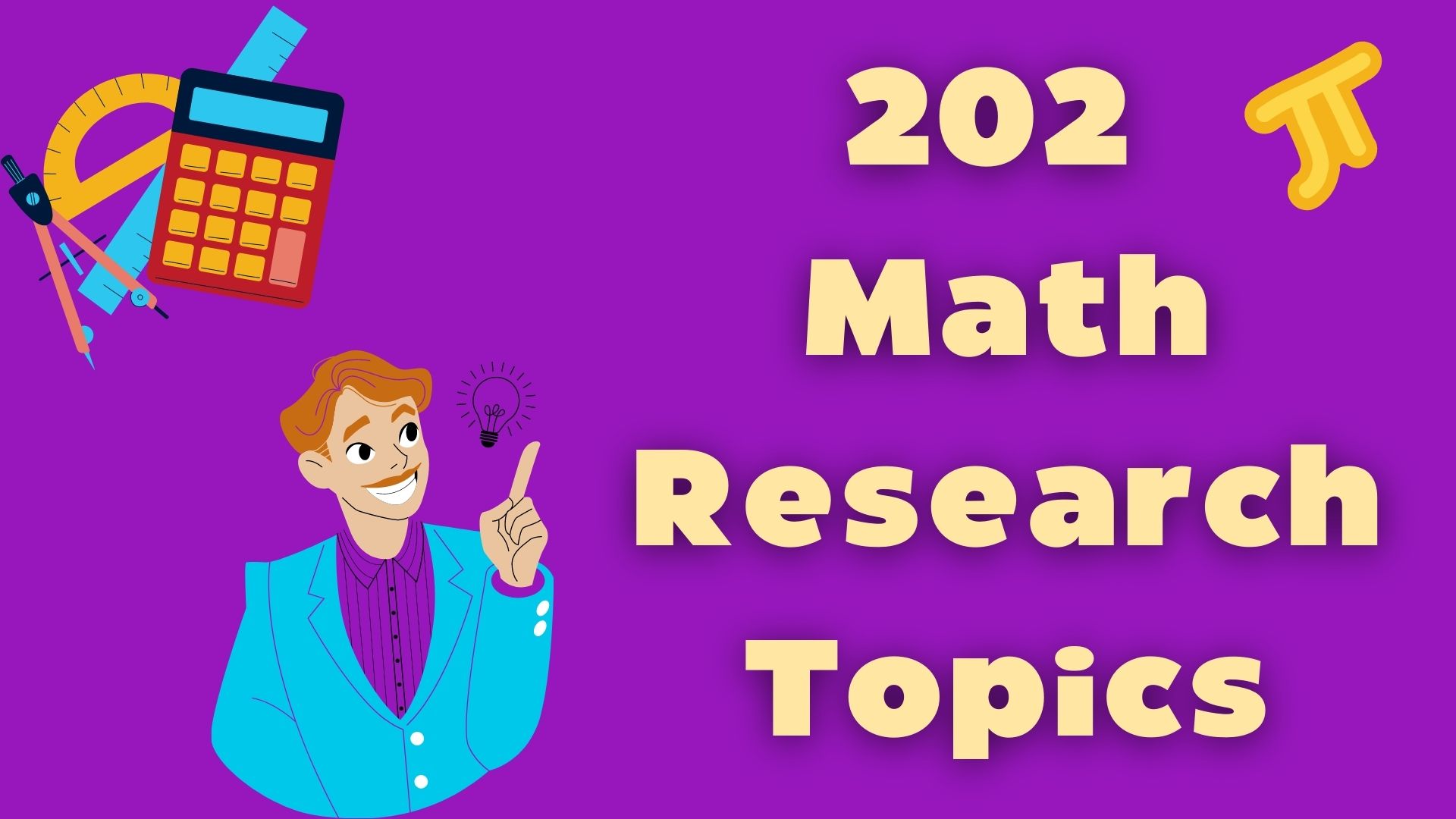
Make PhD experience your own
Leave a Reply Cancel reply
Your email address will not be published. Required fields are marked *

Recognition
Classification
Historical Archives
Document Indexing
Forms Processing
OEM Integration
Records Classification
- PLANETBRAIN
- PerceptionMatrix
- Publications
Research Projects
Resource Center
Customer Stories
- Press & News
Enhancing PLANET BRAIN every day
Recent progress in the areas of Artificial Intelligence (AI) and Machine Learning (ML) are tremendous. Almost monthly, we see reports announcing breakthroughs in different technological aspects of AI.
As an organization focussing on research and development, we can look back on an increasing number of research projects .

Publicly funded Research Projects
Ki-dera (2024).
Goal: Development and validation of a radiological AI assistance system to support dementia diagnosis
Duration: 3 years
Partner: DZNE, Institute for Diagnostic and Interventional Radiology, Pediatric- und Neuroradiology, webhub GmbH
CAPTAIN (2023)
Goal: Real-time artificial intelligence annotation of multimodality endoscopy images in pancreatic cancer, allowing tumor cells to be detected during the examination and treated or removed directly
Duration: 3 years
Partner: PolyDiagnost GmbH, University Medical Center Göttingen, Institute for Diagnostic and Interventional Radiology, Faculty Engineering & Health of the University of Allied Science and Arts
Ocean Technology Center - DaTA (2022)
Partner: EvoLogics GmbH, IAV GmbH, Fraunhofer IGD, University of Rostock, IOW
Ocean Technology Center - Genomics (2022)
Partner: Leibnitz Institute for Baltic Sea Research Warnemünde, IOW, LGC Genomics, Hydrobios, Fraunhofer IGD
Intelligent Radiological Assistant (2020)
Partner: University of Rostock
NewsEye (2019)
Partner: University of Rostock, University of La Rochelle, Austrian National Library, University of Helsinki, University of Innsbruck, National Library of France, University of Montpellier, University of Vienna
READ (2016)
Goal: Recognition of historical handwritten texts (European cultural heritage 1500 – 1800)
Partner: University of Rostock, University of Greifswald, National Archives Finland, University of Erlangen-Nuremberg, University of Innsbruck, University of Valencia, University of Edinburgh, National Archives Norway, Swedish National Archives, University of Vienna
Automatic Full-Text Recognition (2014)
Goal: Algorithms for automatic full text recognition in handwritten historical documents
ORGANIC (2009)
Solutions by Industry
Solutions by Process
Popular Posts
OCR Beginner Guide
Document Classification Beginner
Data Extraction Beginner
Major Challenge – ICR
On-Premises vs. Cloud
Press & News
Customer Support Center
© 2024 PLANET AI GmbH | All Rights Reserved | Legal Notice | Privacy Policy | Change Privacy Settings | Revoke Consents
- Dean’s Office
- External Advisory Council
- Computing Council
- Extended Computing Council
- Undergraduate Advisory Group
- Break Through Tech AI
- Building 45 Event Space
- Infinite Mile Awards: Past Winners
- Frequently Asked Questions
- Undergraduate Programs
- Graduate Programs
- Educating Computing Bilinguals
- Online Learning
- Industry Programs
- AI Policy Briefs
- Envisioning the Future of Computing Prize
- SERC Symposium 2023
- SERC Case Studies
- SERC Scholars Program
- SERC Postdocs
- Common Ground Subjects
- For First-Year Students and Advisors
- For Instructors: About Common Ground Subjects
- Common Ground Award for Excellence in Teaching
- New and Incoming Faculty
- Faculty Resources
- Faculty Openings
- Search for: Search
- MIT Homepage
MIT researchers win grants to develop and test 14 innovative ideas to improve education

The Jameel World Education Lab awards more than $900K in Education Innovation Grants to researchers across MIT.
The MIT Jameel World Education Lab has awarded $917,526 in Education Innovation Grants to support 14 research projects exploring a range of topics, including electrical engineering, extended reality, physical movement, and ecological sustainability. The grants will support researchers from 11 departments, labs, and centers across MIT.
“Our Education Innovation Grants support MIT research that can improve learning everywhere,” says Anjali Sastry, faculty director of the Jameel World Education Lab. “We share ideas, disseminate emerging findings, and collaborate with innovators who join us to lead global change in education. Educators in dozens of countries will learn from this year’s inspiring efforts to tackle core challenges in education with innovative new methods and means. Through light-up sneakers, glassblowing, and autonomous vehicles, grantees are enabling learning from curriculum-linked real-world projects, prototyping effective ways to embed evidence-based insights and research into the design of learning experiences, and enabling transitional learners to benefit from high-quality education.”
Since 2017, the Jameel World Education Lab, part of MIT Open Learning, has awarded more than $5 million in funding to MIT researchers for projects to address teaching and learning across the life cycle, from pK-12 to higher education to workforce learning. Over the years, grants have supported educational innovations across a rich variety of MIT fields: mechanical engineering, literature, architecture, computer science and artificial intelligence, aeronautics and astronautics, management, physics, and more.
“We are energized by the breadth and scope of topics from this year’s grantees,” adds Maria Segala, data, reporting, and grants administrator for the Jameel World Education Lab. “We look forward to connecting the innovative work of our grantees to the broader MIT community, Jameel World Education Lab member organizations, and educators and learners around the world.”
The 2023 Education Innovation Grant researchers and their projects are:
“An online platform for explaining, promoting, and facilitating embodied education at MIT and beyond” — Jennifer Light, the Bern Dibner Professor of the History of Science and Technology and professor in the Department of Urban Studies and Planning
Light’s work on embodied education aims to close the gap between the growing body of research on movement and the learning process and the pedagogical strategies that educators use. Light seeks to find ways to help schools integrate physical activity and academic instruction at all levels — for example, teaching elementary school geometry through yoga, middle school physics through martial arts, and high school history through dance.
“Making implicit knowledge explicit: tacit knowledge transfer from expert glassblowing instructors to less-experienced students at the MIT Glass Lab” — Andrés Felipe Salazar-Gomez, research scientist at MIT Open Learning; Alexandre Armengol Urpi, postdoc in the Department of Mechanical Engineering; and Sanjay Sarma, the Fred Fort Flowers and Daniel Fort Flowers Professor of Mechanical Engineering
Implicit knowledge is know-how that an expert is usually unable to verbalize, codify, or explicitly transfer to others. Salazar-Gomez and Sarma seek to understand representations of tacit knowledge using overt and covert attention signatures in a mentor/apprentice setting. This study will use scene point-of-view videos, eye tracking, and detailed instructions from glassblowing experts to naïve learners to create instructional resources that will be offered as novel instructional material.
“Games for climate education: developing game-based facilitation of the En-ROADS climate simulator” — Lana Cook, associate director of the MIT Systems Awareness Lab; and Eric Klopfer, director of the MIT Scheller Teacher Education Program and head of MIT Comparative Media Studies/Writing
Climate Interactive ’s innovative climate change simulator En-ROADS has been very successful in engaging participants to think about the impact of alternative policies and actions to mitigate and reverse the effects of climate destruction. Yet, meaningful shifts in understanding, policy, and action require education and understanding at massively greater scales than are currently possible with the En-ROADS facilitation model. Cook and Klopfer seek to explore game-based facilitation.
“Minor notes: teaching the archival arts” — Joshua Bennett, Distinguished Chair of the Humanities and professor in MIT Literature
“Minor notes” addresses current gaps in K-12 literary arts education through a novel approach that combines archival research with collaborative art-making. Bennett plans to meet with a cohort of high school seniors and their faculty advisors to explore local community archives and compose original works of art inspired by the historical materials they discover in those spaces.
“Promoting creative learning through Festivals of Invention and Creativity: building on a successful model from Brazil” — Ann Berger Valente, educational research manager at the MIT Media Lab; and Leo Burd, director of the Lemann Creative Learning Program at the Media Lab
As part of its Brazilian Creative Learning Network program, MIT Media Lab’s Lifelong Kindergarten group plans to develop a set of resources and guides to deepen and broaden the reach of creative learning experiences through Festivals of Invention and Creativity in countries around the world. Valente and Burd will gather input and feedback during the development process from educators in Brazil, Chile, Mexico, South Africa, and other countries to iteratively refine the resources.
“ODDS & MODS: Material circularity prototypes for rural communities” — Sheila Kennedy, chair of MIT Master of Science in Architecture Studies programs and professor in the Department of Architecture; and Caitlin Mueller, director of MIT Digital Structures Lab and associate professor in the Department of Architecture
Kennedy and Mueller aim to foster practical learning by engaging students in circular material economies through project-based research and demonstrations. The integrated curriculum will explore material circularity in architecture, empowering students to drive decarbonization and lead transformative changes in design and construction practices while utilizing innovative materials and reducing environmental impact.
“Climate and Environmental Justice (CEJ) inclusion: exploring CEJ teaching practices across departments, labs, or centers at MIT” — Christopher Rabe, postdoc of environmental and sustainability education with the MIT Environmental Solutions Initiative; and John Fernández, director of the MIT Environmental Solutions Initiative and professor of building technology in the Department of Architecture
Higher education institutions — including MIT — lack a full integration of CEJ into its environmental and sustainability programs. This exclusion leads to underrepresented students, including Black, Indigenous, and people of color (BIPOC) individuals, feeling discrimination and isolation within these programs. To truly address global climate justice, it is crucial for higher education to understand how CEJ is taught and its impact on BIPOC students’ sense of belonging.
“Strengthening biomedical education curriculum in East Africa to incorporate hands-on learning and innovation” — Nevan Clancy Hanumara, research scientist in the Department of Mechanical Engineering; Alexander Slocum, the Walter M. May (1939) and A. Hazel May Chair in Emerging Technologies in the Department of Mechanical Engineering
While the scarcity of medical equipment in much of Africa is recognized, little attention has been given to local biomedical engineers who aspire to be innovators and develop context-appropriate medical devices. Hanumara and Slocum propose to create a scalable innovation module framework designed for East African biomedical students, based on the course 2.75/2.750 (Medical Device Design).
“MICRO 2.0: Cultivating students’ STEM identities through a blended learning research and education program” — Jessica G. Sandland, principal lecturer in the Department of Materials Science and Engineering and digital learning scientist in MIT Open Learning
Building on the success of Materials Initiative for Comprehensive Research Opportunity (MICRO), a program providing research opportunities to underrepresented undergraduate students, Sandland proposes MICRO 2.0: a blended program that combines online research, mentorship, workshops, and campus visits to foster participants’ identities as STEM researchers and members of the materials science and engineering community. The program also seeks to address the underrepresentation of certain BIPOC groups in U.S. engineering doctoral programs.
“A climate toolkit for design thinking” — Aisling O’Grady, project manager at the MIT Energy Initiative; and Christopher R. Knittel, the George P. Shultz Professor and professor of applied economics in the MIT Sloan School of Management
A 2016 Science Magazine article revealed a disconnect between climate science progress and education resources, resulting in limited teacher time and awareness about climate change consensus. This lack of education hampers global youth engagement in climate solutions, which underscores the need to bridge the academic-societal climate education gap. O’Grady and Knittel propose creating a toolkit that focuses on impactful, student-centered climate education to support these efforts.
“Partnering with an Indigenous tribe to bring a successful STEM program for creating autonomous vehicles to the middle-school level” — Sertac Karaman, professor in the Department of Aeronautics and Astronautics
The Department of Aeronautics and Astronautics’ Design, Build, Fly model aircraft curriculum aims to teach essential engineering concepts through model airplanes, catering to underserved and under-resourced students. By adapting the program for younger middle school students lacking certain mathematical skills, Karaman proposes to provide kits and materials for learning aerodynamics, designing, building, and testing, fostering STEM interest from an early age.
“Studying educators’ practices in makerspaces to build a curriculum for maker skill learning” — Stefanie Mueller, the TIBCO Career Development Associate Professor in the Department of Electrical Engineering and Computer Science and head of the Human-Computer Engineering Group at the Computer Science and Artificial Intelligence Laboratory
Existing research into makerspaces mainly focuses on students’ experiences, neglecting educators’ perspectives. Mueller proposes that understanding educators’ viewpoints can guide the development of better educational tools and approaches, while studying diverse makerspaces across contexts can provide insights into effective practices.
“Light up kicks: engaging youth in shoe design using culturally sustainable pedagogy” — Cristina Sáenz, invention education manager at the Lemelson-MIT Program; and Michael Cima, the David H. Koch (1962) Professor of Engineering in the Department of Materials Science and Engineering and faculty director of the Lemelson-MIT Program
Lemelson-MIT researchers plan to create an inventive curriculum for elementary students between 9 and 11 years old, centered on building a prototype shoe with lights. The curriculum addresses waning interest in STEM among young learners, focusing on diversity and multiculturalism to engage students from different backgrounds in the innovation process. Ultimately, this curriculum aims to boost diversity in the innovation ecosystem.
“Developing an ACT-R and error-based cognitive architecture for the development of virtual reality hands-on training” — John Liu, principal investigator of the Learning Engineering and Practice Group, lecturer in the Department of Mechanical Engineering and digital learning scientist at MIT Open Learning
Hands-on manufacturing skills are crucial for success in today’s technology-driven world, but the rapid advancement of manufacturing technology creates a gap between industry needs and workforce training. Liu proposes that extended reality offers a promising approach due to its scalability and personalized feedback potential, particularly for non-traditional education pathways.
Related Stories

Read our research on: Abortion | Podcasts | Election 2024
Regions & Countries
Main findings: teens, technology, and human potential in 2020, respondents’ thoughts.
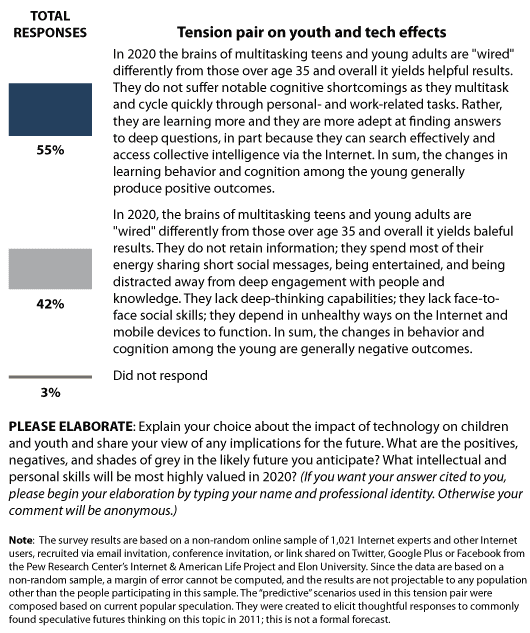
Hyperconnected. Always on. These terms have been invented to describe the environment created when people are linked continuously through tech devices to other humans and to global intelligence. Teens and young adults have been at the forefront of the rapid adoption of the mobile internet and the always-on lifestyle it has made possible.
The most recent nationally representative surveys of the Pew Internet Project show how immersed teens and young adults are in the tech environment and how tied they are to the mobile and social sides of it. Some 95% of teens ages 12-17 are online, 76% use social networking sites, and 77% have cell phones. Moreover, 96% of those ages 18-29 are internet users, 84% use social networking sites, and 97% have cell phones. Well over half of those in that age cohort have smartphones and 23% own tablet computers like iPads.
People are tuning in to communications technologies at an ever-expanding level. Some recent indicators:
- Nearly 20 million of the 225 million Twitter users follow 60 or more Twitter accounts and nearly 2 million follow more than 500 accounts.
- There are more than 800 million people now signed up for the social network Facebook; they spend 700 billion minutes using Facebook each month, and they install more than 20 million apps every day. Facebook users had uploaded more than 100 billion photos by mid-2011.
- YouTube users upload 60 hours of video per minute and they triggered more than 1 trillion playbacks in 2011 – roughly 140 video views per person on earth.
When asked to choose one of the two 2020 scenarios presented in this survey question, respondents were asked to, “Explain your choice about the impact of technology on children and youth and share your view of any implications for the future. What are the positives, negatives and shades of grey in the likely future you anticipate? What intellectual and personal skills will be most highly valued in 2020?”
Following is a selection from the hundreds of written responses survey participants shared when answering this question. The selected statements are grouped under headings that indicate the major themes emerging from these responses. The headings reflect the varied and wide range of opinions found in respondents’ replies .
This is the next positive step in human evolution: We become “persistent paleontologists of our external memories”
Most of the survey respondents with the largest amount of expertise in this subject area said changes in learning behavior and cognition will generally produce positive outcomes.
One of the world’s best-known researchers of teens and young adults—danah boyd of Microsoft Research—said there is no doubt that most people who are using the new communications technologies are experiencing the first scenario as they extend themselves into cyberspace. “Brains are being rewired—any shift in stimuli results in a rewiring,” she wrote. “The techniques and mechanisms to engage in rapid-fire attention shifting will be extremely useful for the creative class whose job it is to integrate ideas; they relish opportunities to have stimuli that allow them to see things differently.”
Amber Case, cyberanthropologist and CEO of Geoloqi, agreed: “The human brain is wired to adapt to what the environment around it requires for survival. Today and in the future it will not be as important to internalize information but to elastically be able to take multiple sources of information in, synthesize them, and make rapid decisions.”
She added, “Memories are becoming hyperlinks to information triggered by keywords and URLs. We are becoming ‘persistent paleontologists’ of our own external memories, as our brains are storing the keywords to get back to those memories and not the full memories themselves.”
Morley Winograd, author of Millennial Momentum: How a New Generation is Remaking America , echoed the keyword-tagging idea. “Millennials are using packet-switching technology rather than hard-wired circuit switching to absorb information,” he responded. “They take a quick glance at it and sort it and/or tag it for future reference if it might be of interest.”
Cathy Cavanaugh, an associate professor of educational technology at the University of Florida, noted, “Throughout human history, human brains have elastically responded to changes in environments, society, and technology by ‘rewiring’ themselves. This is an evolutionary advantage and a way that human brains are suited to function.”
Susan Price, CEO and chief Web strategist at Firecat Studio and an organizer of TEDx in San Antonio, Texas, is optimistic. “The amazing plasticity of the brain is nowhere as evident in the rapid adaptations humans are making in response to our unprecedented access to electronic information,” she wrote. “Those who bemoan the perceived decline in deep thinking or engagement, face-to-face social skills and dependency on technology fail to appreciate the need to evolve our processes and behaviors to suit the new reality and opportunities. Young people and those who embrace the new connectedness are developing and evolving new standards and skills at a rate unprecedented in our history. Overall, our ability to connect, share and exchange information with other human beings is a strong net positive for humanity.”
Teens expert boyd says adults have to recognize the need for young people to explore the world widely and build future skills. “If we keep restricting the mobility of young people, online and offline, we will be curbing their ability to develop social skills writ large,” she warned. “This has nothing to do with technology but with the fears we have about young people engaging with strangers or otherwise interacting with people outside of adult purview.”
William Schrader, a consultant who founded PSINet in the 1980s, expressed unbridled hope. “A new page is being turned in human history, and while we sometimes worry and most of the time stand amazed at how fast (or how slowly) things have changed, the future is bright for our youth worldwide,” he wrote. “The youth of 2020 will enjoy cognitive ability far beyond our estimates today based not only on their ability to embrace ADHD as a tool but also by their ability to share immediately any information with colleagues/friends and/or family, selectively and rapidly. Technology by 2020 will enable the youth to ignore political limitations, including country borders, and especially ignore time and distance as an inhibitor to communications. There will be heads-up displays in automobiles, electronic executive assistants, and cloud-based services they can access worldwide simply by walking near a portal and engaging with the required method such as an encrypted proximity reader (surely it will not be a keyboard). With or without devices on them, they will communicate with ease, waxing philosophic and joking in the same sentence. I have already seen youths of today between 20 and 35 who show all of these abilities, all driven by and/or enabled by the internet and the services/technologies that are collectively tied to and by it.”
Perry Hewitt, Chief Digital Officer of Harvard Public Affairs & Communications and Alumni Affairs & Development, says this evolution is positive. “It seems easy to decry the attention span of the young and to mourn the attendant loss of long form content—who will watch Citizen Kane with rapt attention when your Android tells you Rosebud was a sled? On consideration, though, the internet has brought forward not only education, but thinking. While we still want to cultivate in youth the intellectual rigor to solve problems both quantitatively and qualitatively, we have gotten them out of the business of memorizing facts and rules, and into the business of applying those facts and rules to complex problems. In particular, I have hope for improved collaboration from these new differently ‘wired’ brains, for these teens and young adults are learning in online environments where working together and developing team skills allows them to advance.”
David Weinberger, senior researcher at Harvard University’s Berkman Center for Internet & Society, says values will evolve alongside the evolution in ways of thinking and knowing. “Whatever happens,” he wrote, “we won’t be able to come up with an impartial value judgment because the change in intellect will bring about a change in values as well.” Alex Halavais, an associate professor and internet researcher at Quinnipiac University, agreed. “We will think differently, and a large part of that will be as a result of being capable of exploiting a new communicative environment,” he noted.
Anonymous respondents added:
“People of all ages are adjusting to a world where ‘facts’ are immediately discoverable, and judgment between competing facts becomes a primary skill.”
“They will be more nimble and enjoy the access that is available to them to interact with their peers, to see, hear, learn, observe, and be entertained—not necessarily in that order. They will have greater flexibility in the world of employment as well.”
“They are used to using the complex interfaces from childhood. It results in a brain better able to assimilate software structure, to organize and resolve complex problems more quickly and almost appear to be ‘wired’ differently than my generation. Positively, they will operate at a much quicker rate in terms of decision-making, analysis, and methodology than my generation. Negatively, they might be missing the sheer joy of play, of conversation, or quiet contemplative moments due to the interruptions of their lives by electronic communication.”
Negative effects include a need for instant gratification, loss of patience
A number of the survey respondents who are young people in the under-35 age group—the central focus of this research question—shared concerns about changes in human attention and depth of discourse among those who spend most or all of their waking hours under the influence of hyperconnectivity.
Alvaro Retana, a distinguished technologist with Hewlett-Packard, expressed concerns about humans’ future ability to tackle complex challenges. “The short attention spans resulting from the quick interactions will be detrimental to focusing on the harder problems, and we will probably see a stagnation in many areas: technology, even social venues such as literature,” he predicted. “The people who will strive and lead the charge will be the ones able to disconnect themselves to focus on specific problems.”
Stephen Masiclat, a communications professor at Syracuse University, said, “When the emphasis of our social exchanges shifts from the now to the next, and the social currency of being able to say ‘I was there first’ rises, we will naturally devalue retrospective reflection and the wisdom it imparts.”
Masiclat said social systems will evolve to offer even more support to those who can implement deep-thinking skills. “The impact of a future ‘re-wiring’ due to the multitasking and short-term mindset will be mostly negative not because it will reflect changes in the physical nature of thinking, but because the social incentives for deep engagement will erode,” he noted. “We will likely retain deep-thinking capability if we just reward it sufficiently in many of our social institutions.”
Marjory S. Blumenthal, associate provost at Georgetown University and former director of the Computer Science and Telecommunications Board of the National Academies, agreed. “Perhaps the issue is, how will deep thinking get done—including by whom—rather than will everyone be able to do deep thinking. In other words, division of labor may change.”
However, students who participated in the survey tended to express concerns about their peers’ ability to get beyond short-burst connections to information. Melissa Ashner, a student at the College of William and Mary, observed, “People report having more difficulty with sustained attention (i.e., becoming immersed in a book). Today, we have very young, impressionable minds depending on technology for many things. It is hard to predict the ways in which this starves young brains of cognitive ability earned through early hands-on experiences. It is likely to continue to contribute to the rise in childhood obesity as well, which further hinders cognitive function.”
Dana Levin, a student at Drexel University College of Medicine, wrote, “The biggest consequence I foresee is an expectation of immediacy and decreased patience among people. Those who grow up with immediate access to media, quick response to email and rapid answers to all questions may be less likely to take longer routes to find information, seeking ‘quick fixes’ rather than taking the time to come to a conclusion or investigate an answer.”
Richard Forno, a long-time cybersecurity expert, agreed with these younger respondents, saying he fears “where technology is taking our collective consciousness and ability to conduct critical analysis and thinking, and, in effect, individual determinism in modern society.”
He added, “My sense is that society is becoming conditioned into dependence on technology in ways that, if that technology suddenly disappears or breaks down, will render people functionally useless. What does that mean for individual and social resiliency?”
Many anonymous respondents focused their responses on what one referred to as “fast-twitch” wiring. Here’s a collection of comments along those lines:
“I wonder if we will even be able to sustain attention on one thing for a few hours—going to a classical concert or film, for instance. Will concerts be reduced to 30 minutes? Will feature-length films become anachronistic?”
“Communication in all forms will be more direct; fewer of the niceties and supercilious greetings will exist. Idle conversation skills will be mostly lost.”
“Discussions based around internet content will tend to be pithy, opinion-based, and often only shared using social media with those who will buttress—rather than challenge—political, ideological, or artistic beliefs.”
“Increasingly, teens and young adults rely on the first bit of information they find on a topic, assuming that they have found the ‘right’ answer, rather than using context and vetting/questioning the sources of information to gain a holistic view of a topic.”
“Constant broadcasts don’t make it easy for the individual to step away and work through an issue or concern without interruption.”
“My friends are less interested in genuine human interaction than they are at looking at things on Facebook. People will always use a crutch when they can, and the distraction will only grow in the future.”
“Parents and kids will spend less time developing meaningful and bonded relationships in deference to the pursuit and processing of more and more segmented information competing for space in their heads, slowly changing their connection to humanity.”
“How/why should we expect the next generation to be ‘different’ (implication = more evolved/better) when they’re raised in a culture increasingly focused on instant gratification with as little effort as possible?”
“It’s simply not possible to discuss, let alone form societal consensus around, major problems without lengthy, messy conversations about those problems. A generation that expects to spend 140 or fewer characters on a topic and rejects nuance is incapable of tackling these problems.”
“Why are we creating a multitasking world for ADD kids? The effects will be more telling than just the Twitterfication of that generation. There have been articles written about how they’re losing their sense of direction (who needs bearings when you have Google Maps or a GPS?). Who needs original research when you have Wikipedia?”
“Human society has always required communication. Innovation and value creation come from deeper interaction than tweets and social media postings. Deeper engagement has allowed creative men and women to solve problems. If Thomas Edison focused on short bursts of energy, I doubt he would have worked toward the creation of the light bulb.”
“‘Fast-twitch’ wiring among today’s youth generally leads to more harm than good. Much of the communication and media consumed in an ‘always-on’ environment is mind-numbing chatter. While we may see increases in productivity, I question the value of what is produced.”
“There is less time for problems to be worked out, whether they are of a personal, political, economic, or environmental nature. When you (individual or collective) screw up (pollute, start a war, act in a selfish way, or commit a sexual indiscretion as a public person) everyone either knows very quickly or your actions affect many people in ways that are irreversible.”
“They should all be forced to whittle a whistle while sitting on a porch with nothing but the trees and birds for company.”
“Long-form cognition and offline contemplative time will start to be viewed as valuable and will be re-integrated into social and work life in interesting and surprising ways.”
Annette Liska, an emerging-technologies design expert, observed, “The idea that rapidity is a panacea for improved cognitive, behavioral, and social function is in direct conflict with topical movements that believe time serves as a critical ingredient in the ability to adapt, collaborate, create, gain perspective, and many other necessary (and desirable) qualities of life. Areas focusing on ‘sustainability’ make a strong case in point: slow food, traditional gardening, hands-on mechanical and artistic pursuits, environmental politics, those who eschew Facebook in favor of rich, active social networks in the ‘real’ world.”
Enrique Piraces, senior online strategist for Human Rights Watch, said communication and knowledge acquisition are increasingly mediated by technology, noting that by 2020, “a significant part of the knowledge that anyone can discover will be processed by ‘third-party brains.’ Machines will learn from that processing, but I’m afraid the subjects won’t develop deep thinking based on this.”
Robert F. Lutes, director of Valley Housing and Economic Authority, says technology is taking humanity down a harmful path. “We have, by-and-large, created a ‘feed-me/fix-me’ generation of sound-bite learners. They are not given the skills to retain anything more than short bits of information. Hence the new generation of computer skills found on social network sites such as Twitter, Facebook, et al., are quite easy to grasp hold of and only serve to widen their realms of friends…HP and IBM both dropped their sales of laptop computers for the 2020 generation. Most of the other mainstream companies will continue to do so. CD’s and DVD’s will be totally absent from the scene by that time. Nanotechnology, cloud computing, flash drives, and so forth will be the order of the day. Over the course of the past three years, touchpad technology has exploded exponentially in usage and available applications. These will become the books, communications media, and everything. Face-to-face time will be calculated in terms of touchscreen camera time and not in face-to-face human contact. Much of this is true in the decade of the 2010’s. The ‘hardwiring’ of the basic core or fabric of the individual will not change; it is technology applications and their outcomes that should be of concern…Stagnation of the whole population will come as a result of lack of the skills of innovation, deep thinking, and a lack of desire or urgent need to fulfill basic human drives in proper human interactions.”
A number of respondents to the survey expressed concerns over the health and well-being of young people by 2020. Keith Davis, a team leader for a US Defense Department knowledge-management initiative, noted, “Technology is taking more and more of our children’s time, and not much of the internet time is spent learning. Time once spent outside (as a child) is now spent on computers. Our children are becoming sedentary and overweight at an alarming rate. Weight gain and that type of lifestyle causes apathy in our children. Social skills will be lost, and a general understanding of common sense will be a thing of the past—common sense = Web search. Here is my 2020 prediction: 60% of children over the age of 15 are overweight in the US, and the Web traffic to non-learning sites has grown threefold.”
Bruce Nordman, a research scientist at Lawrence Berkeley National Laboratory and active leader in the Internet Engineering Task Force, expressed concerns over people’s information diets, writing: “The overall effect will be negative, based on my own experience with technology, attention, and deep thinking (I am 49), and observing my children and others. I see the effect of television as a primary example, in which people voluntarily spend large amounts of time in mentally unhealthy activity. I also see our crisis of obesity as informative, as the wide availability of both healthy and unhealthy food ends up with many people eating large amounts of unhealthy food and abandoning healthy habits like exercise. While I am quite willing to believe that some ‘wiring’ differences are occurring and will occur, they will be a modest effect compared to others.”
Eugene Spafford, a professor of computer science and engineering at Purdue University, responded that many young adults are unable to function in a confident and direct manner without immediate access to online sources and social affirmation. He observed: “The ability to express opinion and emotion is replaced with flaming and emoticons, which are much less nuanced. The level of knowledge of the world around many young adults—cultural, political, historical, scientific—seems reduced in favor of greater knowledge of pop culture. There is also a blurring in their minds between facts and opinions because both are presented in quantity with similar polish and forcefulness, and verification and reasoning have been replaced by search engine results. The resulting acceptance of bombast for fact is damaging in nearly all fields of formal inquiry.”
Megan Ellinger, a user experience analyst for a research organization based in Washington, DC, noted that it is becoming more difficult to find truth. “The negative learning behavior and cognition I see occurring by 2020 is rooted in our society’s ability to assess information at a deeper level and to determine what is fact and what is fiction,” she wrote. “It’s an issue that is not unique to future generations, but one I imagine will become more challenging as we generate more collective ‘intelligence.’”
The result is likely to be a wide-ranging mix of positives and negatives – and not just for young people
Many survey participants said always-on connectivity to global information is a double-edged sword. Dave Rogers, managing editor of Yahoo Kids, observed that there will be winners and losers as this technology evolves. “Certainly,” he noted, “there will be some teens and young adults who will suffer cognitive difficulties from unhealthy use of the internet, Web, social media, games, and mobile technology. These problems will arise not because of the technology but because of wholly inadequate adult guidance, training, and discipline over young people’s use of the technology. But most teens and young adults will prosper as described in the first option.”
He said one plus is that mobile connectivity is rapidly transforming the lives of children. “The learning and cognitive development made possible by tablets is much more ‘natural,’ more in keeping with the evolutionary-driven development of young minds because it is so much less dependent upon cognitive skills that the youngest children have not yet developed (e.g., advanced verbal abilities),” he wrote. “It’s still early, but I believe we will see significant, positive and even astounding improvements in the cognitive abilities of young people within the next five years.”
Youth expert Winograd said the Millennial generation will drive positive change in the next decade. “When Millennials remake our educational institutions so that they reflect this internet-based architecture, rather than the broadcast, ‘expert in the center’ framework of today’s K-doctorate educational systems,” he wrote, “then their ability to process, if not actually absorb, a greater amount of information will be used to produce positive outcomes for society. But that will take longer then eight years to accomplish.”
“I made the optimistic choice, but in reality, I think that both outcomes will happen,” noted Hal Varian, chief economist at Google. “This has been the case for every communications advance: writing, photography, movies, radio, TV, etc. There’s no reason to believe that the internet is any different. It will provide ways to save time, and ways to waste time, and people will take advantage of both opportunities. In balance, however, I lean toward the more optimistic view since a larger fraction of the world’s population will now be able to access human knowledge. This has got to be a good thing.”
Alexandra Samuel, director of the Social + Media Centre in Vancouver, Canada, said it is important to recognize that cultural and generational biases have always influenced the way older people perceive how young people think and spend their time. “If we can stop fretting about what we’re losing we can make room to get excited about what we’re gaining: the ability to multitask, to feel connected to ‘strangers’ as well as neighbours, to create media unselfconsciously, to live in a society of producers rather than consumers,” she said. “The question we face as individuals, organizations, educators and perhaps especially as parents is how we can help today’s kids to prepare for that world—the world they will actually live in and help to create—instead of the world we are already nostalgic for.”
Computing pioneer and ACM Fellow Bob Frankston predicted that people will generally take all of this in stride. “We will renorm to the new tools,” he said. “We have always had mall rats and we’ve had explorers. Ideally, people will improve their critical thinking skills to use the available raw information. More likely, fads will continue.”
Jerry Michalski, founder and president of Sociate, asked, “What if we’re seeing a temporary blip in behavior because an Aleph has suddenly opened in the middle of civilization, a Borges-like hole through which anyone can talk to anyone, and anyone can see everything that ever happened and is happening now? Because this has never existed, all the way back through prehistory, of course we’re seeing addictive and compulsive behaviors. Naturally. The big question seems to me to be whether we’ll regain our agency in the middle of all this, or surrender to consumerism and infotainment and live out a WALL-E world that’s either Orwell’s or Huxley’s misanthropic fantasies in full bloom. I think we’re figuring out how to be human again amid all this, and that we’ll all learn how to use the new technologies to multitask as well as to dive deep into materials, weaving contexts of meaning that we haven’t seen before. Call me an optimist.”
Tiffany Shlain, director of the film Connected and founder of the Webby Awards, quoted Sophocles. “We are evolving and we are going to be able to access so much knowledge and different perspectives that we will come up with new ideas and new solutions to our world’s problems,” she responded. “The key will be valuing when to be present and when to unplug. The core of what makes us human is to connect deeply, so this always will be valued. Just as we lost oral tradition with the written word, we will lose something big, but we will gain a new way of thinking. As Sophocles once said, ‘Nothing vast enters the life of mortals without a curse.’”
Martin D. Owens, an attorney and author of Internet Gaming Law , also pointed out the dual effects of humans’ uses of technologies, writing, “Good people do good things with their access to the internet and social media—witness the profusion of volunteer and good cause apps and programs which are continually appearing, the investigative journalism, the rallying of pro-democracy forces across the world. Bad people do bad things with their internet access. Porno access is all over the place—if you want it. Even Al Qaeda has a webpage, complete with interactive social games with a terrorist bent like Make a Bomb in the Kitchen of Your Mom . Just as with J.R.R. Tolkien’s ring of power, the internet grants power to the individual according to that individual’s wisdom and moral stature. Idiots are free to do idiotic things with it; the wise are free to acquire more wisdom. It was ever thus. Each new advance in knowledge and technology represents an increase in power, and the corresponding moral choices that go with that power.”
Jessica Clark, a media strategist and senior fellow for two U.S. communications technology research centers, was among many who observed that there’s nothing new about concerns over teens and evolving ways they create content and share it. “History is a progression of older people tut-tutting over the media production and consumption habits of those younger than them and holding tightly to the belief that the technologies of communication they grew up with are intellectually or culturally superior,” she wrote. “Every new generation finds creative and groundbreaking ways to use the new technologies to explore and illuminate human truths and to make dumb, sexist, horrifying schlock. Multitasking young adults and teens will be fine; they’ll be better at certain types of tasks and worse at others. Their handwriting will be horrendous. Their thumbs will ache. Life will go on.”
Still, argued Oscar Gandy, emeritus professor of communication at the University of Pennsylvania, there is reason to worry that everyone’s attention could be overwhelmed in the always-on environment. “I tend to be pessimistic about such things,” he wrote. “That said—without focusing on the supposed differences in the brains of the younger set, and giving greater consideration to the demands on attention that are likely to increase manifold without being productively filtered—I doubt that deep engagement with anything or anyone will be the result of the expansion in opportunities for distraction. Of course, we can be hopeful that at least some of the aids [noted futurist] Ray Kurzweil has promised us will be socially productive.”
This could have a significant impact on politics, power and control
Respected communications scholar Sandra Braman of the University of Wisconsin shared a perception similar to the type of world Neal Postman warned of in his book Amusing Ourselves to Death: Public Discourse in the Age of Show Business . She wrote: “What is being lost are the skills associated with print literacy, including the ability to organize complex processes in a sustained way over time, engage in detailed and nuanced argumentation, analytically compare and contrast information from diverse sources, etc. What is being gained are hand-eye coordination skills, certain types of visual literacy, etc.”
She continued: “Which literacies are dominant is of serious consequence for society at large. The practice of democracy is one among the fundamental elements of high modern society that relies upon print literacy, as are scientific thought and experimental science. There are two more issues. One is transferability. Are the deep skills acquired by those with a lot of gaming experience transferable to the meat flesh world? That is, do those who can track multiple narratives simultaneously practice that same skill in environments that aren’t animations and have buttons to push? The second is will. Do those who can, to stick with the same example, track and engage with multiple narratives simultaneously choose to do the same with the meat-flesh political environment? The incredibly important research stream that we have not seen yet would look at the relationship between gaming and actual political activity in the meat-flesh world. My hypothesis is that high activity in online environments, particularly games, expends any political will or desire to effectively shape the environment so that there is none of that will left for engaging in our actual political environment.”
Jesse Drew, an associate professor of technocultural studies at the University of California-Davis, echoed Braman. “My fear is that though their cognitive ability will not be impaired, their ability to think critically will be, and they will be far more susceptible to manipulation,” he wrote.
John Pike, director of GlobalSecurity.org, observed: “The world is becoming more complex, and yet both old media (e.g., cable TV news) and new media (e.g., Twitter) are becoming increasingly simplistic. What passes for politics is increasingly a charade detached from actual governance.”
Paul Gardner-Stephen, a telecommunications fellow at Flinders University, said the underlying issue is that people will become dependent upon accessing the internet in order to solve problems and conduct their personal, professional, and civic lives. “Thus centralised powers that can control access to the internet will be able to significantly control future generations,” he pointed out. “It will be much as in Orwell’s 1984, where control was achieved by using language to shape and limit thought; so future regimes may use control of access to the internet to shape and limit thought.”
A number of anonymous respondents brought up control and attention issues when they responded to this research question. Among them:
“With deregulation, consolidation of media ownership and control, and the acceptance of capitalism as natural and inevitable, learning styles and attention spans are headed toward the inability to think critically. Trends in education, social activities, and entertainment all make more likely a future of passive consumers of information.”
“Popular tools allow us to move at a pace that reinforces rapid cognition rather than more reflective and long-term analysis. I fear that market forces and draconian policies will drive the technology/media interface.”
“Among my own peer group today (the young adults), much more attention is given to the topic-of-the-day than to deep, philosophical/moral issues, and I don’t see this trend reversing. There’s a decent chance something could come around in the next five years to create radical social and cultural change the world over, but it’s hard to predict what and even harder to expect it on a short timeframe when the competition has trillions of dollars at their disposal to prevent such radical change from happening.”
“The ease at which authorities can be bypassed erodes our civil society. Cheating and corruption is rampant. Productivity continues to fall and not grow as each new wave of technologies fails to live up to its potential. People are obsessed with mundane things. Consumerism becomes the main fuel for our emotions.”
“We need to be more worried about how search engines and other tools are being increasingly controlled by corporations and filtering the information we all access.”
“We have landed in an electronics age where communications technologies are evolving much more quickly than the minds that are producing them and the social structures that must support them. We are not taking the time to evaluate or understand these technologies, and we aren’t having serious conversations about what effects these new tools have on us.”
“We are evolving tools and habits to select what is valuable from what is not, but we clearly can go either way, and some—perhaps many—will go the route of gossip and distraction. The good news is that it doesn’t take very many highly creative people to transform a society; those who figure out how to bring new creations out of internet chaos will surely lead the rest in new and good directions, even as others lead us elsewhere.”
Fernando Botelho, an international consultant on technology and development, expressed concerns about humans’ tendencies to sort themselves in ways that may cause friction. “Humanity needs no additional help in dividing itself into groups that exclude more than include,” he wrote. “The best way to unite millions and divide billions is nationalism, but the reality is that religion, politics, and so many other mental frameworks can do it just as effectively, and the internet enables much more narrowly targeted divisions so that we are not divided anymore into less than 200 national territories or three or four major religions, but into thousands or even millions of subgroups that challenge us to avoid the tragedy of the commons at a global level.”
And Sam Punnett, president of FAD Research, drew out the second scenario in a multilayered, doleful future:
“The seemingly compulsive nature of modern media use and the distracted nature of users themselves have other serious interpersonal effects akin to substance addictions. We need to know much more about these phenomena. So to go wide and long on this, let’s say in 2020 that the entire wired population has largely restricted its information flow through filtering and aggregators. People expose themselves only to information that conforms with their view of the world, from people they ‘know.’
Interpersonal skills have eroded to a point where many people no longer have a sensibility for exercising what might have previously been described as tact or social graces. The manner in which communications occur (or do not occur) allows people to artificially wall themselves off from anything unpleasant or unanticipated or complicated. There is an increase in mental illnesses related to disassociation and alienation.
All communications must be short, visual, and distracting/entertaining. The intellectual attributes that may become highly valued are those that concern particular expertise in an area that requires study and the consolidation of information over time. On the other hand, presentation and on-screen personality may trump expertise as people come to rely on people who merely present information in an entertaining and digestible fashion causing the least amount of cognitive dissonance.
Branding and politics are ruled by those who can mount the most entertaining ‘noise’ on the most effective platforms. Education will have largely moved ‘on-screen’ in the class and online at higher levels. There is a decline in people’s ability to communicate verbally. Language will simplify to conform to the new requirement for bite-size messages.
Libraries will continue to consolidate themselves into fewer outlets as crosses between repositories for ‘dead media’ and community centers for public Net access and entertainment. There will be a further emergence of virtual associations in things like game ‘clans,’ online special interest groups and groups formed through social networks.
Personal skills like those that enable people to get others to cooperate in work settings will be more at a premium as are people with ‘people skills’ such as those required for psychiatric services, mediation and social work. Organizational skills that allow people to see the ‘big picture’ and to coordinate others may be even more highly valued than they are now.
There will be an increase in accidents and things going wrong due to miscommunication and the widespread combination of sleep deprivation and fractured attention spans.
In 2020 almost no one will remember a time when things were different.”
Many argue that reinvention and reform of education is the key to a better future
Respondents often pointed to formal educational systems as the key driver toward a positive and effective transition to taking full advantage of the fast-changing digital-knowledge landscape. “The changes in behavior and cognition in the future depend heavily upon how we adapt our pre-school-through-college curricula to encompass new techniques of learning and teaching,” wrote Hugh F. Cline, an adjunct professor of sociology and education at Columbia University who was formerly a senior research scientist at a major educational testing company based in Princeton, NJ. “If we simply continue to use technologies to enhance the current structure and functioning of education, our young people will use the technologies to entertain themselves and engage in online socializing and shopping. We will have missed enormous opportunities to produce independent life-long learners.”
David Saer, a foresight researcher for Fast Future, said he’s a young adult who predicts a positive evolution but, “education will need to adapt to the wide availability of information, and concentrate on teaching sifting skills.” He added: “The desire for instantaneous content should not be seen as a lack of patience or short attention span but as a liberation from timetables set previously by others. It’s simply a matter of demanding information and technology to suit the timetable of the individual, an overarching trend throughout human history.”
Another futurist, Marcel Bullinga, author of Welcome to the Future Cloud—2025 in 100 Predictions , said education is essential. “Game Generation teens and adults will have lasting problems with focus and attention,” he noted. “They find distraction while working, distraction while driving, distraction while talking to the neighbours. Parents and teachers will have to invest major time and efforts into solving this issue: silence zones, time-out zones, meditation classes without mobile, lessons in ignoring people. All in all, I think the negative side effects can be healed.”
Larry Lannom, director of information management technology and vice president at the Corporation for National Research Initiatives, said, “People must be taught to think critically and how to focus. If they are, then the network is a rich source of information. If they aren’t, then it will be a source of misinformation and mindless distraction. Individual differences will prevail and some will do well in the new environment and some will not.”
Tapio Varis, principal research associate with the UN Educational, Scientific, and Cultural Organization (UNESCO), wrote, “The first scenario will succeed only if the formal school system develops accordingly.” Berkeley, California-based consultant John N. Kelly added, “The ‘wiring’ change is real. Learning opportunities could easily continue to be lost unless educators, venture capitalists, taxpayers, volunteers, and businesses all make concerted efforts to leverage the potential of new technology to enhance the critical thinking skills of young people.”
Jeniece Lusk, a researcher and PhD in applied sociology at an Atlanta-based information technology company, responded, “Unless the educational paradigms used in our schools are changed to match the non-academic world of the Millennial student, I don’t foresee an increase in students’ abilities to analyze and use critical thinking. Students’ attention is increasingly being pulled into myriad directions—and arguably most of these ‘distractions’ are exciting, fun, and can be used to educate. However, despite schools’ best efforts to integrate technological materials and devices, they’re failing to completely redesign the education system to fit these students. Instead, they are creating drones who succeed purely on their ability to sit still for long periods of time, not use the technological devices available to them, and restrict their studying and research to strict parameters. Students are often unable to adapt when they enter college classrooms requiring them to apply processes and information, problem-solve, or think critically. They barely know how to use alternative words or phrases to complete a Google search. Since they’ve been taught that e-technology has no place in the classroom, they also haven’t learned proper texting/emailing/social networking etiquette, or, most importantly, how to use these resources to their advantage.”
Bonnie Bracey Sutton, a technology advocate and education consultant at the Power of US Foundation, said educators have to break through the old paradigm and implement new tools. “We were previously harnessed by text and old models of pedagogy,” she wrote. “When we move to transformational teaching it is hard to explain to traditional teachers what we are doing in a way that allows them to understand the beauty of using transformational technology. Many ways of learning are involved, and the work is not all done by the teacher. Resources abound from partners in learning, in advocacy, and academia. The technology makes it all possible, and we can include new areas of learning, computational thinking, problem solving, visualization and learning, and supercomputing.”
An anonymous respondent said most teachers today can’t comprehend the necessary paradigm to implement the tools effectively: “Those who are teaching the children who will be teenagers and young adults by 2020 are not all up-to-speed with the internet, mobile technologies, social interfaces, and the numerous other technologies that have recently been made mainstream. There will be a decline for behavior and cognition until those who have grown up with this type of technology are able to teach the children how to correctly and productively utilize the advantages it presents us.”
Another anonymous respondent wrote, “Interactions will definitely be different as a result of kids growing up with all this technology at their fingertips. I don’t think this will result in less-smart children, but it will definitely result in children who learn differently than those who grew up without constant stimulation from technology.”
Tin Tan Wee, an internet expert based at the National University of Singapore, estimates a slow movement to try to adapt to deal with the likely divide. “After 2020,” he predicted, “more-enlightened educators will start developing curricula designed to tap a post-internet era. After 2030, educational systems, primarily private ones, will demonstrate superior outcomes on a wider scale. After 2040, governments will start realising this problem, and public examination systems will emerge.
“The key lynchpin to watch for will be online testing systems which allow for the use of internet access and all the issues of identity, security, copying, plagiarism, etc., some of which companies like Turnitin are starting to address for tertiary education. So during the next 20 to 30 years, a digital divide will grow in educational systems and in outcomes in which the individuals, systems, etc., which can adapt will progress far more rapidly than those who cannot—and they will be the majority and will do badly and suffer. We are already seeing this manifested in the economic scene, where the rich get richer and the poor poorer.”
Ken Friedman, dean of the faculty of design at Swinburne University of Technology in Melbourne, Australia, said, “With an added repertoire of experiences and skills, it might be that technology could lead to a brighter future, but today’s young people generally do not seem to be gaining the added skills and experiences to make this so.”
Freelance journalist Melinda Blau said education in internet literacy is key. “Technology always presents us with a combination of losses and gains,” she wrote, “but I believe the internet gives more than it takes away. 2020 will yield primarily helpful results, especially if our schools and other institutions take steps to—in Howard Rheingold’s words—help develop internet literacy.”
Wesley George, principal engineer for the Advanced Technology Group at Time Warner Cable, said there must be a shift in focus in the education system. “The difference between the two scenarios will come down to the ability of our educational system (or its replacement) to teach people how to manage the flow of information, the interaction between personal and work, social and entertainment, fact and opinion,” he predicted. “This does represent an evolutionary change, but the focus must be on the fact that learning means knowing how to filter and interpret the vast quantities of data one is exposed to—we must use the fact that the internet has all of this information to spend less time doing rote memorization and more time on critical thinking and analysis of the information that is available to you.”
Tom Franke, chief information officer for the University System of New Hampshire, noted that it is up to people to actively set the agenda if they want a positive outcome. “As machines that ‘think’ become prevalent and information access becomes even more universal than today, we will need to re-envision our models of education and learning,” he said. “The possibility of exploring deep questions will be enhanced, but it will be our culture, not our technology, that determines whether or not we have the will to use the tools in meaningful ways to enhance humanity.”
Teachers express many concerns; you can feel the tension in their words
A number of people who identified themselves as teachers answered this question as anonymous respondents and most of them expressed frustration and concern for today’s students. Several noted that they have seen things “getting worse” over the past decade. Is this at least partially due to the fact that they are still trying to educate these highly connected young people through antiquated approaches? Perhaps those who have argued for education reform would think so.
Among the responses from those who expressed concerns about the students they are teaching now, some blame technology; some blame culture. Following is a selection of those responses:
“My experience with college students suggests to me that their critical skills are diminishing; they can’t make connections or see issues and events in terms of systems, prior choices, or institutions. Instead, any item/event is the equivalent of any other item/event. It is quickly displaced or disconnected from other items/events, and just part of a massive flow. Students don’t read books. They rarely read long articles. When they do read, they don’t read for arguments. Instead, they skim the middles of pages, perhaps moving their eyes up and down if something interests them. They don’t work on retaining what little they read, or even seem to think that taking notes is necessary. Their reasons seem to be that they can always find out whenever they need to. The future will belong to those who can focus. This will be an increasingly small and rare group of people.”
“I have seen a general decline in higher-order thinking skills in my students over the past decade. What I generally see is an over-dependence on technology, an emphasis on social technologies as opposed to what I’ll call ‘comprehension technologies,’ and a general disconnect from deeper thinking. I’m not sure that I attribute this to the so-called ‘re-wiring’ of teenage brains, but rather to a deeper intellectual laziness that the Web has also made possible with the rise of more video-based information resources (as opposed to textual resources).”
“I have horror stories about lack of attention. I am not sure that the physiology will change, but I am sure about how the current generation orients to traditional text—reading it or writing it. I have also seen the loss of interpersonal communication competence. What has emerged is an overly dramatic face-to-face style and a greater unwillingness to engage or cope with differences. It is extending adolescence.”
“I teach at the college level—have been for 12 years. I have seen a change in my students, their behavior, their learning, etc. Students do not know how to frame a problem or challenge. They do not know how to ask questions, and how to provide enough detail to support their answers (from credible sources). Technology is playing a big part in students not only not being able to perform as well in class, but also not having the desire to do so.”
“Every day I see young people becoming more and more just members of a collective (like the Borg in Star Trek ) rather than a collection of individuals and I firmly believe that technology is the cause. I also believe that this phenomenon, which is at first merely seductive, eventually becomes addictive and is going to be very difficult to undo.”
“From my teaching I find more and more college students finding trouble in reading, listening, understanding directions, and comparing ideas. It is not wiring so much as change in education and culture, in my opinion.”
“The answers that students produce—while the students may be adept at finding them online through Google—tend to be shallow and not thought through very well. However, to say that somehow they aren’t as smart as earlier generations is a crock—many write quite poorly on academic assignments but are fine when blogging and producing diaristic accounts that ask them about themselves—an outcome, doubtless, of the lifetime focus on ‘me’ that many middle-class and upper-class kids now experience as the norm.”
“I do not think that the highly interactive, interrupt-driven, always-on, information-rich society that young people are growing up in is causing a decline in deep intellectual activity. Rather, I think it is the culture at large, driven by the generation before this youngest generation that devalues science, facts, intelligence, reasoning, and intellectual achievement in favor of emoting, celebrity, athletic achievement, fighting and winning, and faith. Also, the culture of praise over criticism leads to a society where to tell someone they are incorrect is at best a social faux pas and at worst reasons for demotion, dismissal, and poor teaching evaluations.”
“We’re all going to end up being more distracted, shallow, fuzzy thinking, disconnected humans who cannot think or act critically. But this won’t be because of the internet, it’ll be because of the loss of values and resourcing of things like education and civics and the ridiculous degree to which popular media, etc., are influencing our culture, values, etc.”
Widening divide? There’s a fear the rich will get richer, the poor poorer
Teens expert danah boyd raised concerns about a looming divide due to the switch in how young people negotiate the world. “Concentrated focus takes discipline, but it’s not something everyone needs to do,” she wrote, “unfortunately, it is what is expected of much of the working-class labor force. I suspect we’re going to see an increased class division around labor and skills and attention.”
Barry Parr, owner and analyst for MediaSavvy, echoed boyd’s concern about a widening divide. “Knowledge workers and those inclined to be deep thinkers will gain more cognitive speed and leverage,” he said, “but, the easily distracted will not become more adept at anything. History suggests that on balance people will adapt to the new order. The greatest negative outcome will be that the split in adaptation will exacerbate existing trends toward social inequality.”
Alan Bachers, director of the Neurofeedback Foundation, said society must prepare now for the consequences of the change we are already beginning to see. “The presence of breadth rather than depth of cognitive processing will definitely change everything—education, work, recreation,” he responded. “Workers will show up unsuited for the robotic, mind-numbing tasks of the factory—jobs now vanishing anyway. Creativity, demand for high stimulus, rapidly changing environments, and high agency (high touch) will be what makes the next revolution of workers for jobs they will invent themselves, changing our culture entirely at a pace that will leave many who choose not to evolve in the dust.”
An anonymous survey respondent said children who grow up with access to technology plus the capacity to use it in a positive manner will generally be more successful than others: “Decision-making will yield better results and those who are adept at integrating knowledge will be very successful. However, a wired world will be very addictive and those young adults who do not have a clear goal and a desire to achieve something will be caught in a downward spiral from which escape will be almost impossible. They will fall further and further behind. The result will be bimodal. The result will be positive overall, but a new type of underclass will be created which will be independent of race, gender, or even geography.”
Another anonymous respondent echoed those thoughts, writing, “Young people from intellectually weak backgrounds who have no special driving interest in self-development are all too likely to turn out exactly as the purveyors of a debased mass-culture want them to be: shallow, impulse-driven consumers of whatever is being sold as ‘hot’ at the moment.”
Tin Tan Wee, an internet expert based at the National University of Singapore, noted: “The smart people who can adapt to the internet will become smarter, while the rest, probably the majority, will decline. Why? The reason is simple. Current educational methods evolved to their current state mostly pre-internet. The same goes for a generation of teachers who will continue to train yet another generation of kids the old way. The same goes for examination systems, which carry out assessment based on pre-internet skills. This mismatch will cause declension in a few generations of cohorts. Those who are educated and re-educable in the internet way will reap the benefits of the first option. Most of the world will suffer the consequence of the second. The intellectual divide will increase. This in turn fuels the educational divide because only the richer can afford internet access with mobile devices at effective speeds.”
Some say the use of tech tools has no influence in the brain’s ‘wiring’
Well-known blogger, author, and communications professor Jeff Jarvis said we are experiencing a transition from a textual era and this is altering the way we think, not the physiology of our brains. “I don’t buy the punchline but I do buy the joke,” he wrote. “I do not believe technology will change our brains and how we are ‘wired.’ But it can change how we cognate and navigate our world. We will adapt and find the benefits in this change.”
He continued: “Hark back to Gutenberg. Elizabeth Eisenstein, our leading Gutenberg scholar, says that after the press, people no longer needed to use rhyme as a tool to memorize recipes and other such information. Instead, we now relied on text printed on paper. I have no doubt that curmudgeons at the time lamented lost skills. Text became our new collective memory. Sound familiar? Google is simply an even more effective cultural memory machine. It has already made us more fact-based; when in doubt about a fact, we no longer have to trudge to the library but can expect to find the answer in seconds. Scholars at the University of Southern Denmark have coined the wonderful phrase ‘the Gutenberg Parenthesis’ to examine the shift into and now out of a textually based society.”
“Before the press,” Jarvis concluded, “information was passed mouth-to-ear, scribe-to-scribe; it was changed in the process; there was little sense of ownership and authorship. In the five-century-long Gutenberg era, text did set how we see our world: serially with a neat beginning and a defined end; permanent; authored. Now, we are passing out of this textual era and that may well affect how we look at our world. That may appear to change how we think. But it won’t change our wires.”
Jim Jansen, an associate professor of information science and technology at Penn State University and a member of the boards of eight international technology journals, noted, “I disagree with the opening phrase: ‘In 2020 the brains of multitasking teens and young adults are ‘wired’ differently from those over age 35.’ I find it hard to believe that hard wiring, evolved over millions of years can be re-wired. We can learn to use tools that impact the way we view things, but to say this is wiring is incorrect.”
Tracy Rolling, a product user experience evangelist for Nokia, observed, “One of the great things about the internet is that it frees up people’s memories. You don’t have to remember information; you only have to remember how to find the information you need. Most of the information we need, we don’t need all the time. There’s no reason to actually remember it at all….. We don’t bother to remember things we know our spouse will remember for us. The internet is the same thing on a larger scale. I remember 15 years ago when people were terrified that kids would not be able to write because of the text-message shorthand that they had invented for themselves. It turns out that kids who use (and invent) text-message shorthand have better verbal skills than us oldsters do because text-message shorthand is inventive word play. The kids aren’t smarter or dumber than we were; technology helps us free our brains for more useful things.”
Some analysts framed their arguments in more general terms and argued that there will not be significant cognitive change. This is the way Seth Finkelstein, a prominent tech analyst and programmer, put it: “I really wish there was an option for: ‘In 2020 the brains of teens and young adults are not ‘wired’ differently from those over age 35 and overall it yields essentially identical results. They learn roughly the same amount, as for most people the speed of information access is not the limiting factor. In sum, the changes in learning behavior and cognition among the young aren’t significantly affected.’”
Questioning the idea of multitasking; some define it to be impossible
The word “multitasking” has firmly rooted itself as the primary descriptor used to refer to the task-juggling and attention-switching that is part and parcel of the hyperconnected lifestyle. Multitasking is a common act among today’s teens and 20s set. The semantics of the word have been argued, with many saying it is not possible to perform multiple tasks simultaneously.
“Regarding the word ‘multitasking,’ cognitive, behavioral, and neurological sciences are moving toward a consensus that such a state does not actually exist in the human brain,” observed emerging technology designer Annette Liska. “We may make many quick ‘thoughts’ in succession, but human performance in any activity that is done without focus (often termed ‘multitasking’) is of significantly lower quality, including an absence of quality and consciousness. The word unfortunately perpetuates a false ideal of the human capacity to perform and succeed.”
Devra Moehler, a communications faculty member at the University of Pennsylvania, shared research resources. “Eyal Ophir (Stanford) and others [have shown] the effects of multitasking are negative, even for those who think they are good at it. Matt Richtel wrote about this topic in the 2010 New York Times article Your Brain on Computers: Attached to Technology and Paying a Price and Helene Hembrooke and Geri Gay wrote in 2003 for the Journal of Computing in Higher Education The Laptop and the Lecture: The Effects of Multitasking in Learning Environments . The desire for constant stimulation and task switching is being inculcated in our youth, but not necessarily the ability to manage multitasking effectively to get more done. The end result will be negative. Concentration and in-depth thought may be skills that are rare, and thus highly valued in 2020.”
“I agree with all of those who say that multitasking is nothing more than switching endlessly from one thought to another—no one can think two things at once—but I don’t agree that this kind of attention-switching is destructive or unhealthy for young minds,” added Susan Crawford, professor at Harvard University’s Kennedy School of Government and formerly on the White House staff. “It’s just the way the world works now, and digital agility is a basic skill for everyone. At the same time, I have hopes for my students: I hope they’ll discover the flow experience of reading long-form works and won’t need distraction in order to concentrate; I hope they’ll go on finding ways to hang out that are meaningful and don’t involve devices.”
Nikki Reynolds, director of instructional technology services at Hamilton College, said studies indicate that young people are not truly multitasking. “They are ‘time slicing’,” she responded. “A few seconds of attention to the phone, now switch to the homework, now the TV, now back to the phone. This means it takes them longer to complete any one task, such as their homework. It also appears to affect the quality of their work. However, in my experience as a manager of only a few people, all of whom must interact daily with many more people, I am beginning to believe that this time slicing will become a skill that will help young people manage adult life better. The number of people who need our attention to answer a quick question or connect them to some resource is growing rapidly, and this requires me and my team to spend a lot of time switching contexts as part of our jobs. We touch a lot of people for brief little bits of time, in an unpredictable stream of interactions. I suspect the kids will be fine.”
Gina Maranto, a co-director in the graduate program at the University of Miami, said information multitasking is not a new phenomenon. “My father, a corporate editor, used to watch television, read magazines, and listen to the radio at the same time long before computers, cellphones, or iPads,” she said. “On the whole, I believe access to information and to new techniques for manipulating data (e.g., visualization) enhance learning and understanding rather than negatively impact them. Like Diderot’s encyclopedia, which freed up knowledge that had been locked in guilds, the internet and World Wide Web have freed up knowledge that was locked in proprietary databases, archives, and other difficult-to-access sources—and this has far-flung implications, not just educational but socioeconomic and cultural ones. The best students will use these technologies to carry out higher-level cognitive tasks.”
Communications consultant Stowe Boyd says new studies may be showing us that multitasking is actually quite possible. “There is recent evidence (published by researchers Jayson Watson and David Strayer) that suggests that some people are natural ‘supertaskers’ capable of performing two difficult tasks at once, without loss of ability on the individual tasks,” he wrote. “This explodes the conventional wisdom that ‘no one can really multitask,’ and by extension the premise that we shouldn’t even try. The human mind is plastic. The area of the brain that is associated with controlling the left hand, for example, is much larger in professional violinists. Likewise, trained musicians listen to music differently, using more centers of the brain, than found in non-musicians. To some extent this is obvious: we expect that mastery in physical and mental domains will change those master’s perceptions and skills. But cultural criticism seems to want to sequester certain questionable activities—like video gaming, social networking, multitasking, and others—into a no-man’s-land where the plasticity of the human mind is negative. None of these critics wring their hands about the dangerous impacts of learning to read, or the intellectual damage of learning a foreign language. But once kids get on a skateboard, or start instant messaging, it’s the fall of Western civilization.”
Boyd said it seems as if the social aspects of Web use frighten many detractors, adding, “But we have learned a great deal about social cognition in recent years, thanks to advances in cognitive science, and we have learned that people are innately more social than was ever realized. The reason that kids are adapting so quickly to social tools online is because they align directly with human social connection, much of which takes place below our awareness. Social tools are being adopted because they match the shape of our minds, but yes, they also stretch our minds based on use and mastery, just like martial arts, playing the piano, and badminton.”
Contrary to popular belief, young people are not digital wizards
David Ellis, director of communications studies at York University in Toronto, has a front-row seat to observe how hyperconnectivity seems to be influencing young adults. He said it makes them less productive and adds that most of them do not understand the new digital tools or how to use them effectively. “The idea that Millennials have a cognitive advantage over their elders is based on myths about multitasking, the skill-sets of digital natives, and 24/7 connectedness,” he commented. “Far from having an edge in learning, I see Millennials as increasingly trapped by the imperatives of online socializing and the opportunities offered by their smartphones to communicate from any place, any time.
“I can see this in the living experiment that takes place every week in the computer lab where I teach internet technologies to fourth-year communication studies majors. Students everywhere have become relentless in their use of mobile devices for personal messaging. Even good students delude themselves into thinking they can text friends continuously while listening to a lecture and taking notes and, in the process, retain information and participate in discussions. But good research has shown that even especially bright kids are less productive when multitasking, a finding resisted by plenty of grown-ups as well.
“Our fondness for thinking positively about multitasking, especially among the young, gets a lot of reinforcement from two other assumptions: that Millennials have a special aptitude for digital media because they’ve grown up digital; and that ubiquitous, seamless connectivity is a positive social force. The first assumption is baloney; the second is fraught with contextual problems. Of the hundreds of liberal arts students I’ve taught, not one in ten has come into my class with the slightest clue about how their digital devices work, how they differ from analog devices, how big their hard drive is, what Mbps (megabytes per second) measures. In other words, they’re just like people who haven’t grown up digital. And of course the immersive nature of 24/7 connectedness creates the illusion that Millennials can somehow tap into a form of collective intelligence just by being online, while looking impatiently for messages every three minutes.
“I don’t think there’s anything inherently bad or anti-social about smartphones, laptops, or any other technology. I do, however, believe we are entering an era in which young adults are placing an inordinately high priority on being unfailingly responsive and dedicated participants in the web of personal messaging that surrounds them in their daily lives. For now, it seems, addictive responses to peer pressure, boredom, and social anxiety are playing a much bigger role in wiring Millennial brains than problem-solving or deep thinking.”
Hello! AOADD (Always-On Attention Deficit Disorder) is age-defying
Rich Osborne, senior IT innovator at the University of Exeter in the UK, said his own life and approaches to informing and being informed have changed due to the influence of hyperconnectivity. “As I am in possession of just about every technical device you can name and I am using just about every cloud service you can think of, you’d think I’d be all for this,” he observed. “But I’ve started to wonder about how all this use of technology is affecting me. I strongly suspect it’s actually making me less able to construct more complex arguments in written form, for example—or at the very least it is certainly making such construction harder for me. Of course it might be other issues, stress at work, getting older, interests changing, any number of things—but underlying all these possibilities is the conscious knowledge that my information-consumption patterns have become bitty and immediate.
“I’ve noticed in my own habits how the instant availability of bite-size data has led me away from deeper more complex texts, a form of intellectual procrastination—perhaps even addiction-style behaviour. Of course this might just be temporary—more an effect of the current state of the internet, as opposed to something that is baked into the very nature of the internet itself. In the meantime, though, the immediate and bite-size nature of internet exchanges will make it harder for multitasking teens and young adults to undertake deep thinking in particular, and the ‘top-10’ effect, i.e., people selecting whatever Google proposes on the first page of search results, may lead to a plateau of intellectual thinking as we all start to attend to the same content.”
An anonymous respondent agreed, writing, “I find in myself that switching constantly between tasks, and the eyesight and energy issues from sitting in front of a screen all day make it harder for me to concentrate and connect with others in both online and offline settings. I have a shorter attention span. I’m less patient because I’m used to not having to wait for information; there are many things worth doing that take time, are tedious, and require patience. Who among us doesn’t rely on a phone or computer for knowing what to wear, how to get from A to B, and to know what’s happening with our friends, even those we rarely speak to? I don’t see how the more positive scenario could result.”
Another wrote, “I’m 33 years old and over the last two years have ramped up my time spent on the internet to 10-plus hours a day. The effects have been detrimental. My attention span for longer-form information consumption such as books, movies, long-form articles, and even vapid 30-minute TV shows has been diminished immensely. My interpersonal communications skills are suffering, and I find it difficult to have sustained complex thoughts. My creativity is zapped and I get very moody if I’m away from the Web for too long.”
Debbie Donovan, a marketing blogger based in Mountain View, California, described her experience: “As an over 35-er, I can tell you that I’ve deliberately re-wired my brain and I can manage a more complex and rewarding life situation as a result of the digital skills deliberately acquired. I am more effective in my work. How we interact digitally is infinitely revealing of how our brains work with all the inputs we receive. I am more effective in my personal life because I can reach out and stay in touch with a much larger circle of friends and family and cultivate the level of intimacy I can achieve in those relationships.”
Heidi McKee, an associate professor of English at Miami University, said, “Nearly 20 years ago everyone was saying how teens were going to be wired differently, but when you look at surveys done by Pew, AARP, and others, older adults possess just as much ability and desire to communicate and connect with all available means.”
Dan Ness, principal researcher at MetaFacts (producers of the Technology User Profile), noted that each generation laments the younger generation and imagines a world that’s either completely better or worse than the current one. “You can go back to writings from hundreds and thousands of years ago and hear the same conclusion,” he said. “While most aging adults don’t want to admit to their own calcification or rigidity, nor how their memory of past events may be romanticized or simplified, there seems to be a perennial need to imagine a starkly changed future. So, this statement is less about the internet and technology per se, and more about human development. The under-35 group is more likely to fully use the tools and technology around them and incorporate them into their lives. In the main, as people age, they will choose to use what they’ve learned for ‘positive’ or ‘negative’ outcomes.”
A respondent wittily observed the age discrimination implicit in the scenario, writing, “I ain’t a technophobe and I really hate it when internet use is demonised for creating problem teens.”
No matter what the tech, it all comes down to human nature
Human tendencies drive human uses of technology tools. Many of the people participating in this survey emphasized the importance of the impact of basic human instincts and motivations.
Some survey respondents observed that all new tools initially tend to be questioned and feared by some segment of the public. Socrates, for instance, lamented about the scourge of writing implements and their likely threat to the future of intelligent discourse. In his response to this survey question, Christopher J. Ferguson, a professor from Texas A&M whose research specialty is technologies’ effects on human behavior, noted, “The tendency to moralize and fret over new media seems to be wired into us.”
He added, “Societal reaction to new media seems to fit into a pattern described by moral panic theory. Just as with older forms of media, from dime novels to comic books to rock and roll, some politicians and scholars can always be found to proclaim the new media to be harmful, often in the most hyperbolic terms. Perhaps we’ll learn from these past mistakes? I think we may see the same pattern with social media. For instance the American Academy of Pediatrics claims for a ‘Facebook Depression’ already have been found to be false by independent scholarly review. New research is increasingly demonstrating that fears of violent video games leading to aggression were largely unfounded. Youth today are the least aggressive, most civically involved, and mentally well in several generations. Independent reviews of the literature by the US Supreme Court and the Australian Government have concluded the research does not support links between new technology and harm to minors. I think on balance we’ll eventually accept that new media are generally a positive in our lives.”
Several survey participants noted that basic human responses are being leveraged to advantage by marketers tapping into human tendencies. “There are evolutionary traits and preferences that are hard-wired in, and that’s where the danger lies—not in teenagers wasting their time writing SMSs rather than novels for the ages, but in marketers’ ever-increasing ability to tap in to addictive and deep-seated psychological traits that are common to all of us, to convince us to play just one more round of Angry Birds , or have just one more scoop of salted-caramel ice cream,” wrote an anonymous respondent. “The pervasive network allows people to build more quickly on the foundations laid by their predecessors, but it also allows more efficient delivery of increasingly addictive media that caters to our troop-of-apes-on-the-savannah social needs for popularity and attention.”
One anonymous respondent noted that it is human to take the easy path, writing: “Learning requires three key underlying skill sets—patience, curiosity, and a willingness to question assumptions. Unfortunately, the internet can tend to give answers too quickly and make people think they are experts simply because they can access anything and everything immediately. Ensuring that youth understand that really understanding something requires lots of time and substantial amounts of thinking and questioning is going to be a challenge.” Another anonymous respondent added that the easy path generally leads to entertainment more often than education or enlightenment: “We are already beginning to see the short attention spans people have as well as their lack of overall knowledge about their world and local context. Just consider the dreadful state of political dialog in this country today. People are distracted from deep engagement and are solely interested in being entertained, most often by viewing the misfortune of others.”
Human nature, one anonymous respondent noted, has its sunny side and its dark side: “Those who are interested, driven, engaged, and excited about learning will learn, grow, and develop—for its own sake. Those who are not, will not; they’ll party, they’ll coast, and they’ll become investment bankers.”
There were those who expressed optimism about human nature and the days ahead. An anonymous respondent wrote, “Our surrounding world is developing and changing, and teens, youth, and children are going to be leading the way through the new world just like they always have.” Another added, “I am an optimist with faith in the deeper motivations of our species to learn, acquire understanding, and be challenged.” And another added: “People will always want the same things—sex, power, affection, fulfillment, etc.—and they will use technologies as they always have, to seek out more of the things they want, which intrinsically involve interacting with other people. Ask a geeky friendless kid in small-town America 40 years ago if he’d like to have some way of communicating with people who appreciate him.”
Richard Titus, a venture capitalist based in London and San Francisco, said the construction of strong social and moral frameworks is necessary for positive evolution. “The idea in the 1960s of unstructured, unguided, collaborative contribution was considered anathema, yet it brought us one of the most important human inventions, the internet, un-imaginable within the previous mental model,” he wrote. “The most important thing to bring a positive vision of 2020 is to steer the next generation towards results—meaningful, measurable results, with less focus on how they are arrived at—and to build stronger social, moral frameworks to replace those roles previously held by power structures which relied on the previous models.”
The most-desired skills of 2020 will be…
Survey respondents say there’s still value to be found in traditional skills but new items are being added to the menu of most-desired capabilities. “internet literacy” was mentioned by many people. The concept generally refers to the ability to search effectively for information online and to be able to discern the quality and veracity of the information one finds and then communicate these findings well.
David D. Burstein, a student at New York University and author of Fast Future: How the Millennial Generation is Remaking Our World , noted, “A focus on nostalgia for print materials, penmanship, and analog clock reading skills will disappear as Millennials and the generation that follows us will redefine valued skills, which will likely include internet literacy, how to mine information, how to read online, etc.”
Collective intelligence, crowd-sourcing, smart mobs, and the “global brain” are some of the descriptive phrases tied to humans working together to accomplish things in a collaborative manner online. Internet researcher and software designer Fred Stutzman said the future is bright for people who take advantage of their ability to work cooperatively through networked communication. “The sharing, tweeting, and status updating of today are preparing us for a future of ad hoc, always-on collaboration,” he wrote. “The skills being honed on social networks today will be critical tomorrow, as work will be dominated by fast-moving, geographically diverse, free-agent teams of workers connected via socially mediating technologies.”
Frank Odasz, a consultant and speaker on 21 st century workforce readiness, rural e-work and telework, and online learning, said digital tools are allowing human networks to accelerate intelligence. “Because everything is becoming integrated and interrelated, youth’s abilities for expansive thinking and public problem solving will dramatically increase,” he noted. “Youth are learning to focus on ‘what matters most,’ with an emphasis on leveraging social media as one’s personal learning network. Purposeful collaborative actions will leverage shared knowledge—if we all share what we know, we’ll all have access to all our knowledge. Peer-evaluated, crowd-accelerated innovation will be recognized as a new dynamic for our global hologram of shared imagination. Digital reputations will be judged by the level of leveraged meaningful activities one leads, and is directly involved in advocacy for. Just-in-time, inquiry-based learning dynamics will evolve along with recognition that the best innovations can be globally disseminated to billions in a day’s time.”
Jonathan Grudin, principal researcher at Microsoft, emphasized the critical thinking involved in analytical search processes. “The essential skills will be those of rapidly searching, browsing, assessing quality, and synthesizing the vast quantities of information that is available and is of importance or interest to each person. These skills were not absent before but were not needed when the available significant information was less, more heavily vetted in advance, and more difficult to access. In contrast, the ability to read one thing and think hard about it for hours will not be of no consequence, but it will be of far less consequence for most people.”
Jeffrey Alexander, senior science and technology policy analyst at SRI International’s Center for Science, Technology & Economic Development, said, “As technological and organizational innovation comes to depend on integrating and reconfiguring existing and new knowledge to solve problems, digital and computational thinking will become more and more valuable and useful. While digital thinking may lead to excessive multitasking and a reduction in attention span, the human brain can adapt to this new pattern in stimuli and can compensate for the problems that the pattern may cause in the long run. Online and digital interaction will make new forms of expression more important in social relationships, so that there is less emphasis on superficial attributes and more value placed on meaningful expression and originality of ideas.”
“These two modes of thinking (rapid information gathering vs. slower information processing and critical analysis) represent two different cultures, each with its own value system,” maintained Patrick Tucker, deputy editor of The Futurist magazine. “They can work together and complement one another but only with effort on the part of both sides. Ideally, internet users across age groups take the time to develop critical thinking ability. We value these too cheaply today. The internet, in its very nature, pushes and encourages feral information gathering, so no special training or attention is really required to instruct the ‘over 35’ set how to find what they want online quickly. The premise of the question, thus, is flawed. On the contrary, some of the best content aggregation out there is done by baby boomers. Quick pattern recognition and extrapolation is a natural mental state. The ability to focus, to analyze critically, these require learning and practice.”
An anonymous survey respondent said talented people will have the ability to work with people on both sides of the technology divide: “There is too much of a gap between the ‘people in charge’ and the ‘wired kids,’ leaving too much room for miscommunication and inevitable friction. In 2020, I would imagine that the most highly valued intellectual and personal skills will be the ability to exist in both of these spaces.”
P.F. Anderson, emerging technologies librarian at the University of Michigan-Ann Arbor, suggested that it’s not just the new-age literacies that should be emphasized, writing: “Have young folk practice rapid retrieval skills alongside quiet time, personal insight, attention to detail, memory. Develop the skills to function well both unplugged and plugged-in.”
Gina Maranto, a co-director in the University of Miami’s graduate program, said ways of thinking to serve the common good will be of the greatest benefit. “Probably the most highly valued personal skills,” she wrote, “will be cosmopolitanism, in the way philosopher Kwame Appiah conceives it—the ability to listen to and accommodate to others—and communitarianism, in the way sociologist Amitai Etzioni has outlined—an awareness that there must be a balance between individual rights and social goods.”
Tom Hood, CEO of the Maryland Association of CPAs, shared feedback from hundreds of grassroots members of the CPA profession, who weighed in on the critical skills for the future in the CPA Horizons 2025 report and arrived at these: 1) Strategic thinking—being flexible and future-minded, thinking critically and creatively. 2) Synthesizing—the ability to gather information from many sources and relate it to a big picture. 3) Networking and Collaboration—understanding the value of human networks and how to collaborate across them. 4) Leadership and communications—the ability to make meaning and mobilize people to action and make your thinking visible to others. 5) Technological savvy—proficiency in the application of technology.
Barry Chudakov, a research fellow in the McLuhan Program in Culture and Technology at the University of Toronto, said the challenge we’re facing is maintaining and deepening “integrity, the state of being whole and undivided,” noting: “There will be a premium on the skill of maintaining presence, of mindfulness, of awareness in the face of persistent and pervasive tool extensions and incursions into our lives. Is this my intention, or is the tool inciting me to feel and think this way? That question, more than multitasking or brain atrophy due to accessing collective intelligence via the internet, will be the challenge of the future.”
An anonymous respondent noted, “The ability to concentrate, focus, and distinguish between noise and the message in the ever growing ocean of information will be the distinguishing factor between leaders and followers.”
It is difficult to tell what we will see by 2020, as people and tools evolve
Duane Degler, principal consultant at Design for Context, a designer of large-scale search facilities and interactive applications for clients such as the National Archives and Verisign, said we’re already witnessing a difference in cognitive abilities and perceptions dependent upon the information/communication tools people are using, and not just among the under-35 set. “One thing these scenarios don’t speak to,” he noted, “is the degree to which the tools themselves are likely to recede further into the background, where they become a part of a fabric for how people carry out tasks and communicate. This is likely to be a result of both technology (pervasive computing, context-aware interactions) and a settling in of personal/social habits. As a result, the dominant social and information behaviors are likely to be influenced by other factors that we can’t yet see, in the same way current social and information behaviors are now being influenced by capabilities that are predominantly five years (or at most ten years) old.”
Pamela Rutledge, director of the Media Psychology Research Center at Fielding Graduate University, says this evolution is creating a new approach to thinking. “The new ‘wiring’ creates the ability to be fluid in adapting to change,” she explained. “Experience with rapidly changing technologies, gaming environments, user interfaces, and environmental impact have established a new approach to thinking where ‘how things are supposed to be’ is a changing rather than fixed understanding. More importantly, the ability to act and interact, to synthesize and connect, can radically change an individual’s sense of agency. There is a new assumption about participation. It is not just the expectation to participate that we talk about in convergence culture; it is the belief that each person can participate in a meaningful way. Beliefs of agency and competence fuel intrinsic motivation, resilience, and engagement.”
New York-based technology and communications consultant Stowe Boyd noted, “Our society’s concern with the supposed negative impacts of the internet will seem very old-fashioned in a decade, like Socrates bemoaning the downside of written language, or the 1950’s fears about Elvis Presley’s rock-and-roll gyrations. As the internet becomes a part of everything, like electricity has today, we will hardly notice it: it won’t be ‘technology’ anymore, but just ‘ the world .’”
Richard Lowenberg, director and broadband planner for the 1 st -Mile Institute, said many complexities lie ahead. “Though young people may or may not be wired differently, there is too much hype associated with such evolutionary changes, and not enough attention paid to the dynamically complex issues that provide context for such generational changes. Major forces that affect how we are ‘wired’—and how we evolve in hopefully healthy ways—include the implications of: family life; the health and demosophia [wisdom of the people] of societies; technological consumerism as driving influence; failing economic infrastructure and understandings which do not account for the necessary balance between competition and cooperation; and our largely misdirected educational systems, which do not foster lifelong learning and an ecology of mind. Without positive outcomes in these and more, we will be caught up in the tensions and disruptions of technology-mediated imbalances brought on by greater noise-to-signal among more than 7 billion people worldwide.”
And an anonymous respondent shares a ray of hope: “Today’s internet engineers and developers are about as brilliant as they come; it is my opinion that all these different kinds of brilliant minds will fuse the old-fashioned and new-fashioned ways of thinking into one extremely powerful and advanced future generation. I have faith in the ways that educators, innovators, engineers, developers, mentors, etc., will compensate.”
Sign up for our Internet, Science and Tech newsletter
New findings, delivered monthly
Report Materials
Table of contents, social media fact sheet, 7 facts about americans and instagram, social media use in 2021, 64% of americans say social media have a mostly negative effect on the way things are going in the u.s. today, share of u.s. adults using social media, including facebook, is mostly unchanged since 2018, most popular.
About Pew Research Center Pew Research Center is a nonpartisan fact tank that informs the public about the issues, attitudes and trends shaping the world. It conducts public opinion polling, demographic research, media content analysis and other empirical social science research. Pew Research Center does not take policy positions. It is a subsidiary of The Pew Charitable Trusts .
Purdue Polytechnic Institute
Global mobile menu.
- Departments
- Statewide Locations
Future Work and Learning research projects focus on all human-technology interactions
This is the second of three articles describing and updating the college’s sociotechnical research impact areas for 2021-2022.

Purdue Polytechnic faculty have been collaborating to explore the intersection between learning and work within the context of technology. Through new approaches to education and workforce training and development, their ongoing research aims to empower employees to take charge of their careers and become active, successful professionals and members of society. The research team’s area has been titled “Future Work and Learning,” one of the college’s three research impact areas.
Faculty participating in this impact area bring diverse perspectives to their research, including computational thinking and cyberlearning, among others.

“The focus of our research impact area has not changed since our team’s formation,” said Paul Asunda, associate professor technology leadership and innovation and co-leader of the FWL research impact area. “We look at the future of work and learning through a broad lens, examining recent advances in both fields and their direct and indirect impacts.”
The research team has three main goals, Asunda said:
- Creating a community of researchers
- Advancing the Polytechnic’s overall research efforts
- Maximizing faculty members’ potential through mentoring
Notable recent projects and grants
Asunda said the team’s collective work has been important for the college, and he provided several examples of their efforts and research.
Mesut Akdere, professor of human resource development and Purdue Polytechnic’s interim associate dean for research, shared his human resources expertise in multiple grants focusing on the impact of incorporating higher levels of technology in the workplace. His contribution highlighted the need for continued improvement of soft skills and communication within both educational and industrial environments.
Akdere is working on a variety of funded research projects , including virtual reality training simulations to advance agricultural safety curricula, cyber resilience adaptive virtual reality experiences, development of business communication skills in manufacturing technician education, and a program to promote innovation and foster entrepreneurship among Turkish youth in the Eastern Marmara region who have earned or are pursuing technical degrees.
Lisa Bosman, assistant professor of technology leadership and innovation, received more than $1 million in research grants within the past several months. The first grant focuses on applied energy research projects which integrate customer discovery thru the development of an entrepreneurial mindset. She will collaborate with Sunghwan Lee and Jason Ostanek, assistant professors of engineering technology, and Jose Garcia Bravo and Daniel Leon-Salas, associate professors of engineering technology. The project will provide thirty undergraduate students with experience in entrepreneurially minded applied research. Funding came from the National Science Foundation’s Research Experiences for Undergraduates program.
Bosman received two KEEN (Kern Entrepreneurial Engineering Network) grant awards, each focused on engineering faculty professional development. Bosman and Nathalie Duval-Couetil, professor of technology leadership and innovation, will train 64 engineering educators to integrate the entrepreneurial mindsets into the classroom.
Bosman also received a LASER (Long-term Assistance and SErvices for Research) PULSE (Partners for University-Led Solutions Engine) grant to teach the entrepreneurial mindset to youth in Ethiopia.
Vetria Byrd, assistant professor of computer graphics technology, and a multidisciplinary research team received a five-year $15 million grant from the National Science Foundation to establish I-GUIDE, a new institute for geospatial data-driven scientific research. She will focus on educational and workforce development objectives of the I-GUIDE, including understanding, learning from, and forging connections with communities of practice, designing connections to the I-GUIDE platform to support research-linked learning pathways, and developing innovative instructional and training activities for convergence science education.
“It’s exciting to be a part of such an impactful initiative that leverages Purdue’s expertise in GIS (geographic information systems), artificial intelligence, data visualization and data science, aimed at bridging disciplinary digital data divides,” said Byrd.
Julius Keller, assistant professor of aviation technology, worked with students Aaron Teo and Erik Levin on a research project focused on mitigating fatigue in professional flight students . The team created a training course specific to collegiate pilots available via Purdue Online Professional Certificates, and they hope it will soon be offered through the Federal Aviation Administration.
Research by Alejandra Magana, the W.C. Furnas Professor in Enterprise Excellence, on improving engineering and technology education was recognized by multiple awards and her research output and collaborations, said Asunda. “Dr. Magana and other full professors in our research impact area provide essential support and mentoring to other faculty in the group.”
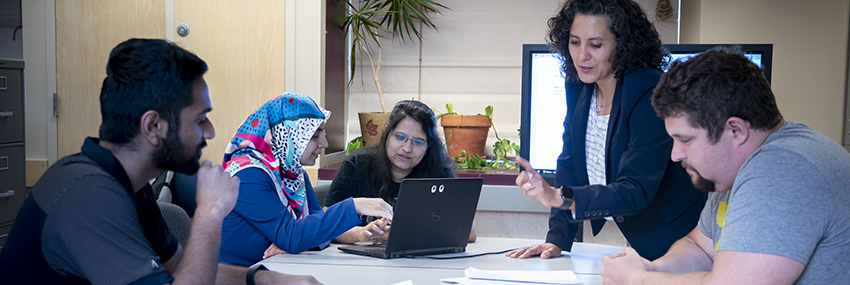
Greg Strimel, assistant professor of engineering-technology teacher education, collaborated with Sascha Harrell, director of workforce development and education for Purdue’s Indiana Next Generation Manufacturing Competitiveness Center (IN-MaC), on the creation of a long-term research project intended to study how industry and education can work together to change children’s perceptions about careers in manufacturing, and how giving students consistent access to Industry 4.0 technologies can impact their career choices.
Strimel also received a Purdue Exceptional Early Career Teaching Award for his work to develop the Polytechnic’s design and innovation minor.
Jin Wei-Kocsis, assistant professor of computer and information technology, is working to develop a data-driven resilient and cognitive networking management architecture by employing deep learning (DL), software-defined networking (SDN), and software-defined radio (SDR) technologies for NASA’s space exploration. Her NASA Early Career Faculty project aims to advance the autonomy, environment-awareness and intelligence of NASA’s deep space network and to improve the resilience and scalability of NASA space communication system.
Wei-Kocsis is also studying cybersecurity education in the age of artificial intelligence, collaborating with Baijian “Justin” Yang, professor of computer and information technology, and Tonglin Zhang.
“Recent research has demonstrated that artificial intelligence (AI) techniques can be manipulated, evaded, and misled,” said Wei-Kocsis. “While progress has been made to better understand the trustworthiness and security of AI techniques, little has been done to translate this knowledge to education and training. There is a critical need to foster a qualified cybersecurity workforce that understands the usefulness, limitations, and best practices of AI technologies in the cybersecurity domain.”
A focus on the use of technology in industry is common to every academic school and department in Purdue Polytechnic.
“Purdue Polytechnic prides itself for using and applying new and more effective ways of learning,” said Luciana Debs, assistant professor of construction management technology and co-leader of the FWL research impact area. “Human-technology interaction is integral to everything we learn and study, so our Future Work and Learning research impact area is really at the core of what Purdue Polytechnic does.”
Additional information
- Future Work and Learning research explores maximizing human potential in the workplace (2018 summary)
- Purdue Polytechnic Strategic Research Impact Area: Future Work and Learning
- Purdue Polytechnic’s Strategic Research Impact Areas
- Purdue Polytechnic Office of Research
- Purdue Polytechnic’s Holistic Safety and Security research projects receive national attention, funding (1 of 3 in this series)
- Realizing the Digital Enterprise researchers pair technology, social responsibility (3 of 3 in this series)
- Polytechnic researchers work with Toolbox Dialog Initiative to improve cross-disciplinary collaboration
- Awareness and access: A research approach to changing perceptions and building Indiana’s future manufacturing workforce
- Strimel earns 2021 Exceptional Early Career Teaching Award
- Combating pilot fatigue in collegiate aviators
- CGT professor, colleagues awarded $15 million geospatial science research grant
- Paul Asunda
- Luciana Debs
- Mesut Akdere
- Lisa Bosman
- Vetria Byrd
- Julius Keller
- Alejandra Magana
- Greg Strimel
- Jin Wei-Kocsis
- Baijian Yang
- Sunghwan Lee
- Jason Ostanek
- José Garcia-Bravo
- Walter Leon-Salas
- Nathalie Duval-Couetil
Recent News
MIT Technology Review
- Newsletters
An OpenAI spinoff has built an AI model that helps robots learn tasks like humans
But can it graduate from the lab to the warehouse floor?
- James O'Donnell archive page
In the summer of 2021, OpenAI quietly shuttered its robotics team, announcing that progress was being stifled by a lack of data necessary to train robots in how to move and reason using artificial intelligence.
Now three of OpenAI’s early research scientists say the startup they spun off in 2017, called Covariant, has solved that problem and unveiled a system that combines the reasoning skills of large language models with the physical dexterity of an advanced robot.
The new model, called RFM-1, was trained on years of data collected from Covariant’s small fleet of item-picking robots that customers like Crate & Barrel and Bonprix use in warehouses around the world, as well as words and videos from the internet. In the coming months, the model will be released to Covariant customers. The company hopes the system will become more capable and efficient as it’s deployed in the real world.
So what can it do? In a demonstration I attended last week, Covariant cofounders Peter Chen and Pieter Abbeel showed me how users can prompt the model using five different types of input: text, images, video, robot instructions, and measurements.
For example, show it an image of a bin filled with sports equipment, and tell it to pick up the pack of tennis balls. The robot can then grab the item, generate an image of what the bin will look like after the tennis balls are gone, or create a video showing a bird’s-eye view of how the robot will look doing the task.
If the model predicts it won’t be able to properly grasp the item, it might even type back, “I can’t get a good grip. Do you have any tips?” A response could advise it to use a specific number of the suction cups on its arms to give it better a grasp—eight versus six, for example.
This represents a leap forward, Chen told me, in robots that can adapt to their environment using training data rather than the complex, task-specific code that powered the previous generation of industrial robots. It’s also a step toward worksites where managers can issue instructions in human language without concern for the limitations of human labor. (“Pack 600 meal-prep kits for red pepper pasta using the following recipe. Take no breaks!”)
Lerrel Pinto, a researcher who runs the general-purpose robotics and AI lab at New York University and has no ties to Covariant, says that even though roboticists have built basic multimodal robots before and used them in lab settings, deploying one at scale that’s able to communicate in this many modes marks an impressive feat for the company.
To outpace its competitors, Covariant will have to get its hands on enough data for the robot to become useful in the wild, Pinto told me. Warehouse floors and loading docks are where it will be put to the test, constantly interacting with new instructions, people, objects, and environments.
“The groups which are going to train good models are going to be the ones that have either access to already large amounts of robot data or capabilities to generate those data,” he says.
Covariant says the model has a “human-like” ability to reason, but it has its limitations. During the demonstration, in which I could see a live feed of a Covariant robot as well as a chat window to communicate with it, Chen invited me to prompt the model with anything I wanted. When I asked the robot to “return the banana to Tote Two,” it struggled with retracing its steps, leading it to pick up a sponge, then an apple, then a host of other items before it finally accomplished the banana task.
“It doesn’t understand the new concept,” Chen said by way of explanation, “but it’s a good example—it might not work well yet in the places where you don’t have good training data.”
The company’s new model embodies a paradigm shift rippling through the robotics world. Rather than teaching a robot how the world works manually, through instructions like physics equations and code, researchers are teaching it in the same way humans learn: through millions of observations.
The result “really can act as a very effective flexible brain to solve arbitrary robot tasks,” Chen said.
The playing field of companies using AI to power more nimble robotic systems is likely to grow crowded this year. Earlier this month, the humanoid-robotics startup Figure AI announced it would be partnering with OpenAI and raised $675 million from tech giants like Nvidia and Microsoft. Marc Raibert, the founder of Boston Dynamics, recently started an initiative to better integrate AI into robotics.
This means that advancements in machine learning will likely start translating to advancements in robotics. However, some issues remain unresolved. If large language models continue to be trained on millions of words without compensating the authors of those words, perhaps it will be expected that robotics models will also be trained on videos without paying their creators. And if language models hallucinate and perpetuate biases, what equivalents will surface in robotics?
In the meantime, Covariant will push forward, keen on having RFM-1 continually learn and refine. Eventually, the researchers aim to have the robot train on videos that the model itself creates—the type of meta-learning that not only makes my head spin but also sparks concern about what will happen if errors made by the model compound themselves. But with such a hunger for more training data, researchers see it almost as inevitable.
Artificial intelligence
Large language models can do jaw-dropping things. but nobody knows exactly why..
And that's a problem. Figuring it out is one of the biggest scientific puzzles of our time and a crucial step towards controlling more powerful future models.
- Will Douglas Heaven archive page
The AI Act is done. Here’s what will (and won’t) change
The hard work starts now.
- Melissa Heikkilä archive page
Advancing AI innovation with cutting-edge solutions
Power your business transformation with proven AI services and infrastructure.
- Lachlan Ainley archive page
I used generative AI to turn my story into a comic—and you can too
By pulling together several different generative models into an easy-to-use package controlled with the push of a button, Lore Machine heralds the arrival of one-click AI.
Stay connected
Get the latest updates from mit technology review.
Discover special offers, top stories, upcoming events, and more.
Thank you for submitting your email!
It looks like something went wrong.
We’re having trouble saving your preferences. Try refreshing this page and updating them one more time. If you continue to get this message, reach out to us at [email protected] with a list of newsletters you’d like to receive.
An official website of the United States government
Here's how you know
Official websites use .gov A .gov website belongs to an official government organization in the United States.
Secure .gov websites use HTTPS. A lock ( Lock Locked padlock ) or https:// means you've safely connected to the .gov website. Share sensitive information only on official, secure websites.

Innovative Technology Experiences for Students and Teachers Resource Center (ITEST RC)
Status: archived, important information for proposers.
All proposals must be submitted in accordance with the requirements specified in this funding opportunity and in the NSF Proposal & Award Policies & Procedures Guide (PAPPG) that is in effect for the relevant due date to which the proposal is being submitted. It is the responsibility of the proposer to ensure that the proposal meets these requirements. Submitting a proposal prior to a specified deadline does not negate this requirement.
Supports the development of a resource center that will actualize strategies for equity in STEM education, partnerships for preparation in STEM careers, and innovative uses of technologies in teaching and learning for pre-K-12 students.
The Innovative Technology Experiences for Students and Teachers (ITEST) program is an applied research and development program that seeks to actualize a diverse future STEM (science, technology, engineering, and mathematics) and ICT (information and communication technologies) workforce that is prepared to meet pressing local, societal, and global challenges. Because STEM and ICT careers increasingly rely on technologies and computing, the ITEST program funds projects that engage youth, from pre-kindergarten through high school, and pre-K-12 educators in equitable, innovative technology learning and education experiences within and across STEM disciplines in formal or informal settings. These projects build youths’ interest and knowledge in STEM careers, and they prioritize the full inclusion of all groups to include those that have been underrepresented, underserved, or excluded from STEM educational opportunities. This ensures that NSF is better postured to leverage the full spectrum of diverse talent across the country.
This solicitation calls for a Resource Center for the ITEST program. The Resource Center will support diverse, multi-sector stakeholders in actualizing the three pillars of ITEST: (1) strategies for equity in STEM education, (2) partnerships for career and workforce preparation, and (3) innovative use of technologies in teaching and learning. It is expected that this Resource Center will facilitate individual and collective dialogue, reflection, and action relative to these pillars, while supporting stakeholders in the conceptualization, actualization, and communication of ITEST projects.
Updates and announcements
Itest: resource center solicitation webinar, program contacts, awards made through this program, organization(s).
- Directorate for STEM Education (EDU)
- Division of Research on Learning in Formal and Informal Settings (EDU/DRL)
Advanced science. Applied technology.

- SwRI leads airborne, ground-based 2024 eclipse observation projects
- Press Releases
March 24, 2024 — Southwest Research Institute is leading two groundbreaking experiments — on the ground and in the air — to collect astronomical data from the total solar eclipse that will shadow a large swath of the United States on April 8, 2024. SwRI’s Dr. Amir Caspi leads the Citizen Continental-America Telescopic Eclipse (CATE) 2024 experiment, a broad scientific outreach initiative funded by the National Science Foundation (NSF) and NASA, that will engage community participants to make a continuous 60-minute high-resolution movie during the April 8 solar eclipse. Caspi also leads an investigation that will use NASA’s WB-57F research aircraft to chase the eclipse shadow.
“Total solar eclipses are unique opportunities for scientists to study the hot atmosphere above the Sun’s visible surface,” said Caspi, principal investigator of both projects. “The faint light from the corona is usually overpowered by the intense brightness of the Sun itself. Total solar eclipses allow scientists to view the complex and dynamic outer atmosphere in ways that aren’t possible or practical by any other means, opening new windows into our understanding of the solar corona.”
CATE 2024 will use a network of 35 teams of community participants, or “citizen scientists,” representing local communities along the eclipse path, deploying a “bucket brigade” of small telescopes — from the Texas-Mexico border to Maine — following the eclipse’s shadow path. This next-generation project builds on the experience of the first Citizen CATE experiment in 2017, led by Matt Penn of the National Solar Observatory, which used 68 stations to observe the August 2017 total solar eclipse that crossed the continental United States. CATE 2024 expands the scientific objectives by measuring polarized light and engages with new teams across this year’s eclipse path.
Additionally, for the second time, Caspi leads a project to observe an eclipse with NASA’s WB-57F research aircraft. In 2017, he led the first solar observations using these aircraft, outfitted with telescopes mounted in the aircraft nose cone. In 2024, Caspi’s team will deploy a new suite of sensitive, high-speed, visible-light and infrared imagers, built by NASA’s Langley Research Center, to observe the corona during the eclipse at 50,000 feet. These high-altitude observations both provide measurements that can’t be made from the ground and avoid any weather-related risks. The WB-57F aircraft will also carry two other experiments, from the University of Hawaii and Virginia Tech, and Caspi serves as the mission scientist, coordinating between NASA and the experiment leads.
“Both projects will require an enormous effort and precise timing to get the data we need,” Caspi said. “I am honored to be part of such exceptionally talented and professional teams, and grateful for everyone’s dedication and hard work.”
Looking at complex motion in the solar corona, at new wavelengths and with new polarization measurements, will help scientists understand why it is so hot. The corona is millions of degrees Celsius, hundreds of times hotter than the visible surface below, which is a longstanding scientific mystery. The corona is also one of the major sources of eruptions that cause geomagnetic storms at Earth. These phenomena damage satellites, cause power grid blackouts and disrupt communication and GPS signals, so it’s important to better understand them.
“The airborne platforms guarantee perfect observing conditions, above any weather and more than 90 percent of Earth’s atmosphere, which can affect image quality,” said SwRI co-investigator Dr. Dan Seaton, who serves as the science lead for both projects. “Combining the airborne mobile data with the CATE 2024 hour-long string of observations will provide a more complete picture of the Sun’s mysterious corona.”
The SwRI-led airborne team includes scientists from the National Center for Atmospheric Research High Altitude Observatory, NASA Langley Research Center, and Predictive Sciences Inc., with collaborators at the Smithsonian Astrophysical Observatory. The SwRI-led CATE 2024 project, funded by NSF and NASA, includes scientists from the National Center for Atmospheric Research, the National Solar Observatory, the University of Colorado, and the Space Science Institute, with collaborators at New Mexico State University and the Livelihoods Knowledge Exchange Network, community leaders at Rice University, Indiana University Bloomington, and the University of Maine, and over 100 community participants in 35 communities along the eclipse path.
Interested parties can find more information about both projects: https://eclipse.boulder.swri.edu .
For more information, contact Deb Schmid , +1 210 522 2254 , Communications Department, Southwest Research Institute, 6220 Culebra Road, San Antonio, TX 78238-5166.
- Bienvenidos
Five Key Insights Into Consumers’ Use Of Generative AI
Thomas Husson , VP, Principal Analyst
As is often the case with poorly understood tech that promises to change the world, consumers worry about its ethics and human impact, yet a vast majority of these skeptics will use (and love) generative AI in 2024, whether they know it or not. Like it or not, know it or not, genAI will seep into people’s lives seamlessly and invisibly.
How is consumer use of generative AI expanding? Tech companies are embedding genAI capabilities in their platforms and tools and in the apps and products that people use every day: Adobe Photoshop, Google’s Gemini or Circle to Search, Microsoft’s LinkedIn, Samsung’s Galaxy S24, and many more. In November last year, Forrester predicted that half of global firms will experiment with customer-facing genAI.
While companies race to incorporate AI internally and externally, consumer use of genAI is still in its infancy. Consumers are apprehensive: Although they see the utility of genAI, they worry about its ethical implications. My colleague Audrey Chee-Read and I just published a brand-new report, The State Of Consumer Usage Of Generative AI, 2024 , and have been investigating consumers’ genAI usage and attitudes. Here are a few trends to note:
- US consumers are ahead of those in other countries due to sluggish regulations. For genAI, consumer usage is higher and consumer attitudes are more positive in the US than in the UK, France, Germany, or Italy. Countries in the EU are introducing and enforcing new rules and regulations so that organizations adopt AI technology in reliable ways, while the US does not have any federal regulations around consumers’ AI usage. Large language models (LLMs) are also based on available training data, and much of that data is in English, inherently making the output of genAI platforms more effective for English-dominant countries.
- LLMs dominate genAI usage, with use focused on search-related tasks. Tools such as Bing Chat, ChatGPT, Google’s Gemini (formerly Bard), OpenAI’s DALL·E, and Snapchat’s AI chatbot dominate usage, but there are many smaller, unbranded native genAI tools in major platforms that consumers may not attribute to genAI technology, such as WhatsApp’s AI stickers or Spotify’s podcast translation.
- Consumers’ knowledge of genAI will continue to be disjointed. GenAI use cases largely dominate consumers’ understanding of it, but most consumers have not actually used genAI. A large volume of respondents fall into the “don’t know” category in response to questions about it. Among those who claim some understanding, however, one group is focused on the human-imitation nature of the technology, another is aimed at understanding its involvement in the creation of new information, content, and data, and a third group relayed negative associations rather than understanding.
- Consumers lack trust in genAI’s output quality and use by companies. Consumers lack trust in genAI in two main ways: 1) the accuracy of the results that the technology produces and 2) the ways that companies use the technology and data that consumers enter. Based on Forrester’s December 2023 Consumer Pulse Survey of online adults who had heard of genAI, only 29% agreed that they would trust information from genAI. Even more significant is concern about transparency, with 73% of genAI-aware online adults agreeing that companies should disclose when they use the technology to interact with them.
- Consumers see the utility of genAI but are torn about its potential effects. Consumers are split about how genAI will impact the future. Many appreciate its utility. Among online adults in Forrester’s December 2023 Consumer Pulse Survey who had heard of genAI, 50% agreed that genAI would make it easier to find information online and 43% agreed that genAI would make it easier to learn new things. There is less consensus, though, about the technology’s long-term effects: 45% of online adults agreed that genAI poses a serious threat to society.
My colleague Jay Pattisall is working on a new piece of research on how brands will leverage genAI and how they are actively building brand AI models (stay tuned!). Moving forward, brands will be able to automatically create custom content conversations with consumers, as per this excellent cartoon from Tom Fishburne (thanks, Tom, for allowing me to share your cartoon, and for anyone who does not follow his work, I recommend that they take a look at the Marketoonist ):
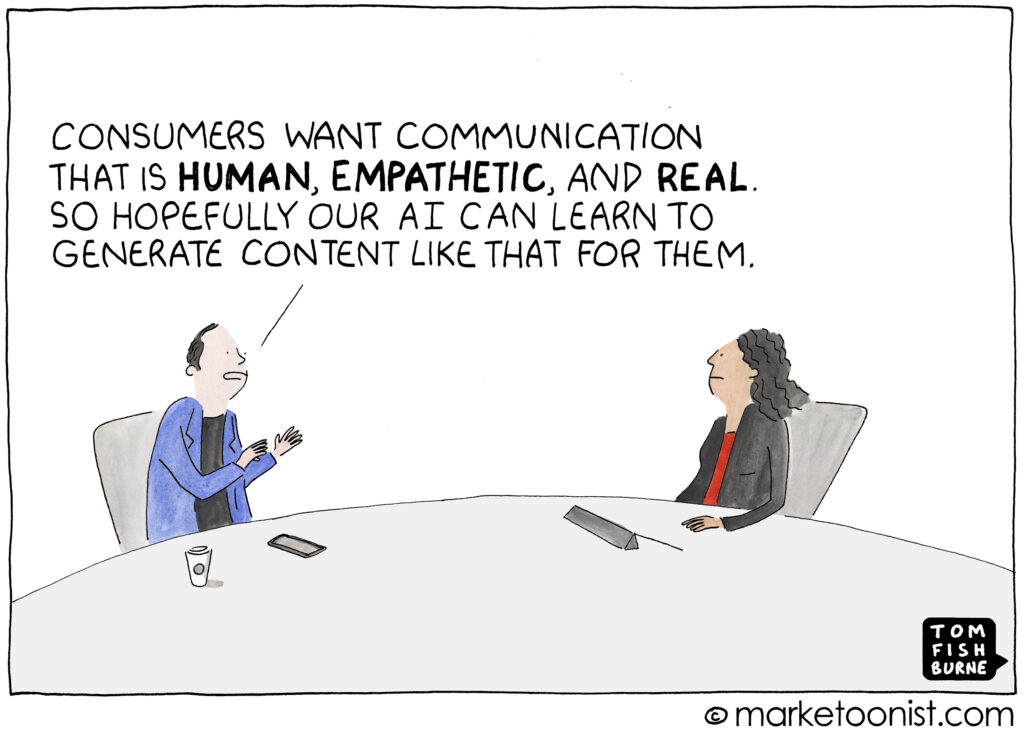
Clients wanting to find out more on consumers’ perceptions of genAI and discuss implications for their business can read the full report here or schedule a guidance session.
We are also working on a new piece of research that looks into how genAI will change relationships with brands and consumers. Will brands become conversational through genAI-powered chatbots? What does that really mean? Is this a long-lasting solution in the form of a personal digital assistant — some sort of “algorithm of you” — that can interact with brands on your behalf? What are the risks of brand disintermediation?
If you’re interested in sharing your point of view or want to brief us on consumer-centric genAI projects that you’re working on, feel free to contact us .
Related Links
- Generative AI: A Pragmatic Guide For B2B CMOs
- Age of the Customer
- B2C Marketing
- customer experience
- digital business
- Generative AI
- Responsible AI

Thanks for signing up.
Stay tuned for updates from the Forrester blogs.
Avoid Zombie AI Projects With Our Best Practices
Download our ai myths and best practices guide. learn how to avoid missteps, prioritize value, and move ai projects out of limbo with quick wins., wasm today, ai tomorrow: kubecon expands its reach, your employees aren’t ready for ai — prepare them with aiq, get the insights at work newsletter, help us improve.

IMAGES
VIDEO
COMMENTS
Technology topics for research papers below are very easy to investigate, so you will surely find a bunch of academic resources. Exploring adaptive learning systems in online education. Role of technology in modern archaeology. Impact of immersive technology on journalism. The rise of telehealth services.
Relationships and Media. 7. War. 8. Information and Communication Tech. 9. Computer Science and Robotics. Researching technology can involve looking at how it solves problems, creates new problems, and how interaction with technology has changed humankind.
Mineral, a project that was completed in 2020, brings together plant breeders and growers across Argentina, Canada, the United States and South Africa to test new models for sustainable farming using AI and machine learning. At Mineral's core is an electric-powered rover that collects granular data about soil health and crop development.
Our teams leverage research developments to build tools and technology that benefit billions of people. We regularly open-source projects with the broader research community and apply our developments to Google products. Some of our projects. Researchers at Google are working in many domains.
In 2021, MIT researchers made advances toward fusion energy, confirmed Stephen Hawking's black hole theorem, developed a Covid-detecting face mask, and created a programmable fiber. All were among the year's top research stories on MIT News. Credits. Images by: (clockwise from top left: Gretchen Ertl; Felice Frankel; Simulating eXtreme ...
New research on technological innovation from Harvard Business School faculty on issues including using data mining to improve productivity, why business IT innovation is so difficult, and the business implications of the technology revolution.
Technologies are becoming increasingly complicated and increasingly interconnected. Cars, airplanes, medical devices, financial transactions, and electricity systems all rely on more computer software than they ever have before, making them seem both harder to understand and, in some cases, harder to control. Government and corporate surveillance of individuals and information processing ...
Technology as a major determinant of organizational form and structure has been well acknowledged by academics for a long time (Thompson and Bates 1957; Woodward 1965; Scott 1992).Following a significant decline of interest in this relationship until the mid-1990s (Zammuto et al. 2007), innovations in information technologies (IT) and the rise of pre-internet technologies have revitalized its ...
Finding and choosing a strong research topic is the critical first step when it comes to crafting a high-quality dissertation, thesis or research project. If you've landed on this post, chances are you're looking for a computer science-related research topic, but aren't sure where to start.Here, we'll explore a variety of CompSci & IT-related research ideas and topic thought-starters ...
Gilbert suggests that leaders take their cues from their team when adopting tech tools such as Slack and WhatsApp. He says that many younger researchers view e-mail as formal and cumbersome ...
Artificial intelligence technology research topics. We started 2023 with M3GAN's box office success, and now we're fascinated (or horrified) with ChatGPT, voice cloning, and deepfakes. While people have discussed artificial intelligence for ages, recent advances have really pushed this topic to the front of our minds.
Technology News. Read the latest technology news on SciTechDaily, your comprehensive source for the latest breakthroughs, trends, and innovations shaping the world of technology. We bring you up-to-date insights on a wide array of topics, from cutting-edge advancements in artificial intelligence and robotics to the latest in green technologies ...
Ghost-USB-Honeypot project. This effort, focused on nixing malware like Flame that spreads from computer to computer via USB storage drives, got its start based on research from Sebastian Poeplau ...
Blockchain technology can be integrated into mobile multi-robot systems. This Perspective overviews the initial achievements, open challenges and research directions in the field of blockchain ...
Information technology is the design and implementation of computer networks for data processing and communication. This includes designing the hardware for processing information and connecting ...
Educational Technology Topics. Perhaps, you're interested in a topic that touches on education and technology. In that case, consider these ideas for your research project. Incorporating computational thinking in education. How technology is changing the classroom practice. How technology changes learning outcomes.
Americans' Social Media Use. YouTube and Facebook are by far the most used online platforms among U.S. adults. But TikTok's user base has grown significantly in recent years: 33% of U.S. adults now say they use it, up from 21% in 2021. Read our fact sheets: Social Media Fact Sheet | Internet/Broadband Fact Sheet | Mobile Fact Sheet.
From elementary schooling to doctoral-level education, technology has become an integral part of the learning process in and out of the classroom. With the implementation of the Common Core Learning Standards, the skills required for research are more valuable than ever, for they are required to succeed in a college setting, as well as in the ...
every day. Recent progress in the areas of Artificial Intelligence (AI) and Machine Learning (ML) are tremendous. Almost monthly, we see reports announcing breakthroughs in different technological aspects of AI. As an organization focussing on research and development, we can look back on an increasing number of research projects.
The MIT Jameel World Education Lab has awarded $917,526 in Education Innovation Grants to support 14 research projects exploring a range of topics, including electrical engineering, extended reality, physical movement, and ecological sustainability. The grants will support researchers from 11 departments, labs, and centers across MIT. "Our Education Innovation Grants support MIT research ...
The most recent nationally representative surveys of the Pew Internet Project show how immersed teens and young adults are in the tech environment and how tied they are to the mobile and social sides of it. Some 95% of teens ages 12-17 are online, 76% use social networking sites, and 77% have cell phones. Moreover, 96% of those ages 18-29 are ...
Incorporating new technology into your marketing research project can be a daunting task. You might be wondering how to seamlessly integrate innovative tools without disrupting your current workflow.
Since 2018, Purdue Polytechnic faculty have been collaborating to explore the intersection between learning and work within the context of technology. Through new approaches to education and workforce training and development, their ongoing "Future Work and Learning" research aims to empower employees to take charge of their careers and become active, successful professionals and members ...
For example, show it an image of a bin filled with sports equipment, and tell it to pick up the pack of tennis balls. The robot can then grab the item, generate an image of what the bin will look ...
Objective. Assess whether there is a need for guidance, changes to PCAOB standards, or other regulatory actions in light of the increased use of technology-based tools by auditors and preparers. This includes evaluating the role technology innovation plays in driving audit quality. Research from this project may give rise to individual standard ...
The Innovative Technology Experiences for Students and Teachers (ITEST) program is an applied research and development program that seeks to actualize a diverse future STEM (science, technology, engineering, and mathematics) and ICT (information and communication technologies) workforce that is prepared to meet pressing local, societal, and global challenges.
NVIDIA today announced Project GR00T, a general-purpose foundation model for humanoid robots, designed to further its work driving breakthroughs in robotics and embodied AI. ... Robots powered by GR00T, which stands for Generalist Robot 00 Technology, will be designed to understand natural language and emulate movements by observing human ...
Peter Dedon, a biological engineer at the Massachusetts Institute of Technology, adds, "We know [RNA] screws up, ... including all the modifications. As a result, NIEHS and the National Human Genome Research Institute (NHGRI) organized a workshop to explore ... the RNome project should document all the modifications in the RNA of a few well ...
The SwRI-led CATE 2024 project, funded by NSF and NASA, includes scientists from the National Center for Atmospheric Research, the National Solar Observatory, the University of Colorado, and the Space Science Institute, with collaborators at New Mexico State University and the Livelihoods Knowledge Exchange Network, community leaders at Rice ...
There is less consensus, though, about the technology's long-term effects: 45% of online adults agreed that genAI poses a serious threat to society. My colleague Jay Pattisall is working on a new piece of research on how brands will leverage genAI and how they are actively building brand AI models (stay tuned!).